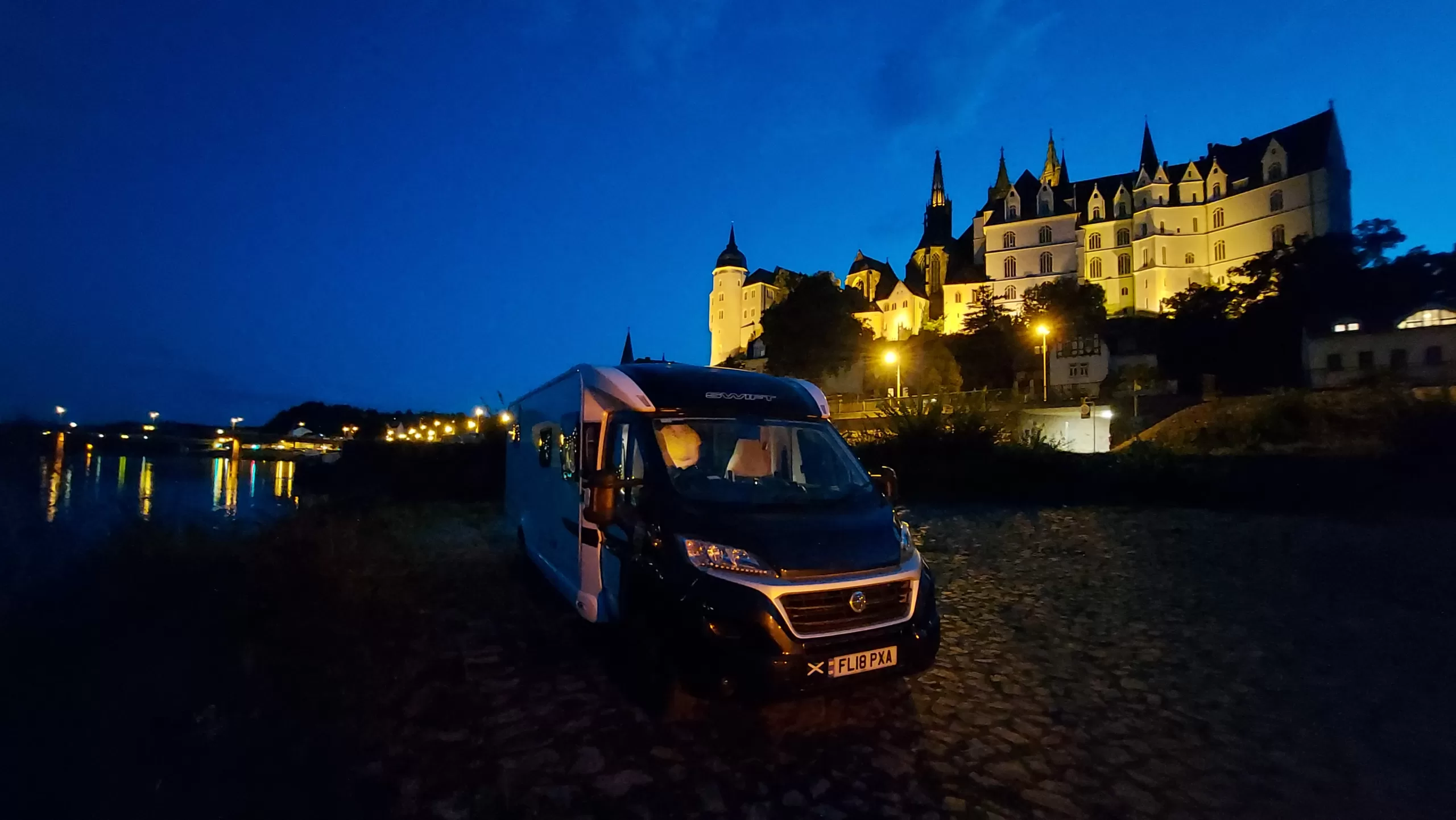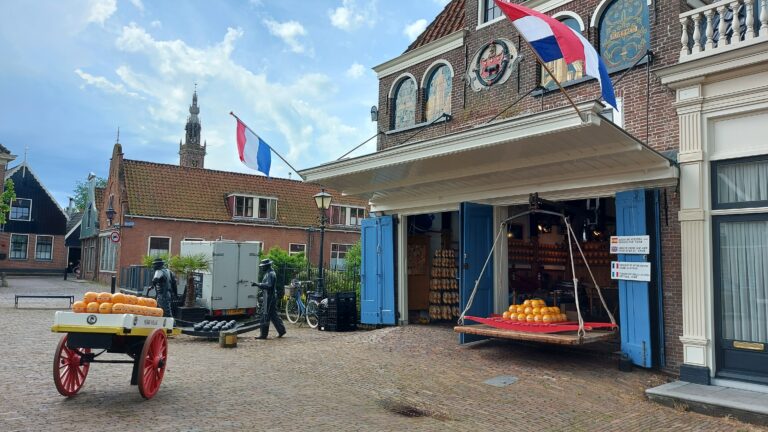ManVanNoPlan Visits Dresden, Meissen, Colditz, Beelitz, Berlin & Potsdam
ManVanNoPlan Visits Dresden, Meissen, Colditz, Beelitz, Berlin & Potsdam
Some of the following links are affiliate links. This means that, at zero cost to you, we will earn an affiliate commission from Amazon if you click through the link and finalise a
Day 54 – Sunday 27th of August
Karpacz area to Dresden (52.2336500, 12.9850100) (175 Miles)
Today we are leaving Poland and heading back into Germany to visit some towns, cities and areas of countryside we have not been to before. Before heading west however there was one building we wanted to see nearby so the satnav was set for the ‘Wang Church.’
The Wang Stave Church, or Mountain Church of Our Savior is a stave church located in Karpacz in the Karkonosze mountains in Poland. It was transferred to its present location from Vang in the Valdres region of Norway and re-erected in 1842 and today is Poland’s only stave church and a notable tourist attraction.
Unfortunately, we soon abandoned the journey as the route the satnav was proposing was too narrow for Bessie, and The Navigator thought it would be closed to tourists in favour of the Sunday morning service so I reset the satnav for Dresden and set off. Here are a couple of pictures from the Internet to show what we missed.
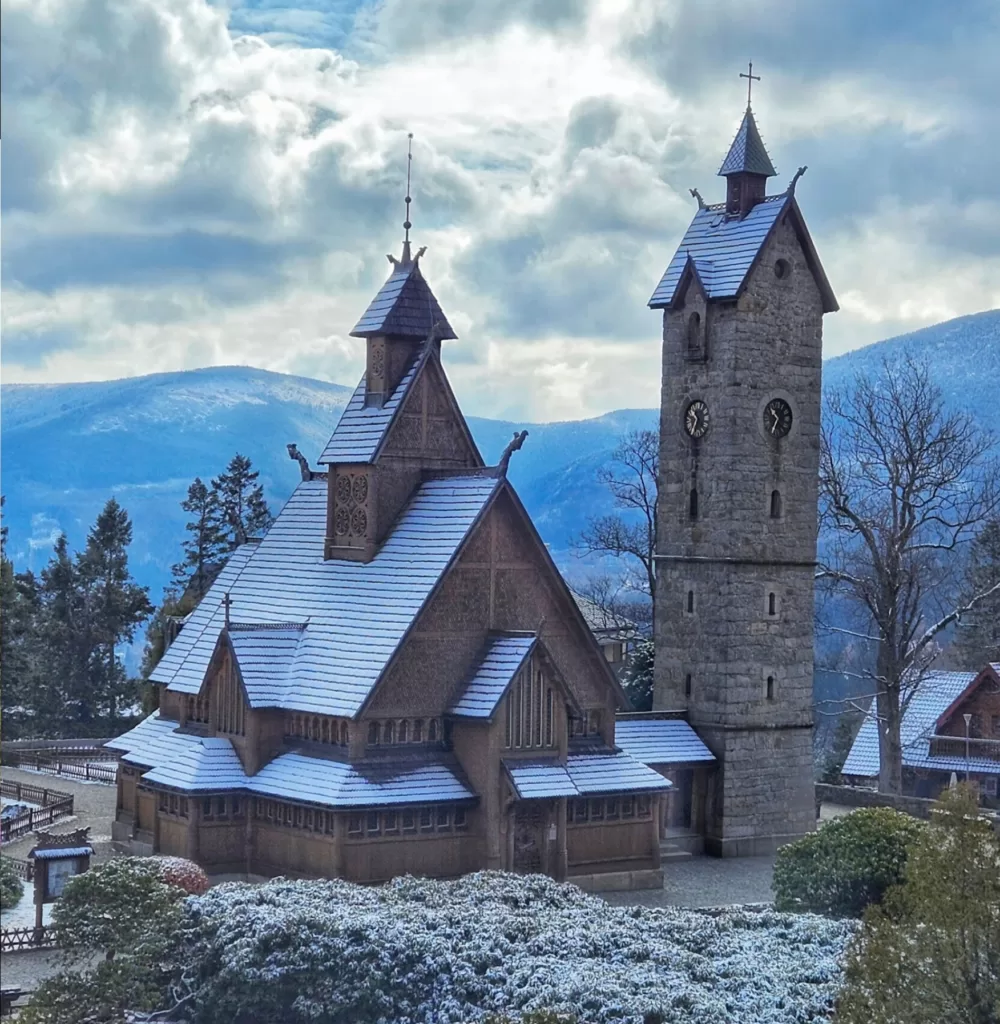
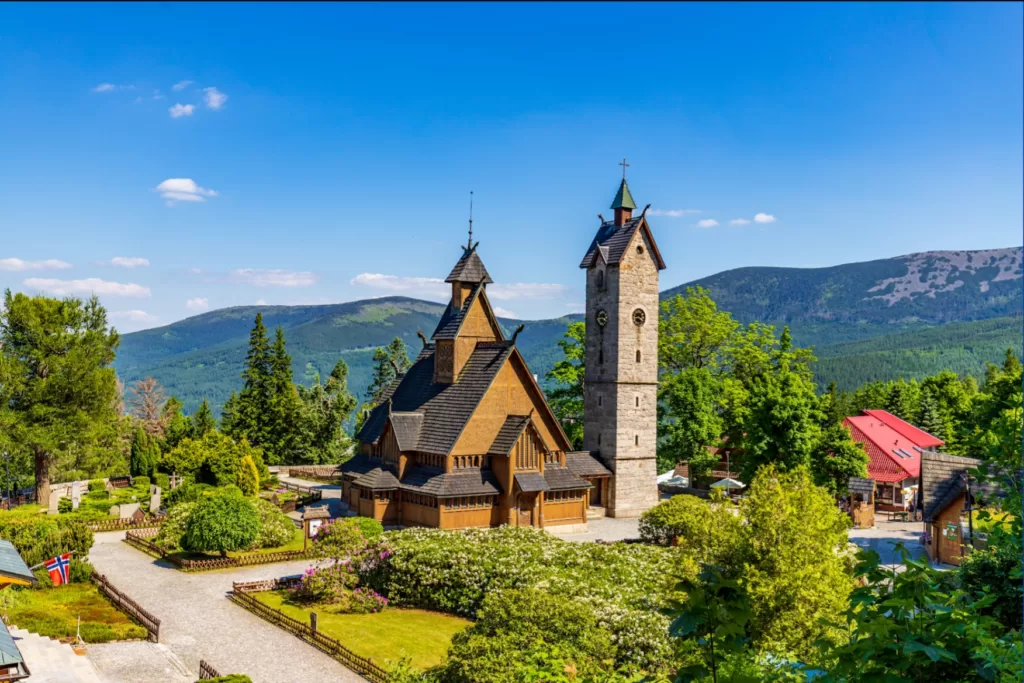
It almost defies belief that this wooden structure could be dismantled in Norway and transported to southern Poland in the late 1800s.
Within ten miles there was a police road block and all the traffic was diverted off the main road and onto country lanes. The Google Maps satnav had a hissy fit and kept wanting us to turn around and it did this for ages but I decided to follow the other diverted cars in front of us with the hope that they were heading in the same direction as us. There must have been an event on somewhere on our original route rather than an accident as we passed through a few small villages where every lane off our route was cordoned off and manned by a person in high-viz. We were now in a long line of traffic heading north and it took ages before we were able to head west but when we did it was on a motorway so we started to make good time again.
Choose A Fyne Editions Journal For Touring Germany…
There was one final mission to achieve before leaving Poland and that was to call at a Biedronka supermarket to spend the last of our Zloty notes on some of the products we had come to enjoy in Poland so we pulled off the motorway into a small town and completed the mission. We had lunch in the Biedronka car park and then carried on with the drive into Germany. There were three sections of road works which held us up as the traffic filtered into one lane and this, along with heavy intermittent rain slowed progress.
The stellplatz we were aiming for was behind a motorhome / caravan dealership and was fairly full when we arrived. We found a space, plugged in and hunkered down as it was raining heavily.
Day 55 – Monday 28th of August
Dresden (0 Miles)
Day 1
We woke to a grey day and more rain was forecast so instead of getting up and on the tram into Dresden when it was still dry we had a lazy morning and a walk around the dealership to see the shiny new vans on offer including a Morello and a Concord at over £ 350,000 each. After lunch when the rain was lashing down we went for the tram. Go figure as they say!
“Many people only know Dresden for one thing, the controversial bombing by the Royal Air Force (RAF) and the United States Army Air Forces (USAAF) between 13 and 15 February 1945. On the night of 13–14 February 1945, 773 RAF Lancaster bombers dropped 1,181.6 tons of incendiary bombs and 1,477.7 tons of high explosive bombs, targeting the rail yards at the centre of the city. The inner city of Dresden was largely destroyed. The high explosive bombs damaged buildings and exposed their wooden structures, while the incendiaries ignited them, denying their use by retreating German troops and refugees. Widely quoted Nazi propaganda reports claimed 200,000 deaths, but the German Dresden Historians’ Commission, made up of 13 prominent German historians, in an official 2010 report published after five years of research concluded that casualties numbered between 22,500 and 25,000.”
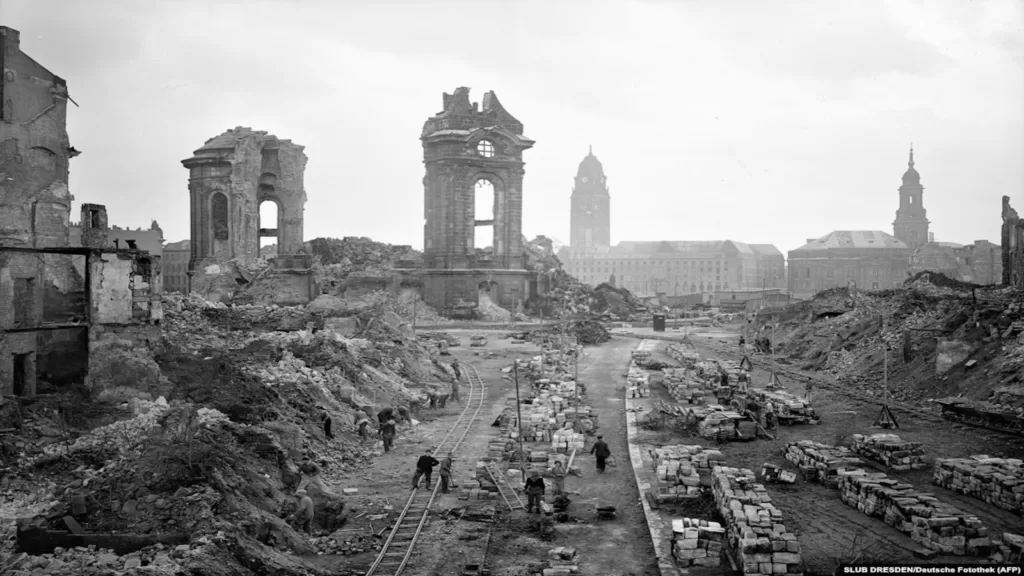

Get Ready for 2024 Touring…
Great Journals For Anyone With A Motorhome Or Campervan
The tram dropped us off beside the river Elbe and the first thing we saw was the famed statue covered in gold leaf of King August II dressed as a Roman Emperor riding on a horse. Even on a dull, grey, dreich day it shone brightly.
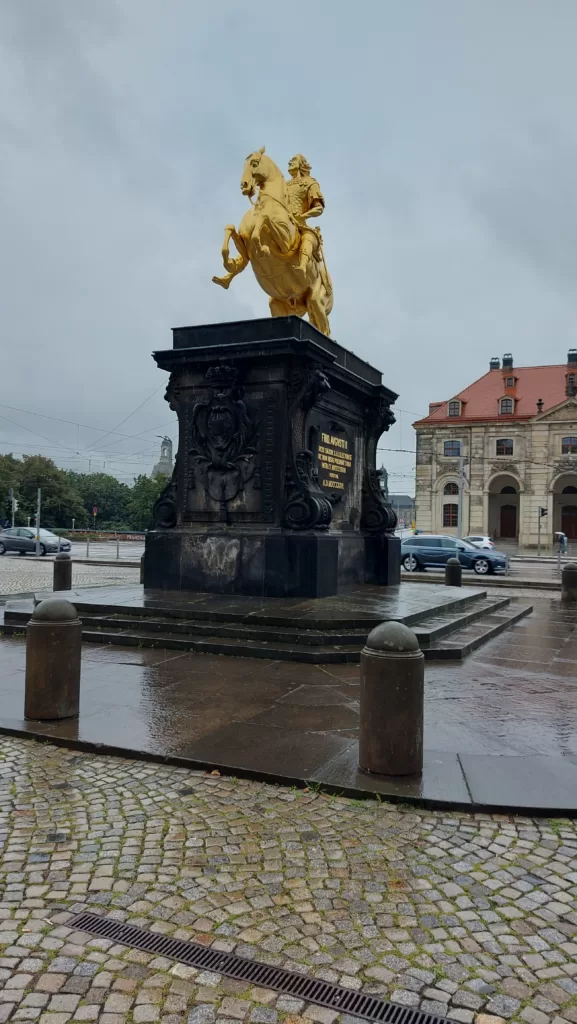
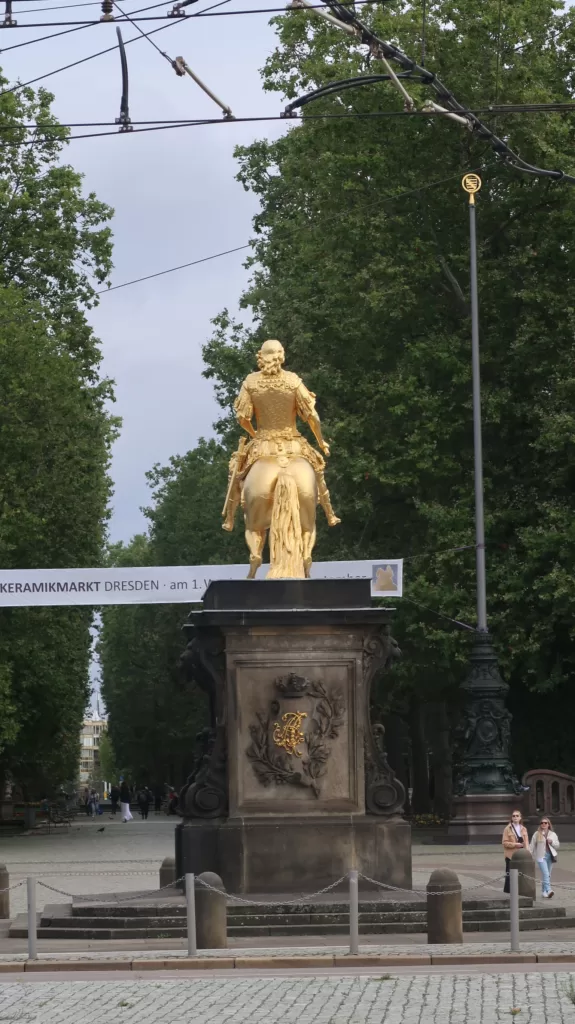
From there we walked up a tree lined pedestrian avenue interspersed with fountains. There was a large market hall half way up the avenue which we had a look around, as much to get out of the rain as anything else. We’ve seen better.
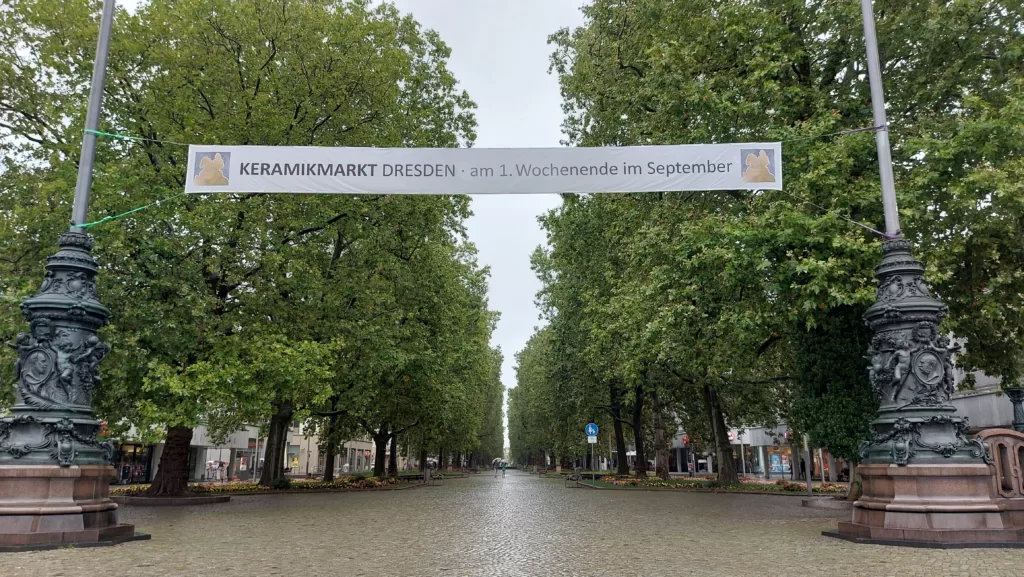
We crossed the Augustusbrücke, the Augustus Bridge, over the Elbe into the main part of the city and our first view of the impressive riverside buildings. It wasn’t a lot of fun walking about in the rain and eventually we succumbed to the shelter of a massive shopping mall, and you guessed it, had our afternoon tea and apple cake at a Tchibo.


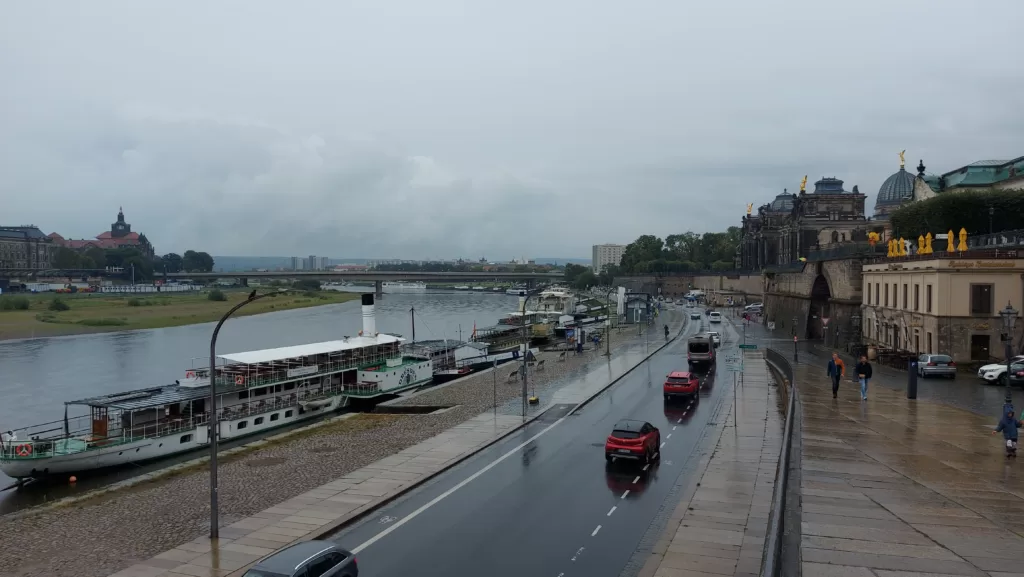
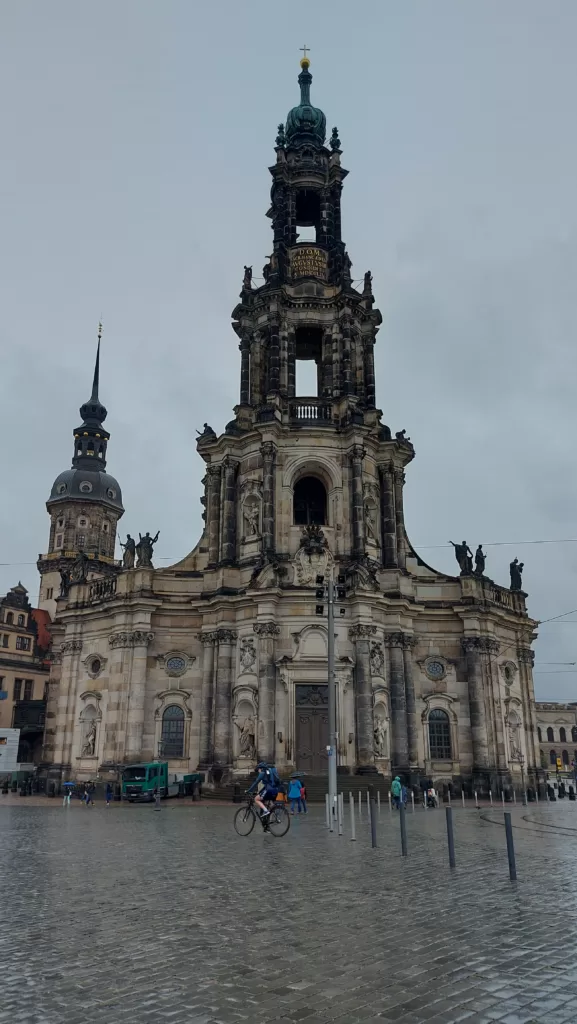
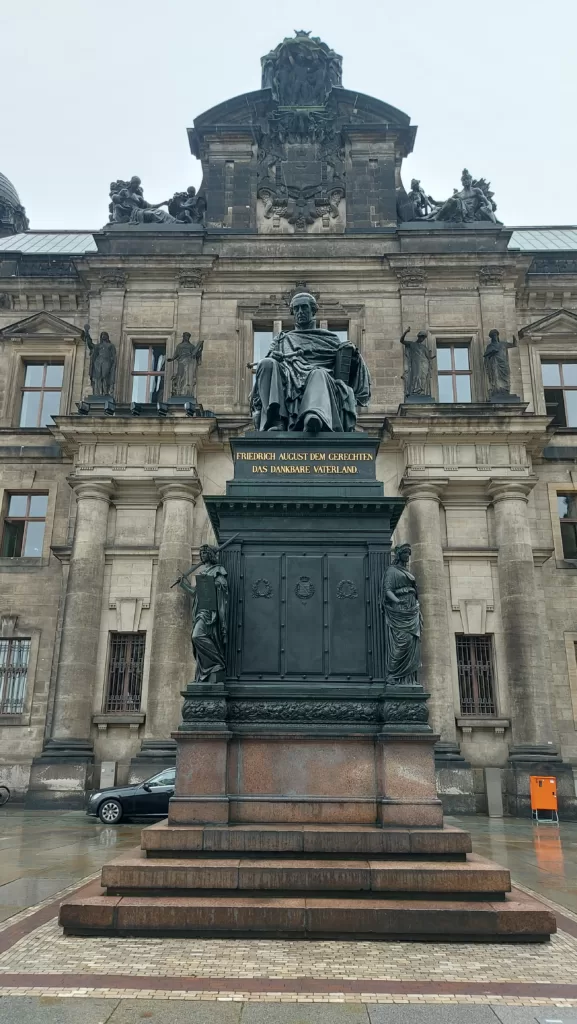
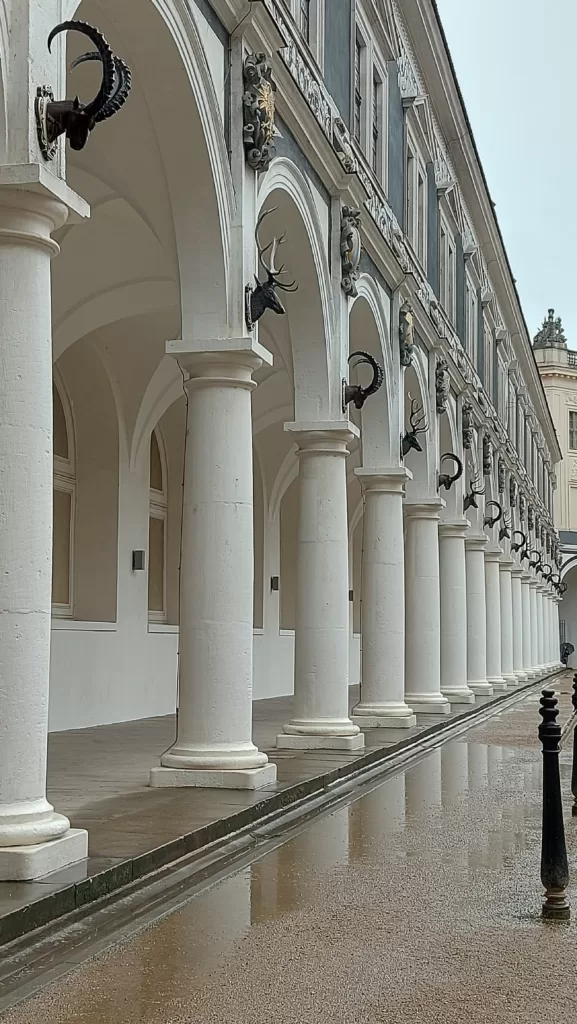

The Navigator was not at her best today, so we decided to cut our losses and head back to the dry and warmth of Bessie where we both had a late afternoon nap, something The Navigator never does, but she was zonked within minutes of her head hitting the pillow.
Day 56 – Tuesday 29th of August
Dresden (0 Miles)
Day 2
Two things thwarted our plans for a full sightseeing day in Dresden. First was the rain which showed no sign of relenting and second was The Navigator still not feeling well, so we decided to stay on the campsite all day in the hope that both of these issues would be better tomorrow.
Day 57 – Wednesday 30th of August
Dresden (0 Miles)
Day 3
Well, one issue was better, and it wasn’t The Navigator! The rain had stopped thankfully, and although there were no blue skies, it was warm and muggy. The Navigator was feeling marginally better but still not up to a day’s sightseeing so I took the tram into Dresden city centre on my own for a walkabout with the mission to find a chemist for a remedy for her ills.
Dresden doesn’t have the wow factor of other cities in Germany and obviously that has a lot to do with the heavy bombing of February 1945.
Another factor is that after the war Dresden found itself in East Germany and the rebuilding under the socialists was not as successful as Warsaw and other bomb damaged cities in Europe. It was rebuilt twice, once immediately after the war and then starting in the 1990s which tried to fix the many things socialism got wrong. What we see today is an attempt at creating a traditional market square and historic quarter with imposing buildings, but you don’t have to walk far before you see the bland post War buildings.
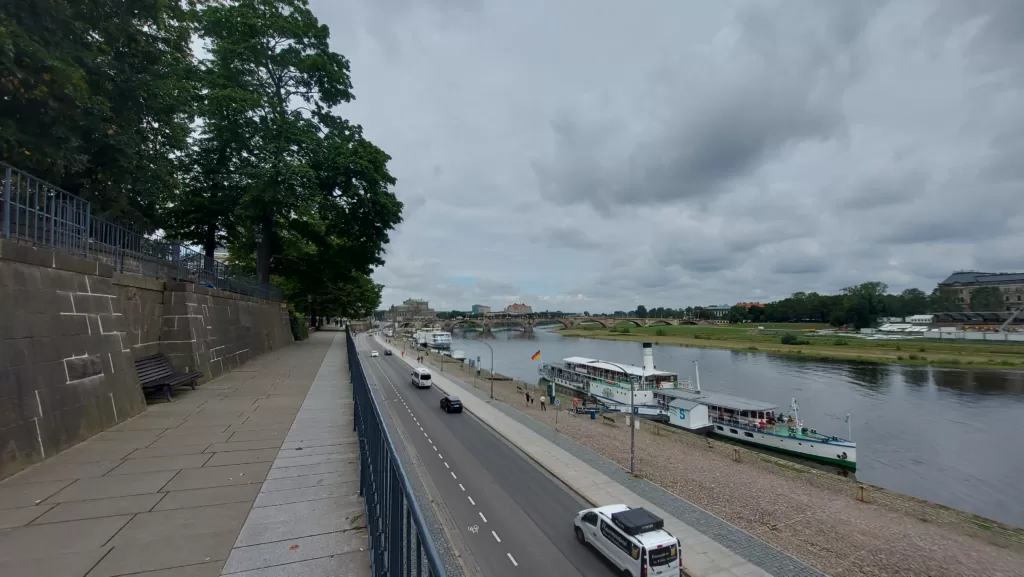

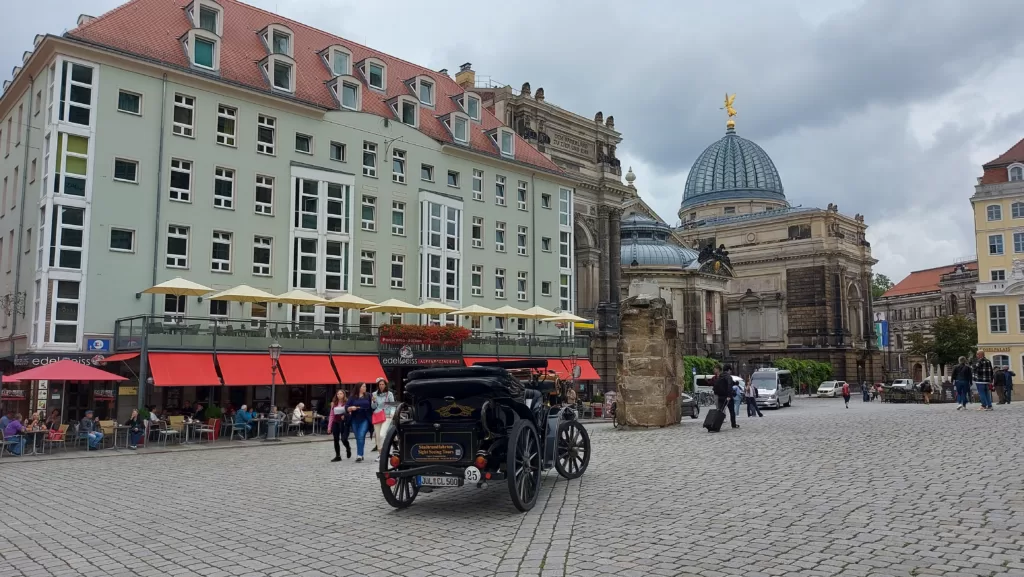
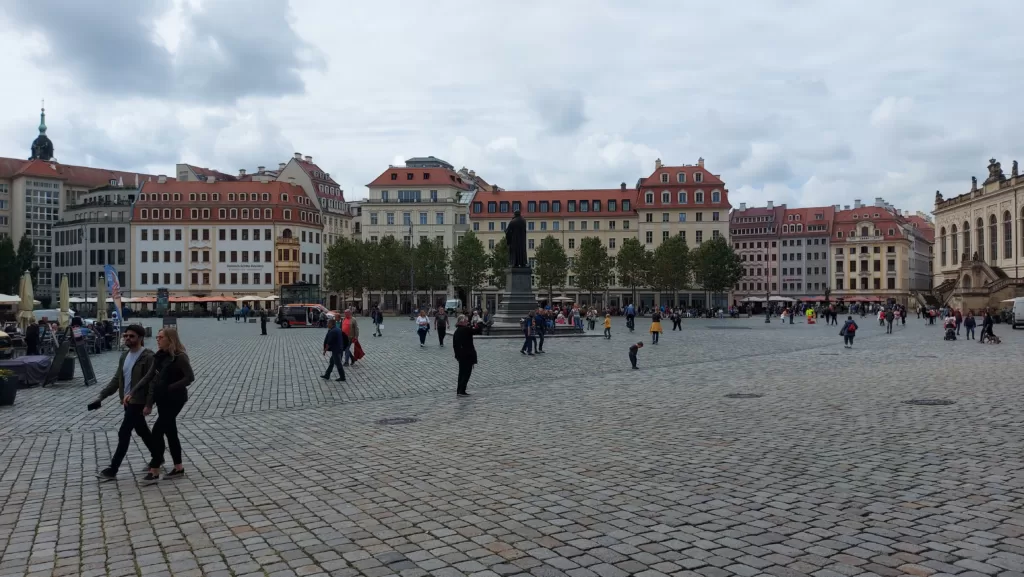
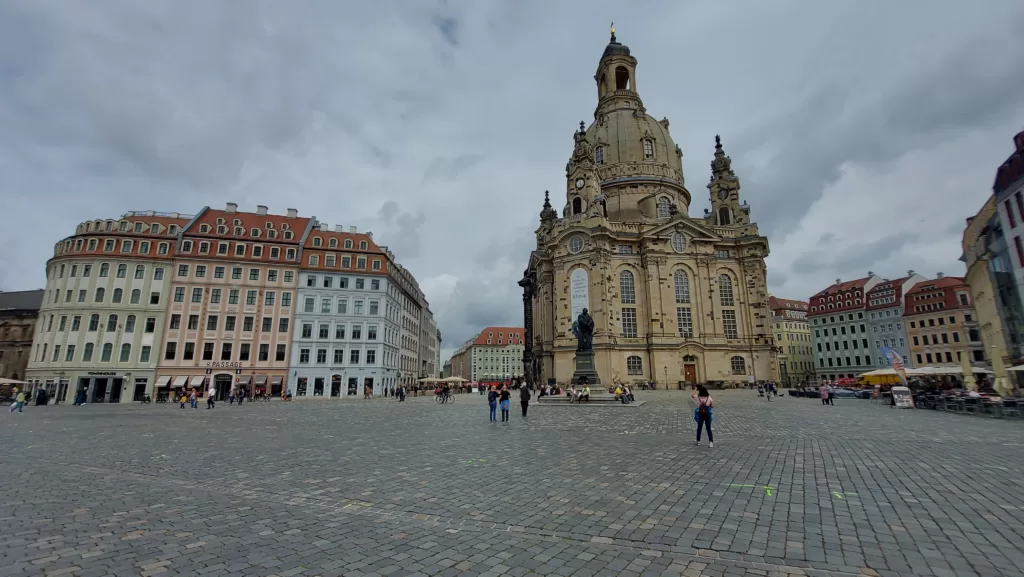
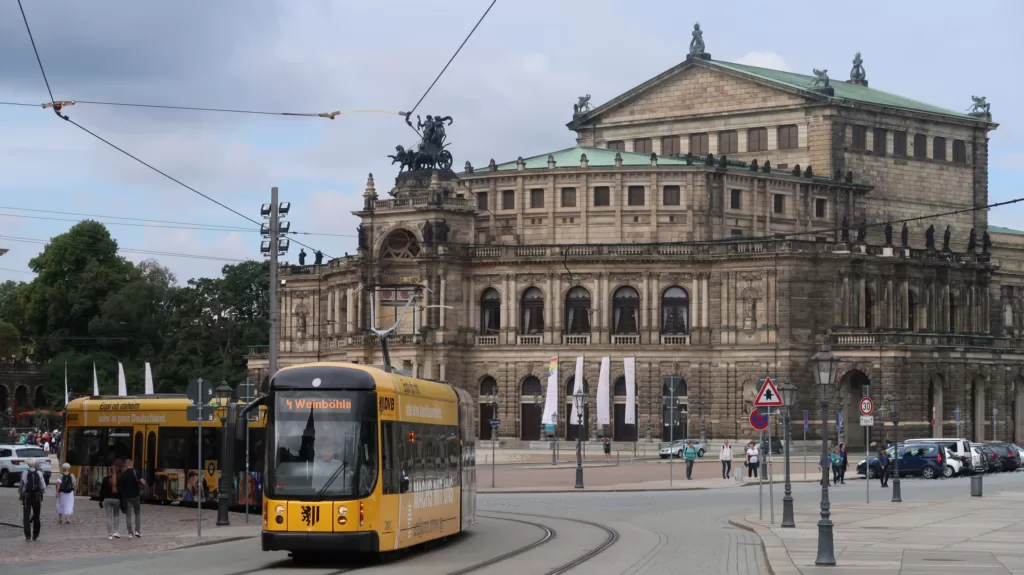

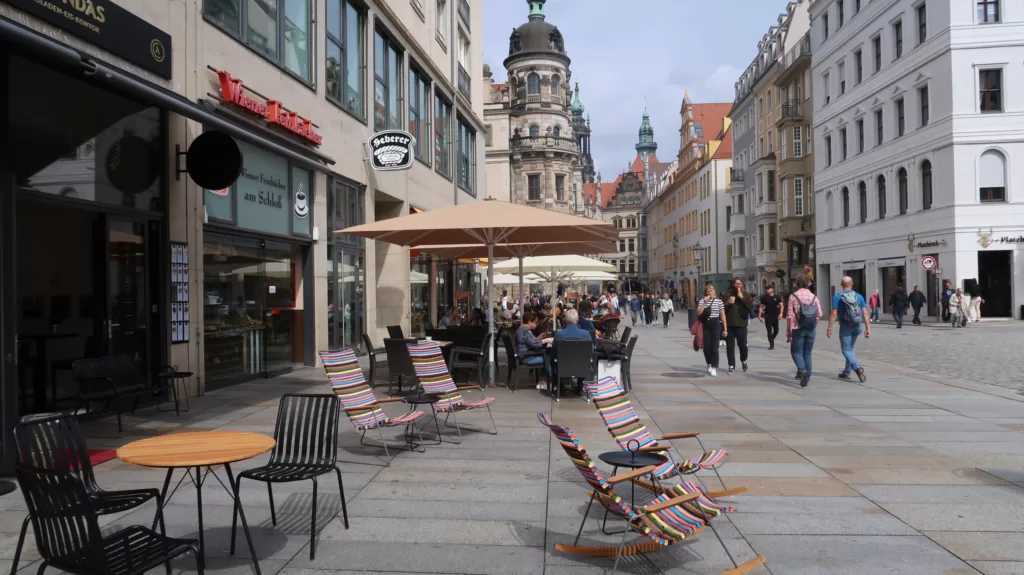
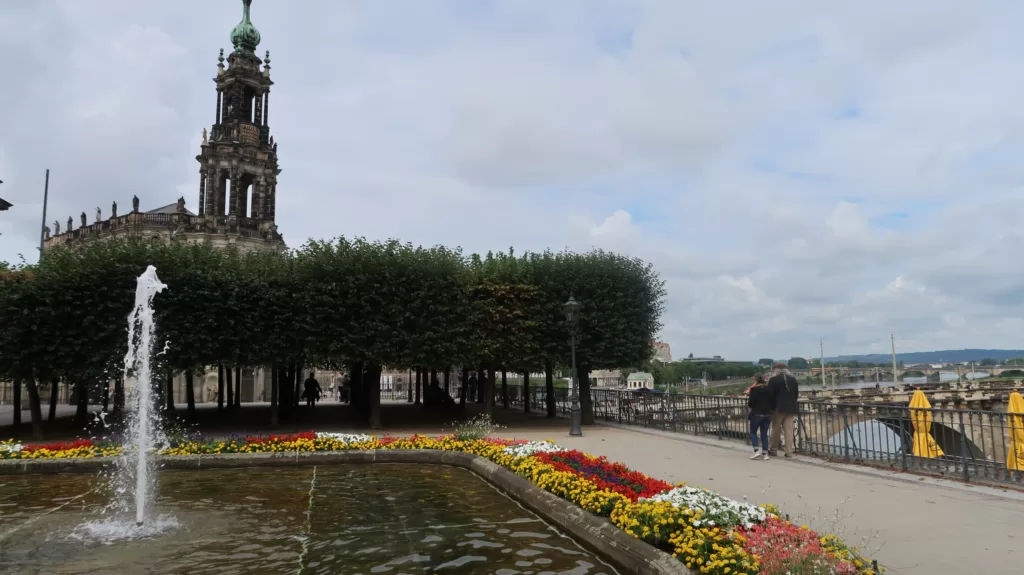
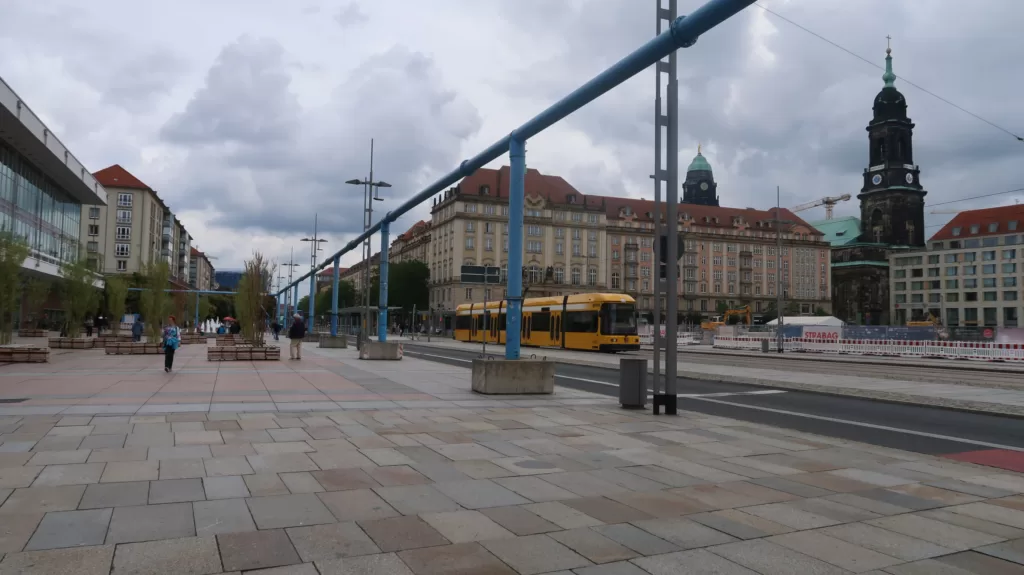
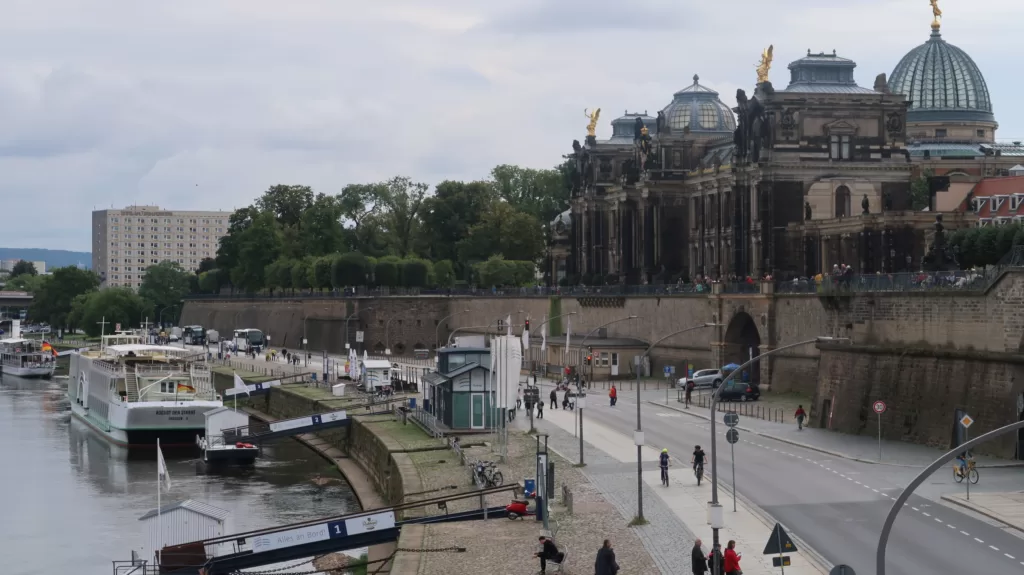

That said, it was good to be out sightseeing again after two days of heavy rain and I enjoyed my curry wurst lunch meal-deal before I found a chemist, where with the help of Google Translate, I bought The Navigator’s elixir and returned hot foot so she could start the treatment and get back on track.
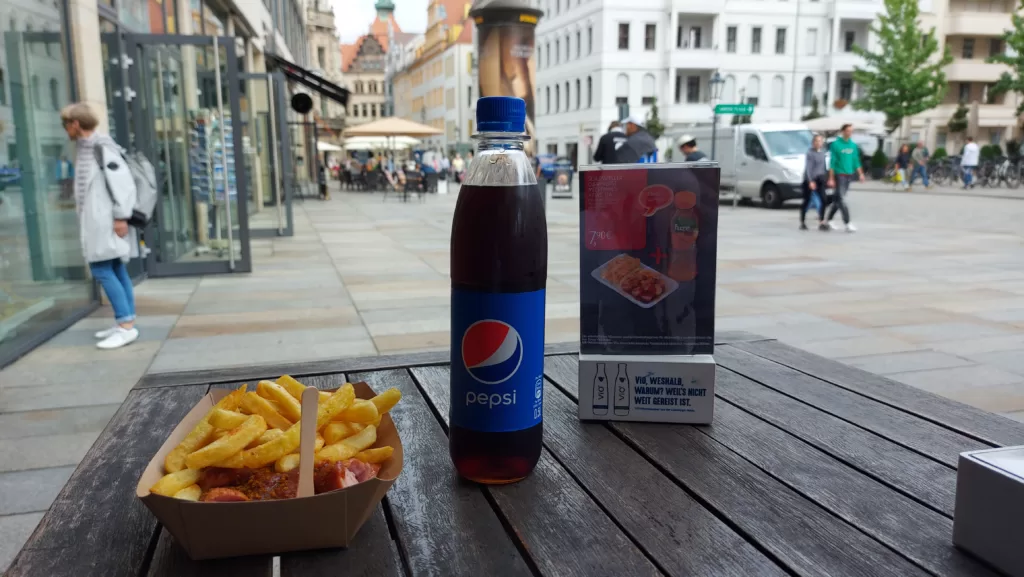
We both think that the cause of the problem was the trout that she ate on our last night in Poland as it was the only thing that we had differently in the time frame to cause the symptoms she has. As we were leaving the site, I couldn’t resist making The Navigator pose for the following picture and bless her, she obliged!
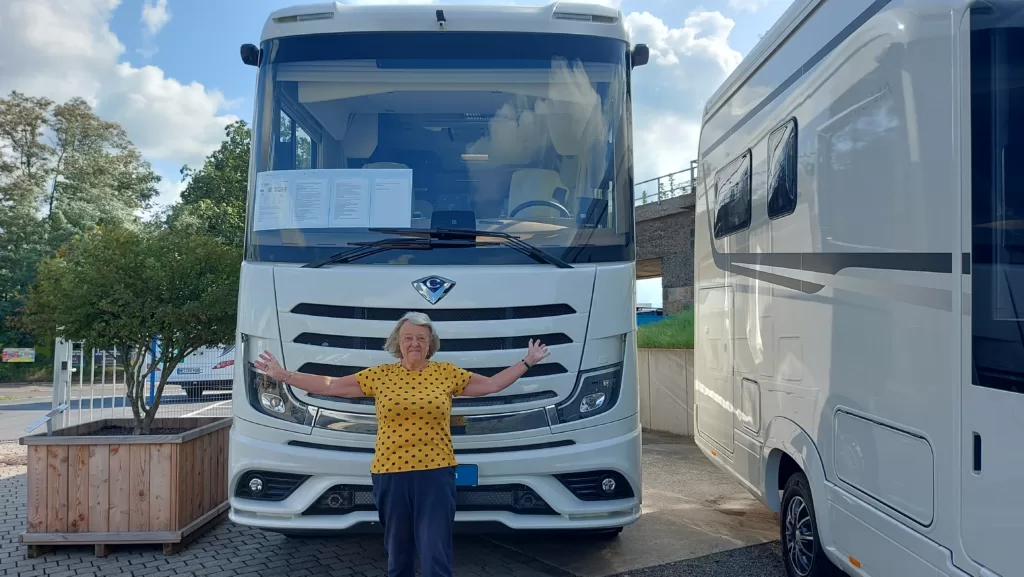
Day 58 – Thursday 31st of August
Dresden to Meissen (51.167457, 13.473743) (18 Miles)
Meissen was never on our radar but the city that was, Pirna, was in the wrong direction so we opted for Meissen and the bonus was it was less than half an hour away from Dresden. We serviced the van before leaving the campsite as tonight’s overnight location was just a car park, with a dedicated motorhome section.
You can never really tell when looking at the Google Maps satellite view how good a location will be, but at least I could see that it was on the banks of the Elbe so that was a bonus. A feature of using Google Maps to navigate is that it usually gives a warning of a speed camera ahead, but as we passed through a little village on the way to Meissen we were surprised by a red flash from a camera so there may be a fine waiting for us by the time we get home!
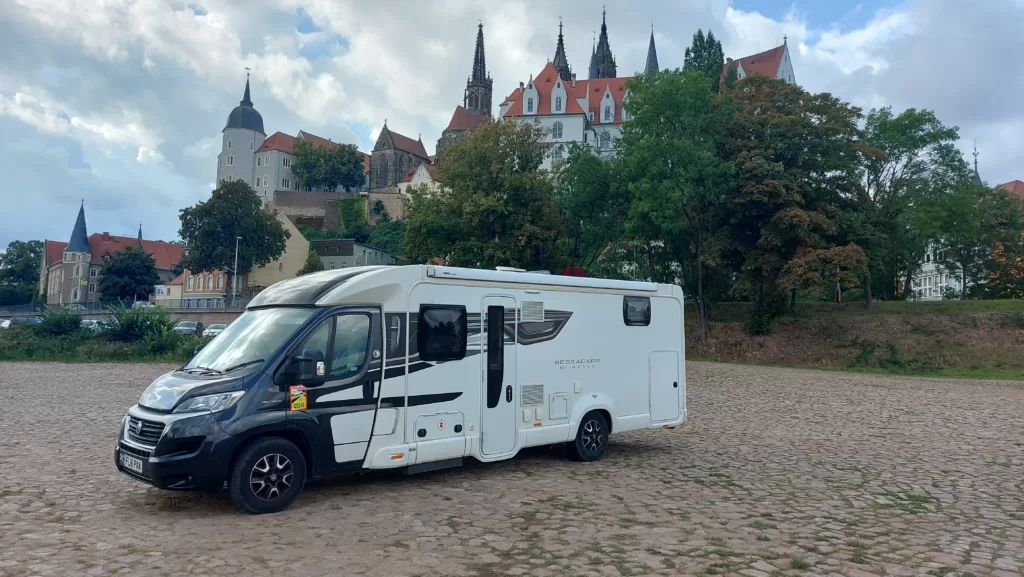
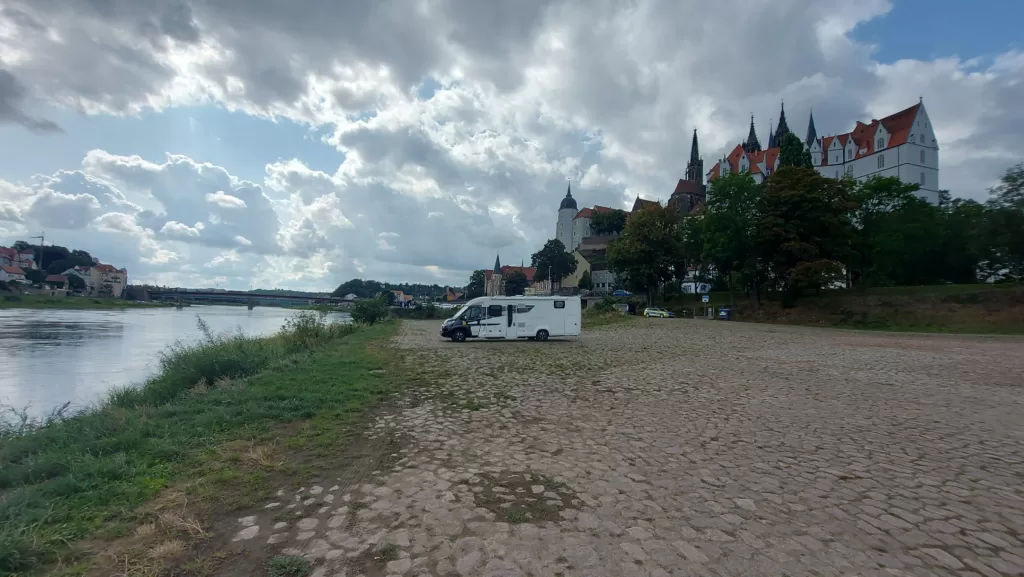
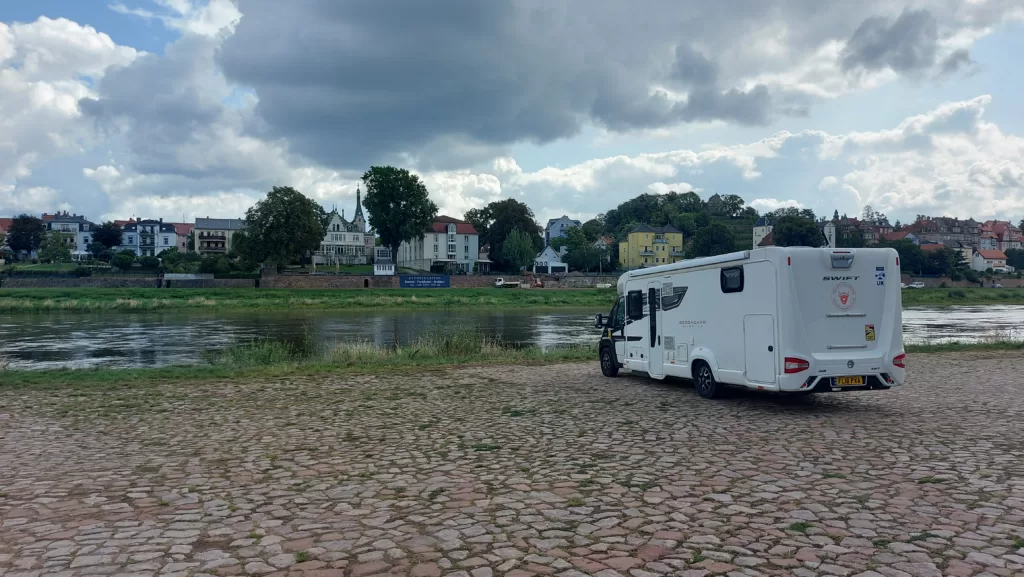
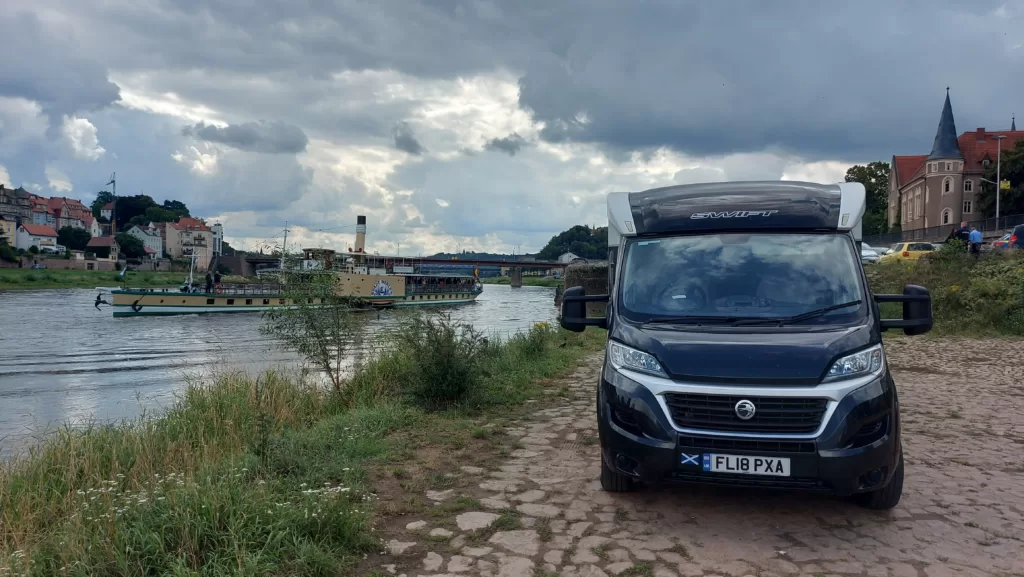
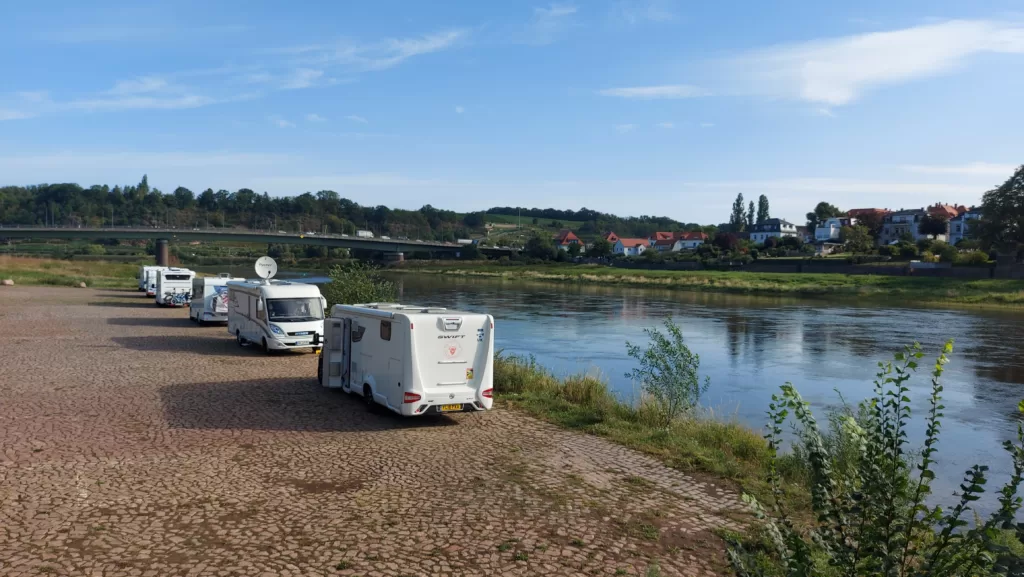
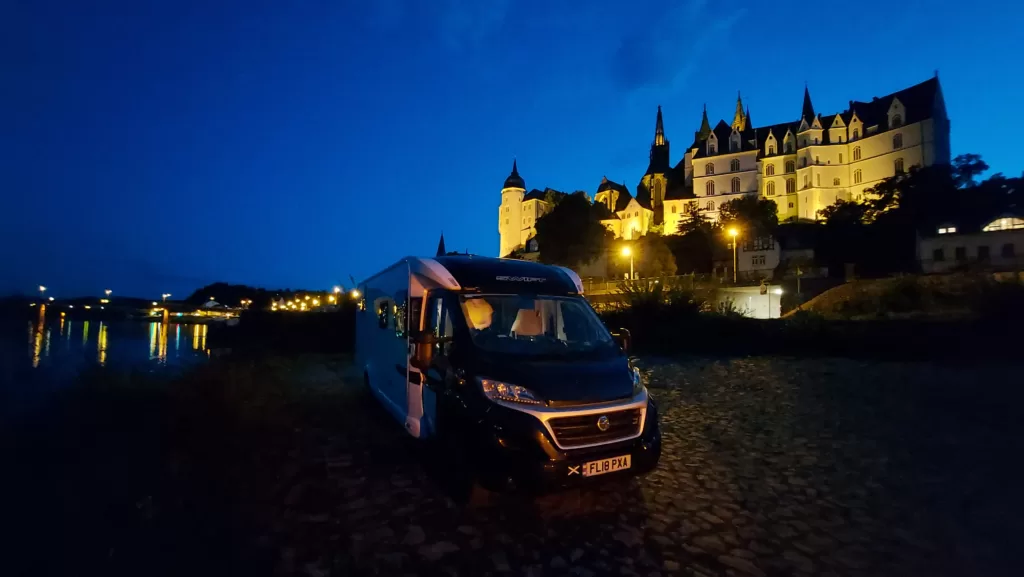
Not only was the riverside location a great place to park, what Google Maps didn’t show up was on the other side of the road was Albrechtsburg Castle, a late Gothic castle erected between 1471 and 1495 which is built on a hill above the river Elbe, adjacent to the Meissen Cathedral. It is believed to be the first castle built in Germany and ‘August the Strong’ used it as a porcelain factory from 1710 onwards to keep the manufacturing process a secret before manufacturing was moved to a factory in the city in the mid 19th century.
We set off for a walk into the nearby city centre and were immediately impressed by the well preserved buildings and layout. A river cruise boat had dropped off some passengers and we recognised some people who were on the campsite in Dresden. Meissen reminded us of Bernkastel-Kues on the Moselle Valley with its position on a wide river and its Medieval architecture and lovely square.
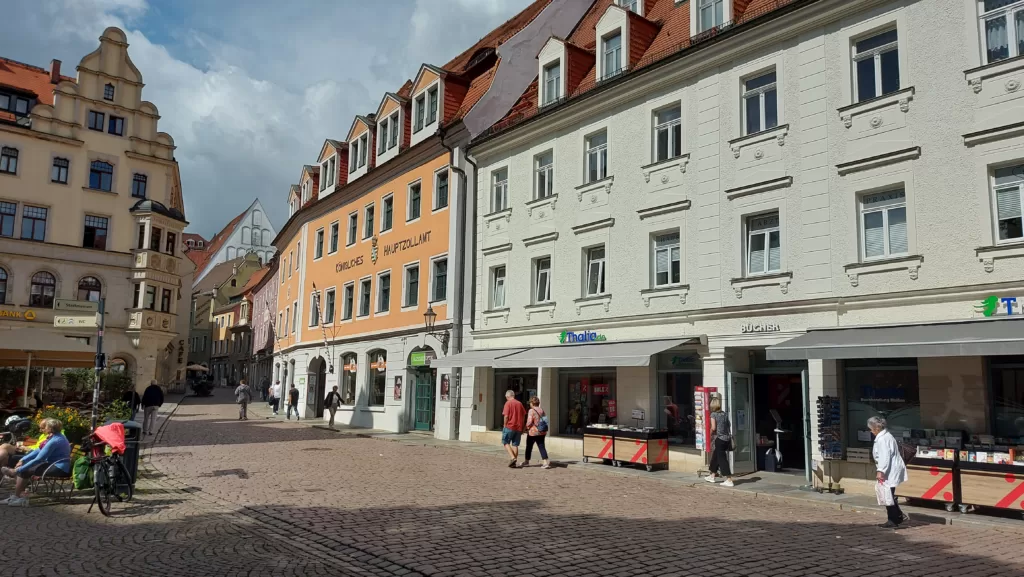
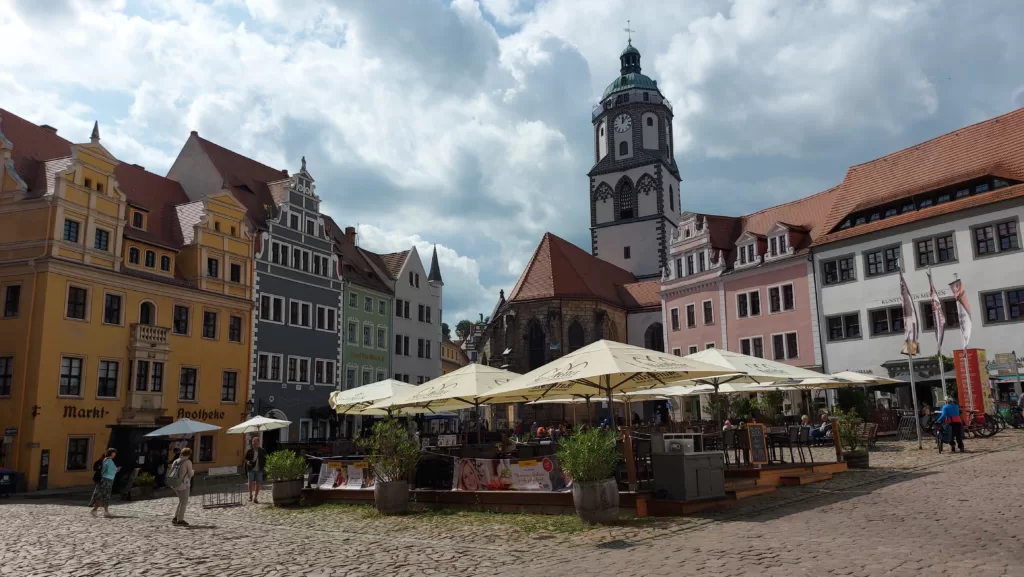

Meissen porcelain has been made here for over three hundred years and is referred to as “white gold” because of its high price, rarity and desirability. The porcelain has been considered the finest by European aristocracy as well as decorative arts connoisseurs for centuries. Today, these rare, intricate pieces from the 18th, 19th and 20th centuries are particularly in demand but what surprised us was the lack of shops selling this small city’s best known product.
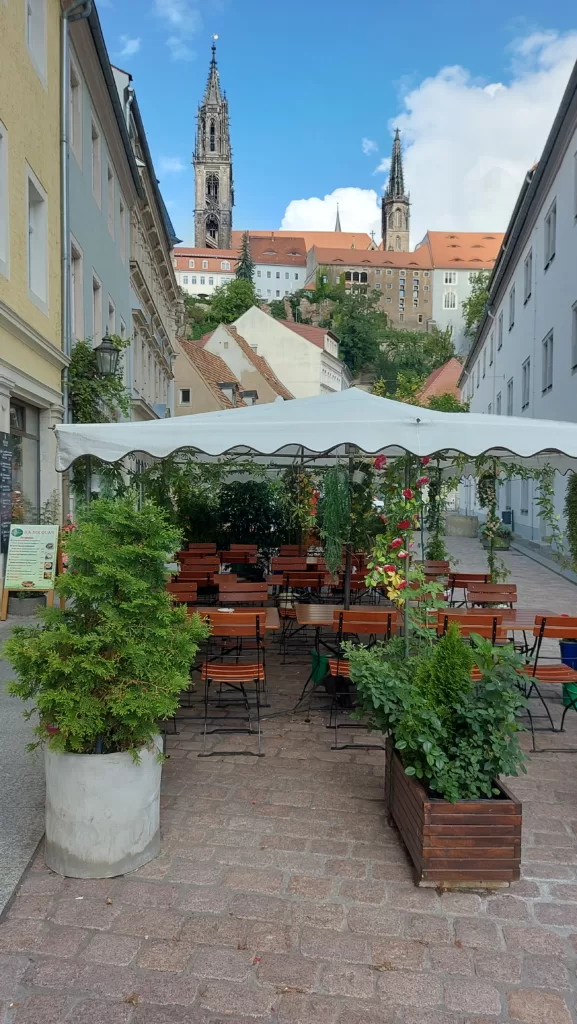
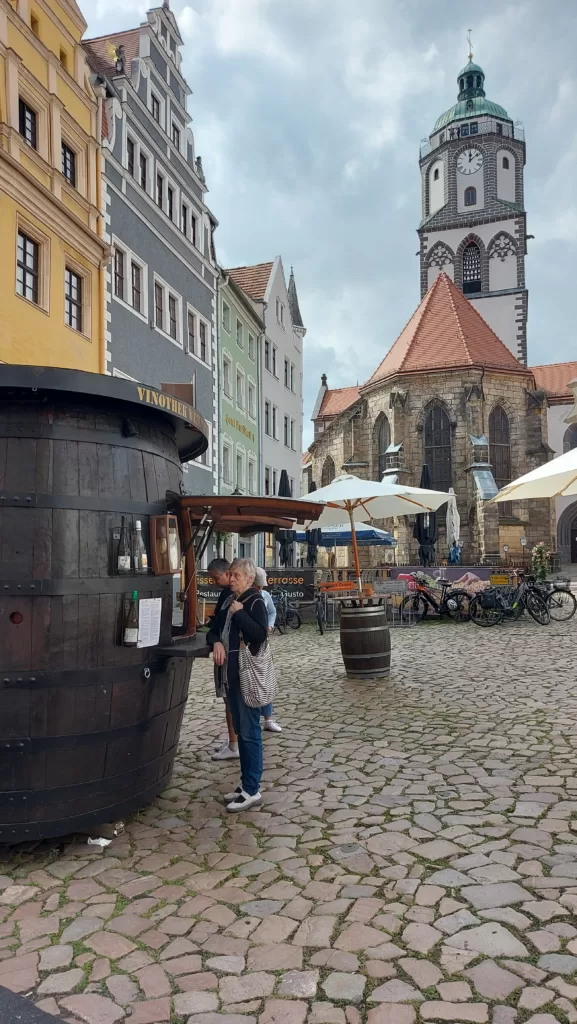
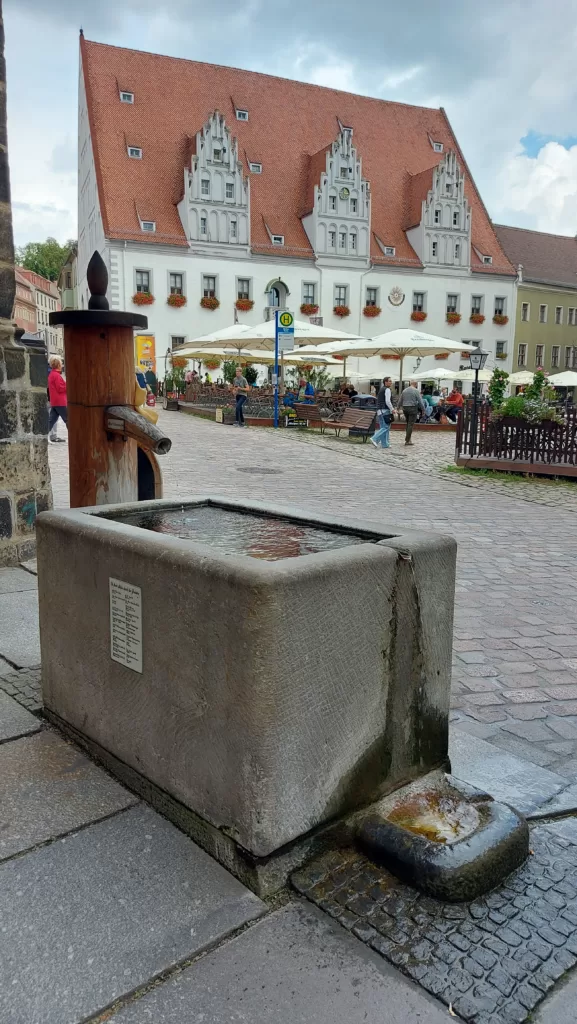
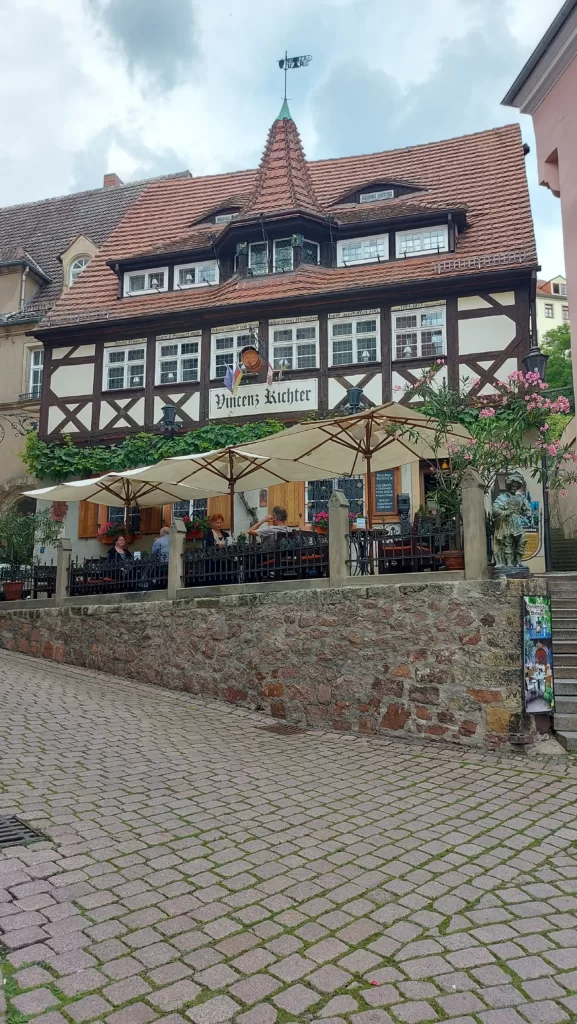
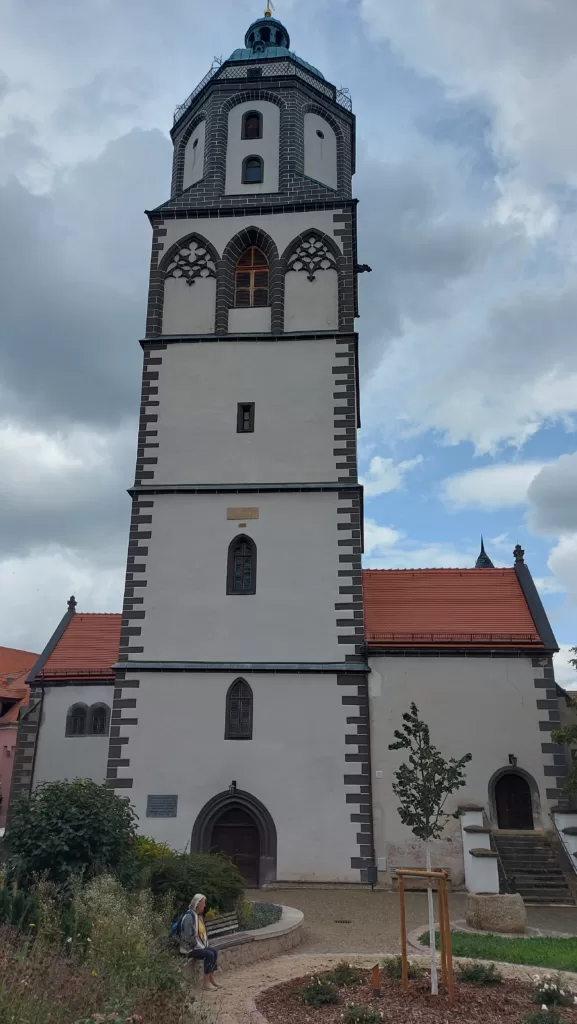
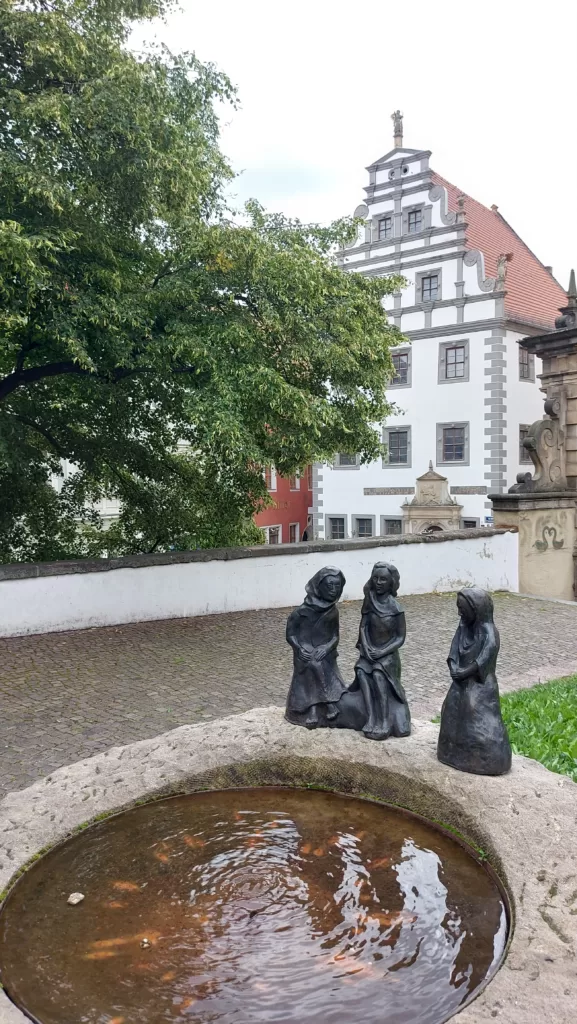
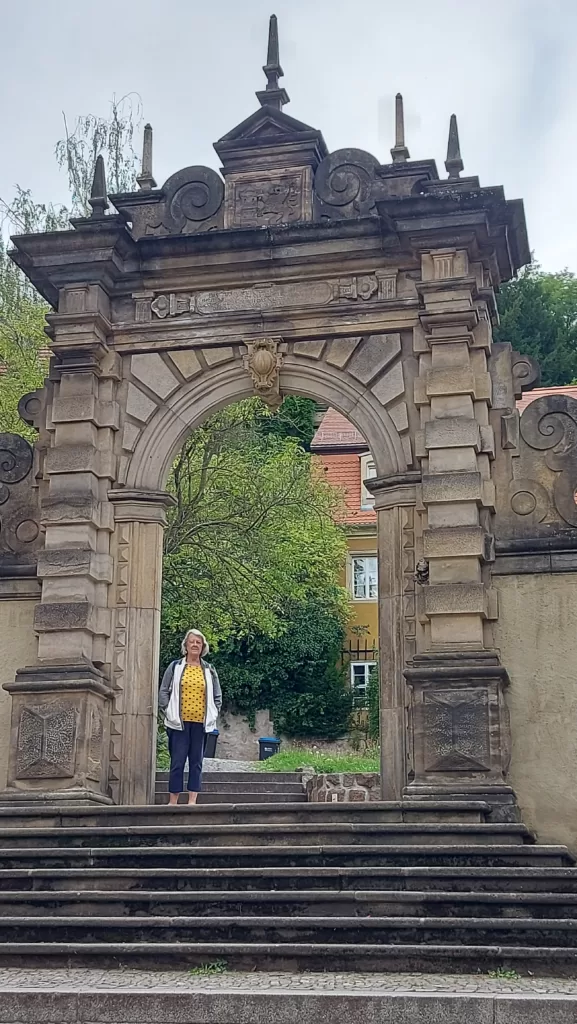
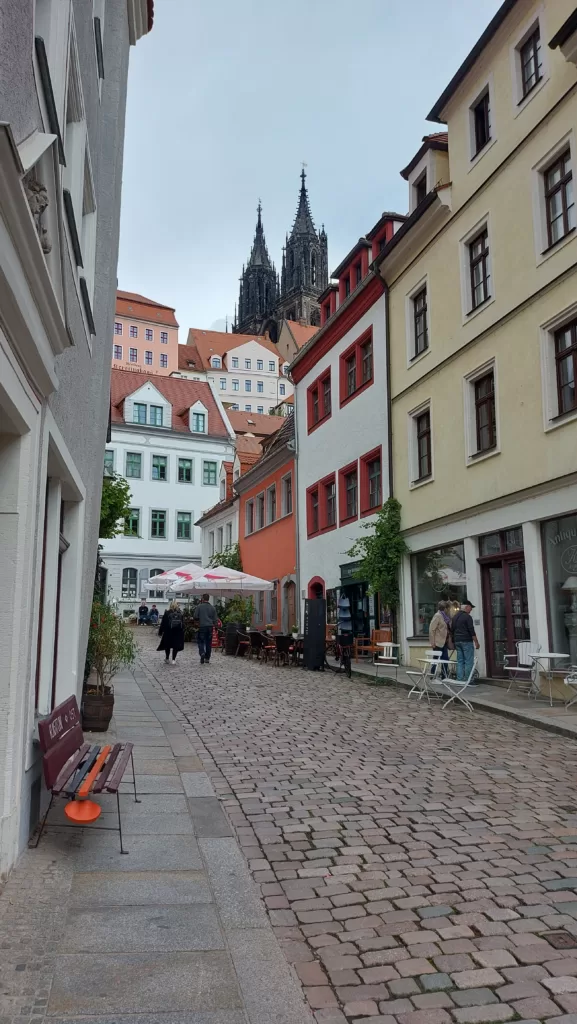
The Navigator was still not quite 100% so could not face a proper lunch but we had some delicious pizza slices sheltering in a doorway as the heavens opened. The rain became torrential so the brollies were retrieved from The Navigators backpack and with no sign of it abating, we made our way back to Bessie.
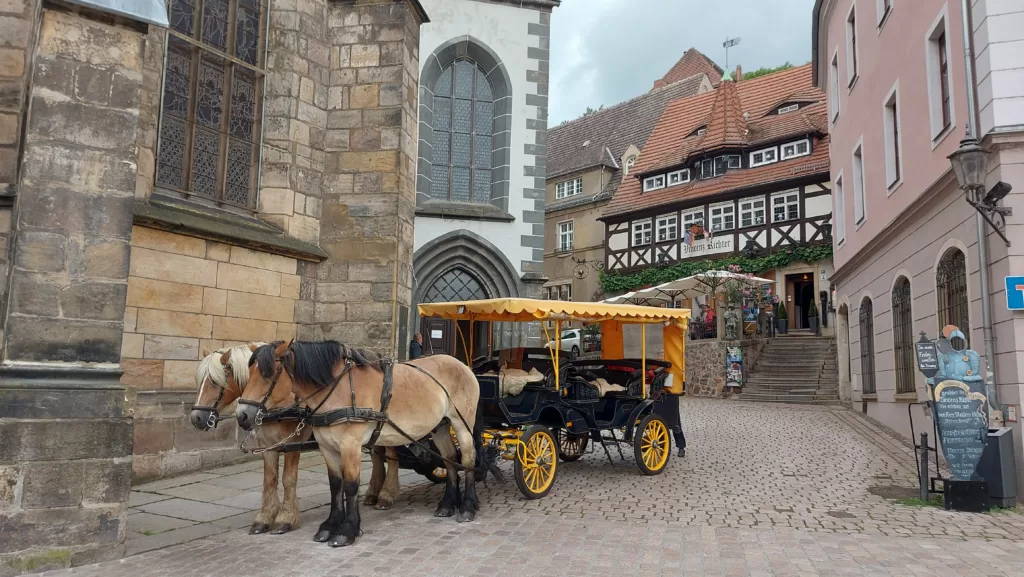
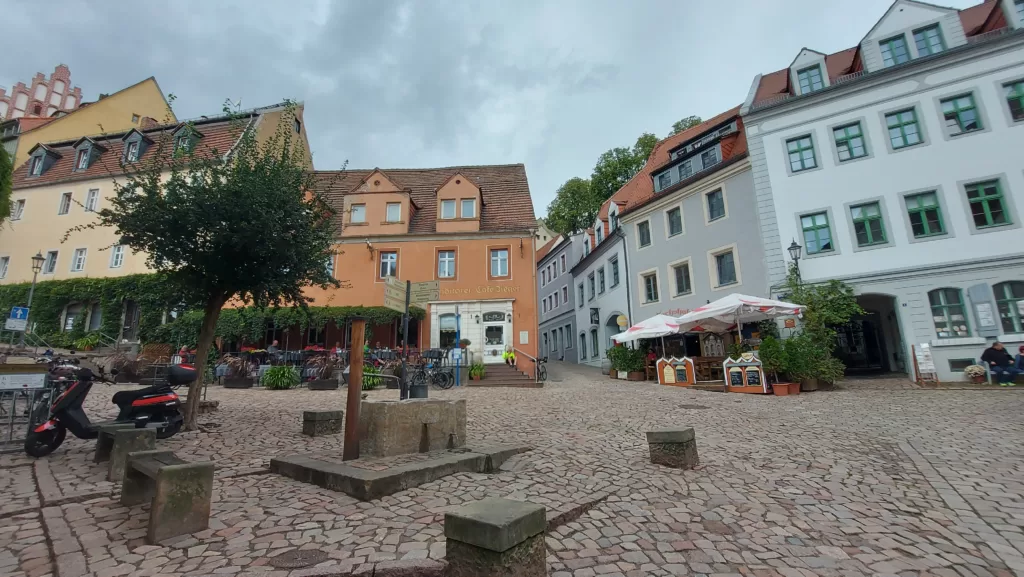
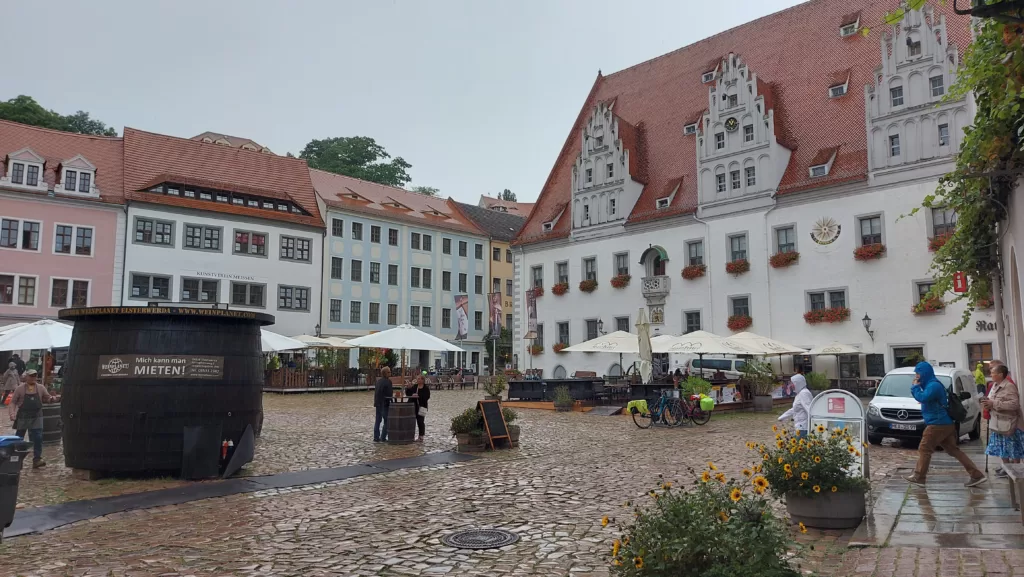
Some motorhomes came and parked here and left again after a few hours but about half a dozen joined us to stay overnight. I mentioned the Moselle earlier, which along with the Rhine are great to park beside and watch the busy river traffic, but on this section of the Elbe anyway, there are no commercial barges, only a few sizeable tour boats from Dresden as apparently the fluctuations in the depth of the river hinder its use by the larger river barges.
We settled down later to catch up on a few editions of Only Connect where honours were even and then The Navigator watched Masterchef. We then fell asleep but around midnight we heard the voices of youths nearby although they never came anywhere near the parked motorhomes, but you never really settle until they move on.
Day 59 – Friday 1st of September
Meissen to Beelitz (52.233616, 12.984765) (155 Miles)
(via Colditz)
Today’s ultimate destination was going to be the major city of Leipzig but the stellplatz we were going to stay on was closed this weekend to upgrade its services so we decided to give it a miss as it is not really a tourist destination anyway, more a modern manufacturing city.
Where we are heading for first is a castle far more famous than the one we were in the shadow of yesterday and that is Colditz Castle. There has been a castle at Colditz for almost seven hundred years serving different uses down the centuries but the castle gained international infamy as the site of Oflag IV-C, a prisoner-of-war camp during World War II for “incorrigible” Allied officers who had repeatedly attempted to escape from other camps.
Although it was considered a high security prison, it had one of the greatest records of successful escape attempts. This could be owing to the general nature of the prisoners who were sent there; most of them had attempted escape previously from other prisons and were transferred to Colditz, because the Germans had thought the castle escape-proof.
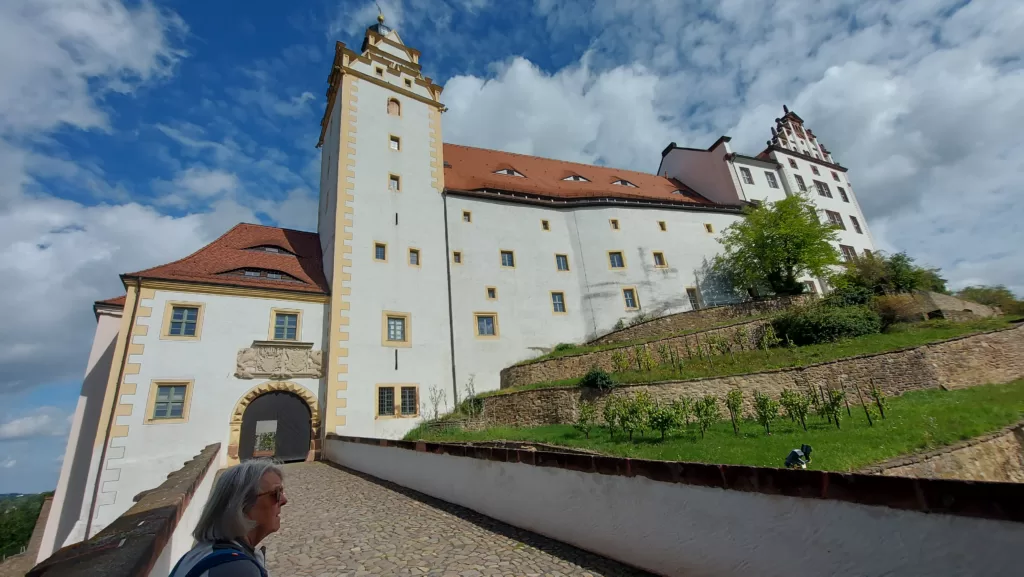
In 1955 the film ‘The Colditz Story’ was made starring John Mills, Lionel Jeffries, Bryan Forbes and Ian Carmichael and then in 1972 the BBC made a series, Colditz, which starred David McCallum, Edward Hardwicke and Robert Wagner, that focused on life at Colditz.
The drive to Colditz was one of the better ones as we travelled through a mixture of agricultural fields given over to crops and rolling wooded hills with small villages to keep me on the lookout for pesky speed cameras. The actual little town of Colditz could be described as ‘sleepy’ as there did not seem to be much sign of life, and as we needed shopping, we stopped at a Netto to top up on groceries for the weekend. The Castle could be seen from the car park as it towers over the town but Netto had lots of signs indicating that there was a one hour maximum time to do your shopping, so, although there was plenty of room, we couldn’t leave Bessie here to visit the Castle.
There is an expensive campsite a little bit out of town but there is also a free motorhome parking area, with no facilities, a few hundred yards from the Castle so we headed there to find only one elderly Dutch motorhome there. From this parking spot it is a downhill walk to the Castle of just over ten minutes. We were amazed that there was no one about as the name Colditz is known by anyone of an age to remember the film, BBC series and an interest in history, especially of WW II.
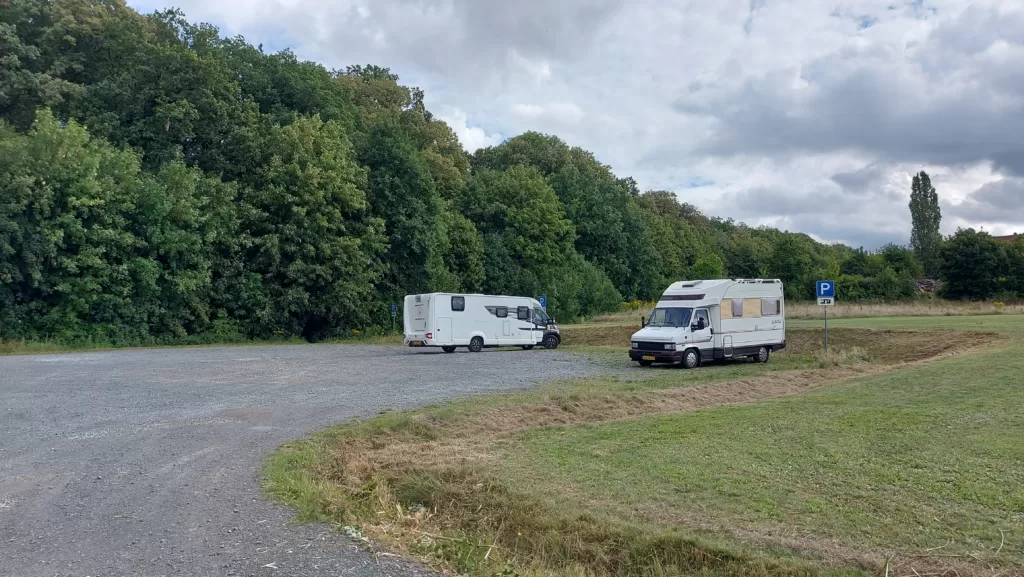
We were there for probably a couple of hours and if there were a dozen other people there that would be the sum total of visitors. There was a guided tour in English in an hour’s time but we decided to pay € 4 each which is the entry fee to wander about yourself. The museum is very interesting with lots of pictures of the men who were there from all nationalities including the household names like British fighter ace Douglas Bader, Pat Reid, the man who brought Colditz to public attention with his post-war books, Airey Neave, the first British officer to escape from Colditz and later a British Member of Parliament, New Zealand Army Captain Charles Upham, the only combat soldier ever to receive the Victoria Cross twice, and Sir David Stirling, founder of the wartime SAS.
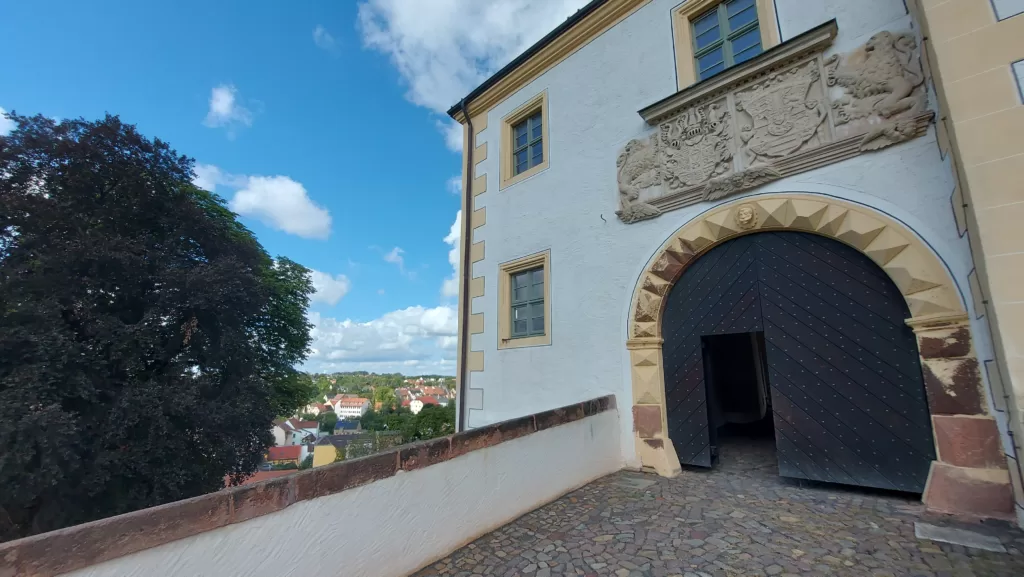

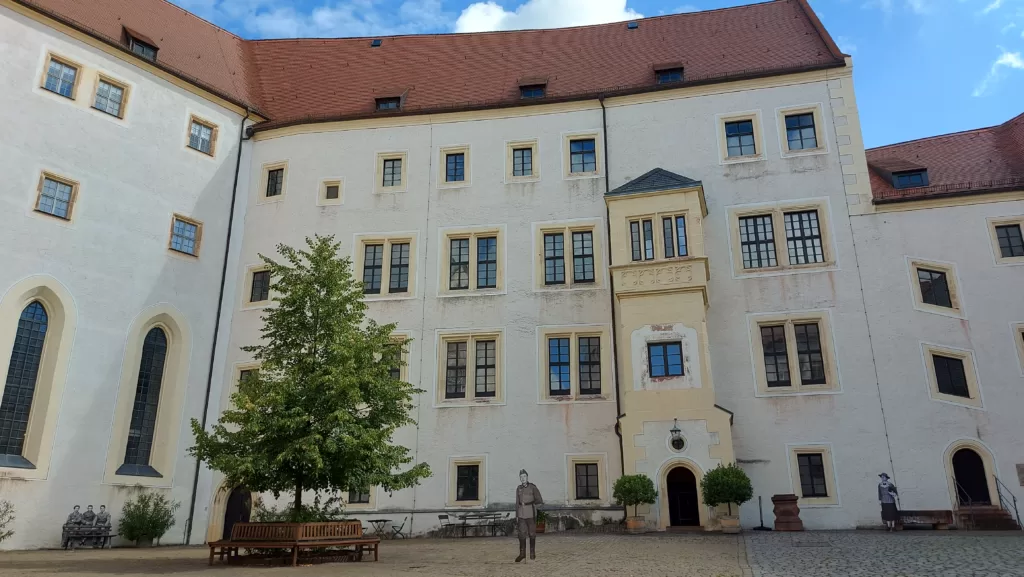
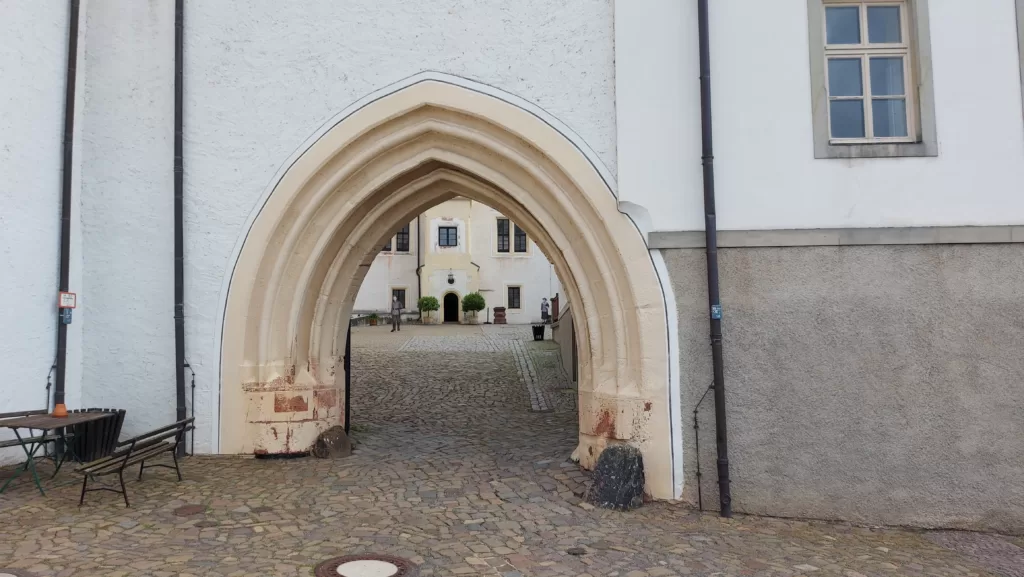
The castle sits on a steep hill overlooking the Mulde River as it flows through the small Saxon town of Colditz, about 30 miles southeast of Leipzig. A former residence of the kings of Saxony, the castle was used in 1939 as a prisoner-of-war camp, and in 1940 it became a maximum security prison for escape-prone Allied officers.
The internal buildings and courtyards were perched 250 feet above the surrounding terrain and were enclosed by steep stone walls 7 feet thick at their base. Staffed by numerous armed guards and located some 400 miles from friendly territory, Colditz seemed to offer no hope for escape. Yet, through ingenious tunnelling and various ruses, prisoners on some 130 occasions managed to clear the fortress grounds. A total of 32 prisoners managed to reach the frontier without recapture. Colditz fell to the U.S. Army in April 1945.
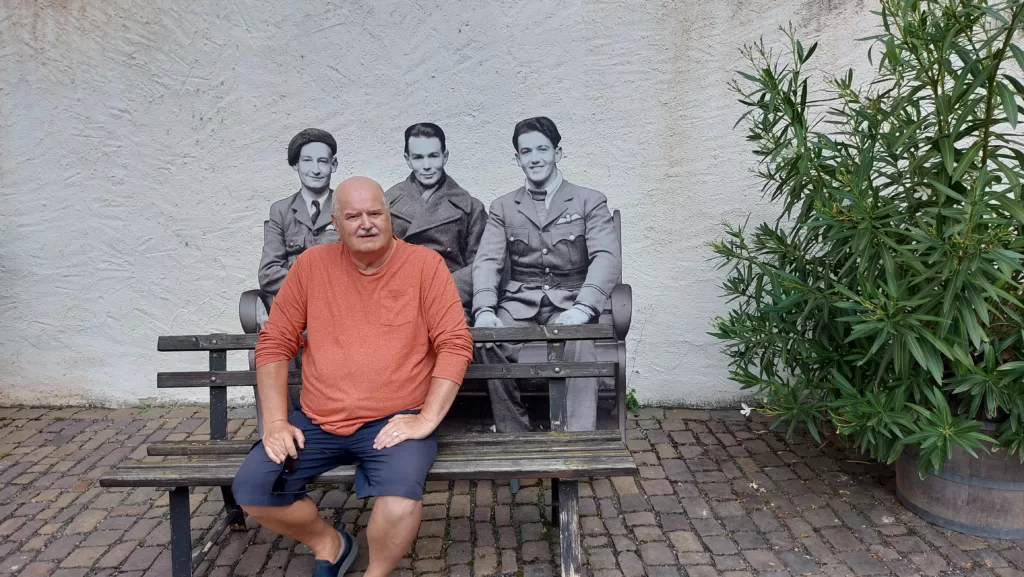
The contrast between here and Auschwitz could not be more stark, Colditz was a POW Camp, not an extermination camp and although the Allied prisoners tried, and often succeeded in escaping from Colditz, there were no serious acts of revenge by their German guards.
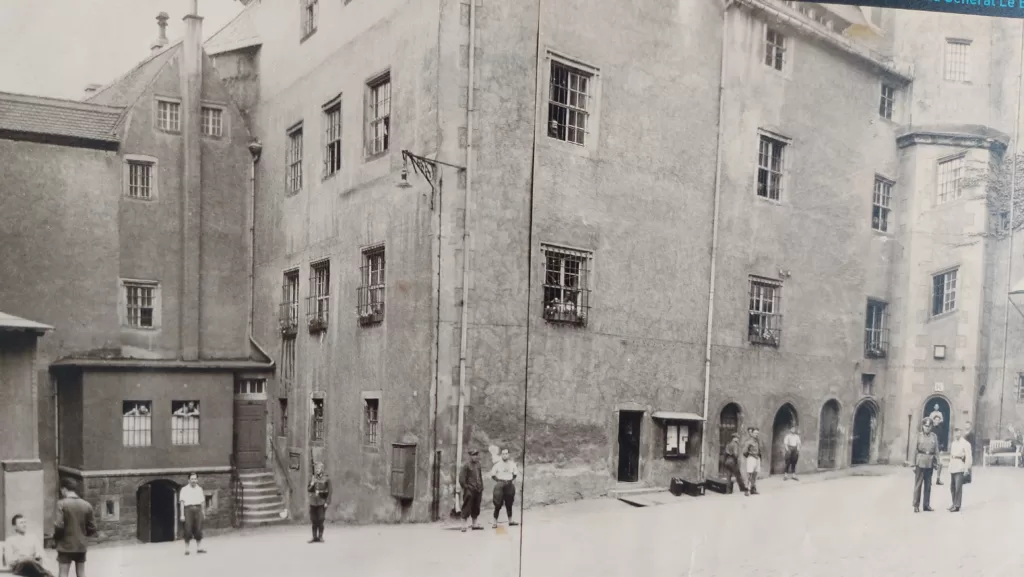
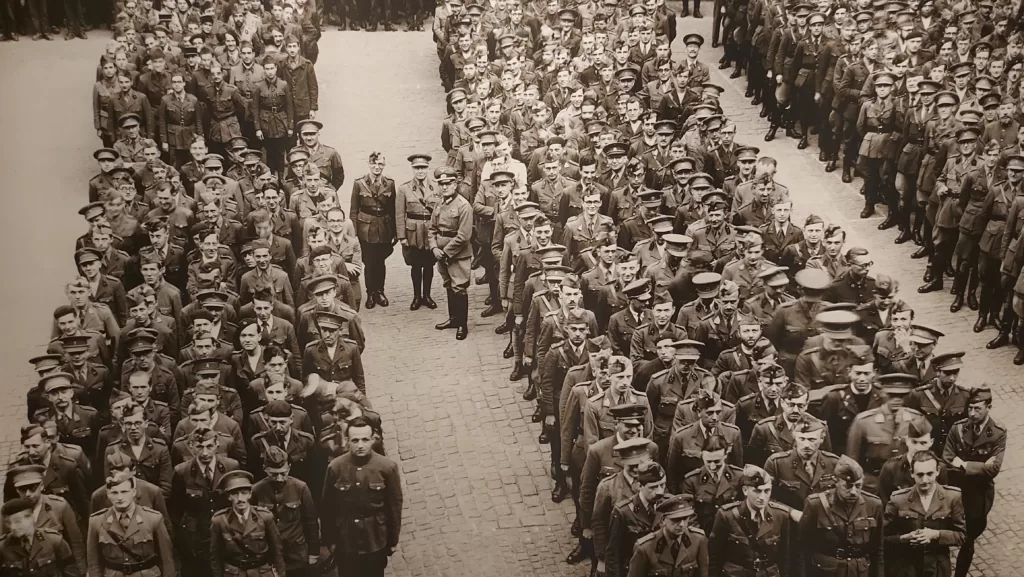

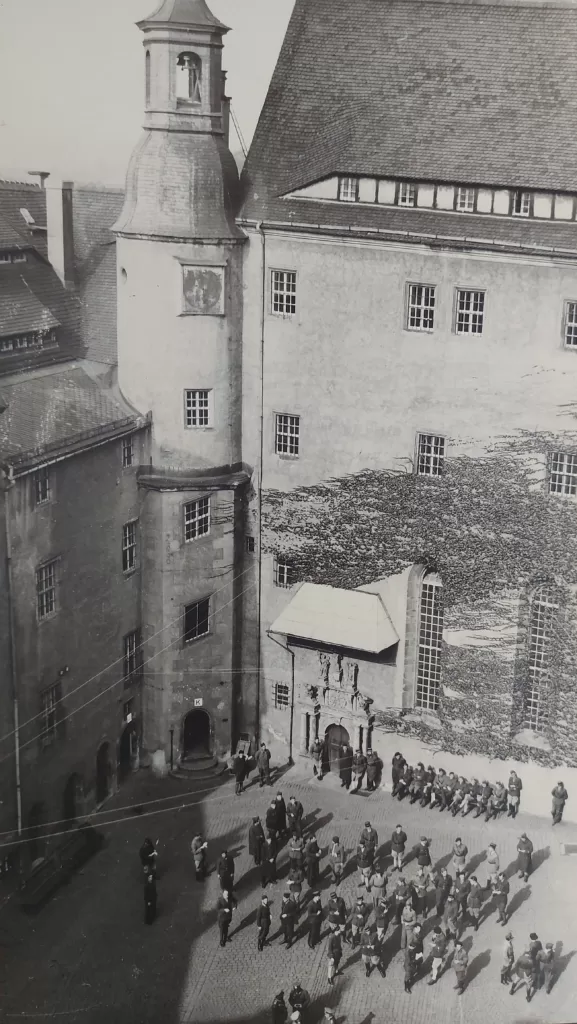
The walk back to Bessie was tougher than the walk downhill, especially as it was very warm again, but we made it. The Dutch van left the parking space leaving us as the only motorhome there. We had lunch before driving down into the town to visit a large Lidl to check out their wine selection as that’s not Netto’s best category. A bonus of parking in Lidl’s car park is that you get a great view of the Castle which dominates the town.
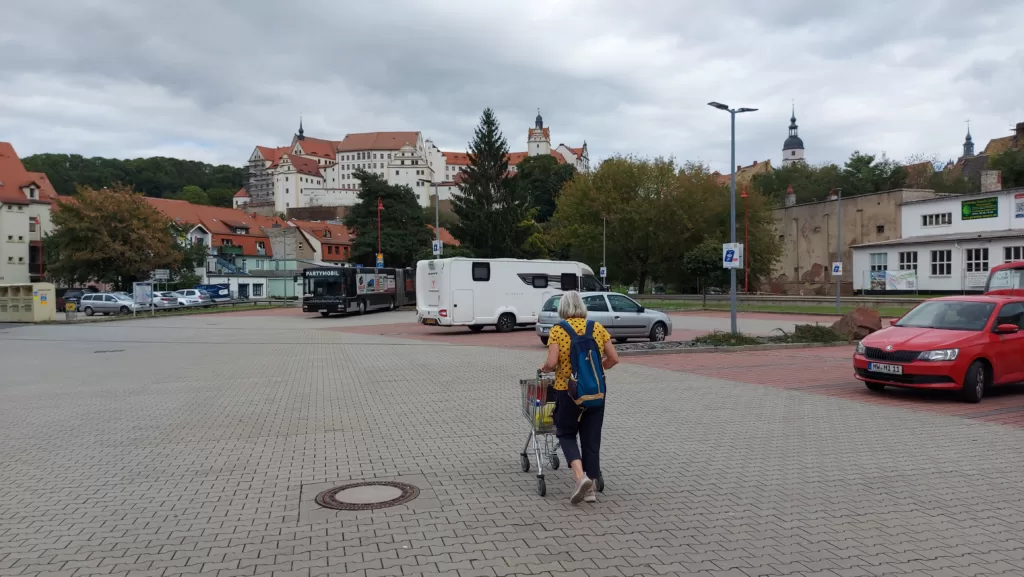
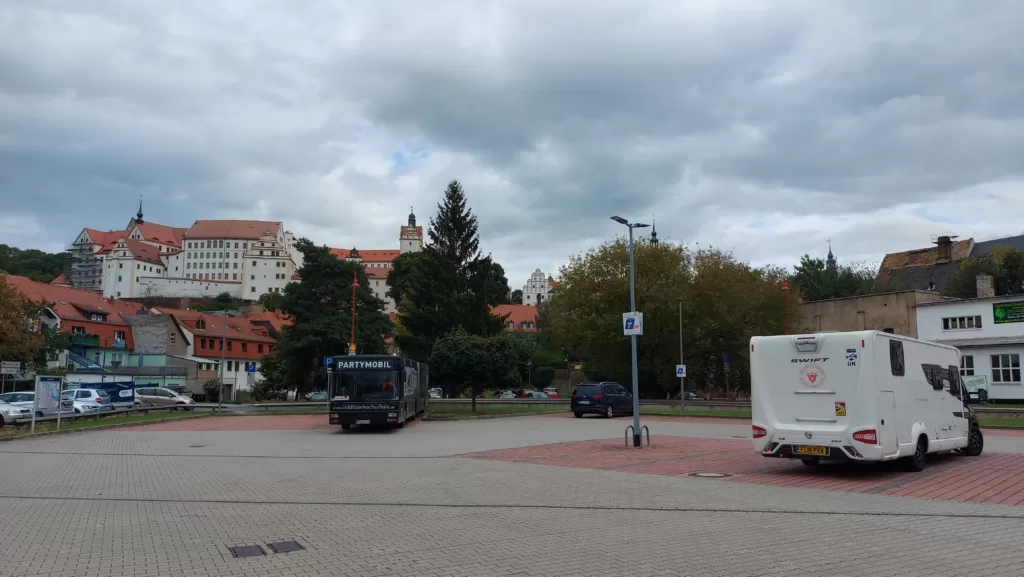
The Castle was built around 1510 and you would think that the centre of the town would be full of half timbered medieval houses, but it wasn’t so we started the journey to the town of Beelitz, a historic town in Potsdam-Mittelmark district, in Brandenburg, Germany, chiefly known for its cultivation of white asparagus. The drive there was nearly all on motorway so was easy enough and we arrived in Beelitz at 4pm. There is a brand new stellplatz within walking distance of the town centre and its so new that they haven’t even connected the payment machine yet, although the electricity and water are both connected.
Day 60 – Saturday 2nd of September
Beelitz (0 Miles)
So why are we in Beelitz I hear you ask when you’ve never heard of it and it’s not asparagus season yet? Good question and it is more to do with where we’re going next and the age old problem of not wanting to arrive in a major city on a busy Friday or Saturday, especially when its Berlin, the capital of Germany, so we are biding our time here in Beelitz, which is only a forty five minute drive from our intended stellplatz in Berlin.


If you look at this stellplatz on Google Maps satellite view it is just looks like a farmer’s field but since the satellite mapped this area there has been a fair bit of development, including this stellplatz and a huge carpark. As I mentioned, the ticket machine (believed to be € 19 a night) is not working but the electricity and water are connected and free to use, but whoever designed the facilities has never used a motorhome as there is nowhere to dump grey and black water.
There is a modern fire station next door and it was obvious there was going to be an open day today with all the activity taking place from an early hour. Little did we know just how good the displays would be, or how well the event would be attended. After a lazyish morning we set off for a walk into the town centre and on the way had a walk through the exhibits, which were very impressive, from the oldest historical fire fighting devices right through to the very latest state of the art fire engines and support vehicles.
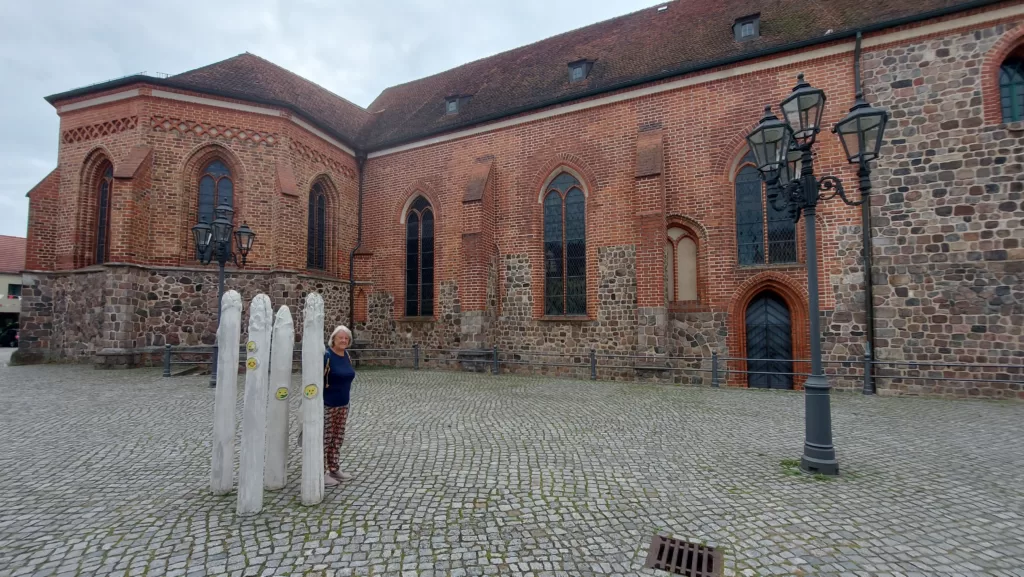
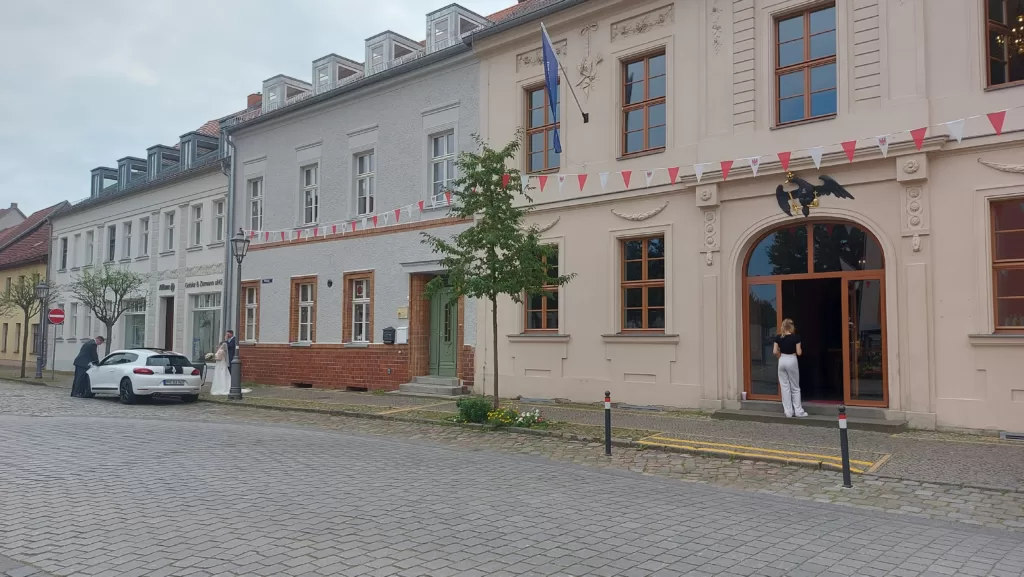
The town itself is not particularly historic, although the church is, but the town gives the impression that it’s prosperous. We had a walk about and couldn’t believe that most of the shops were either closed or in the process of closing at noon but one business that wasn’t closing was a little Chinese restaurant and we had lunch there and it was delicious. The town boasts four supermarkets, Aldi, Lidl, Rewe and a new one on us, Norma, so as we needed a few items we gave Norma a go and it was very much a copy of an Aldi / Lidl and was good value.
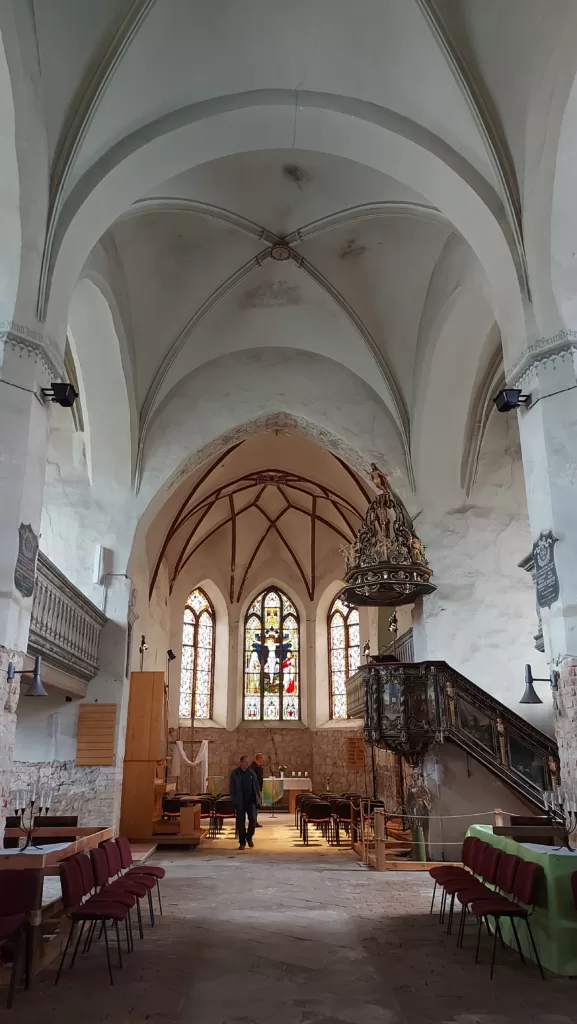

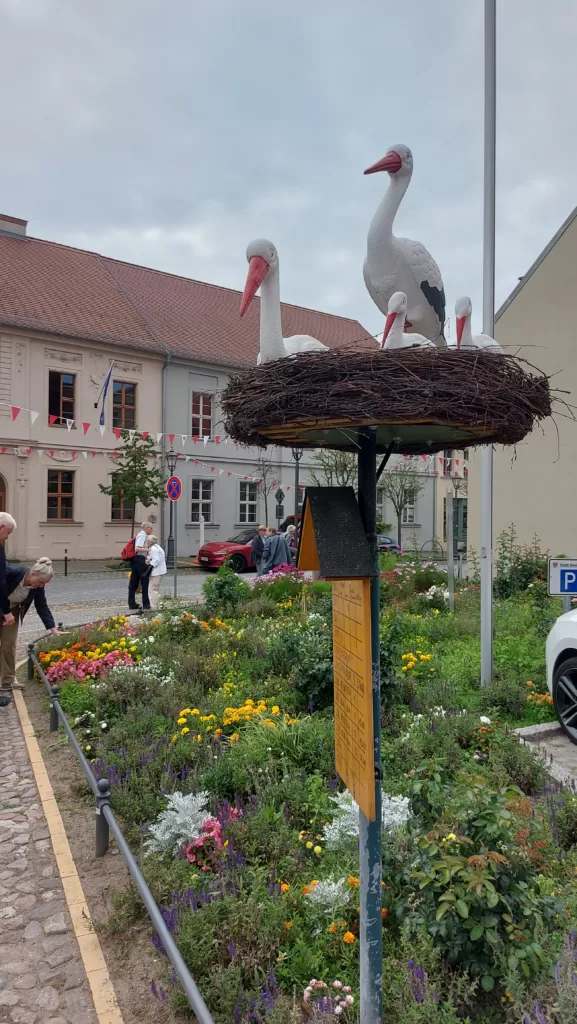
The open day at the fire station was in full swing with lots of demonstrations, bands playing and food being served. In the early evening the families dispersed and we thought it would wind down from there but a DJ started blasting out music and the alcohol fuelled festivities carried on until 11pm!
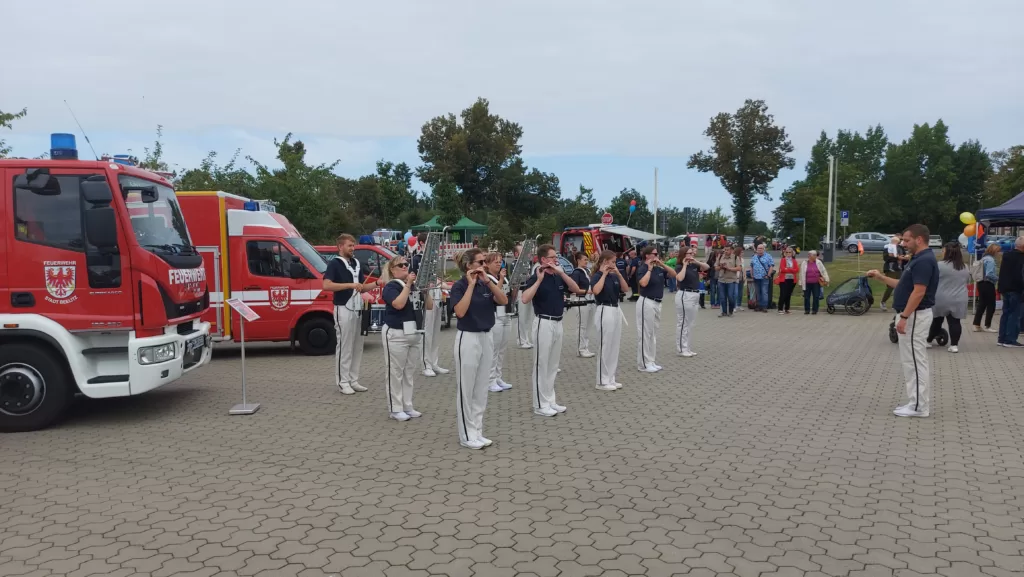
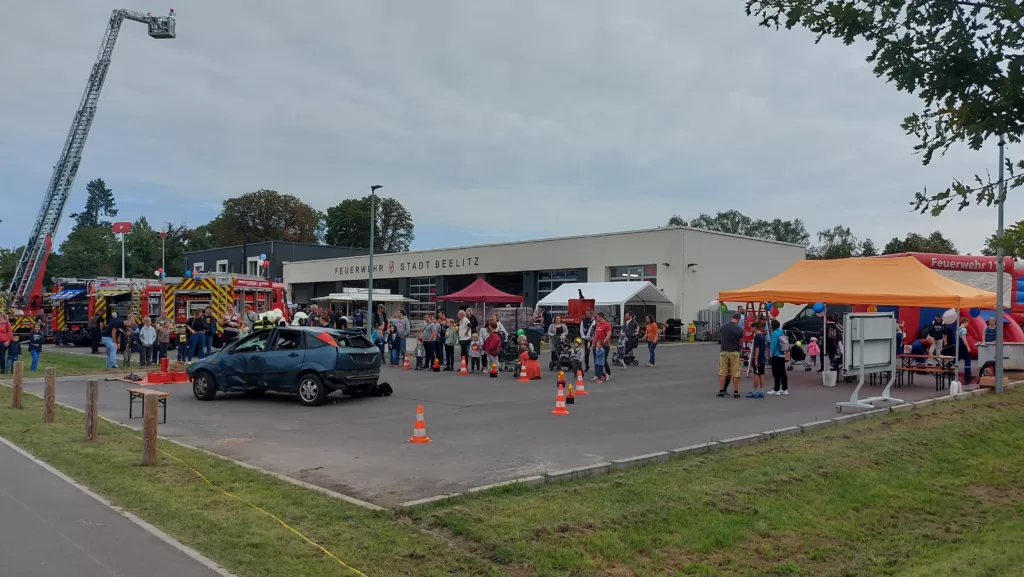
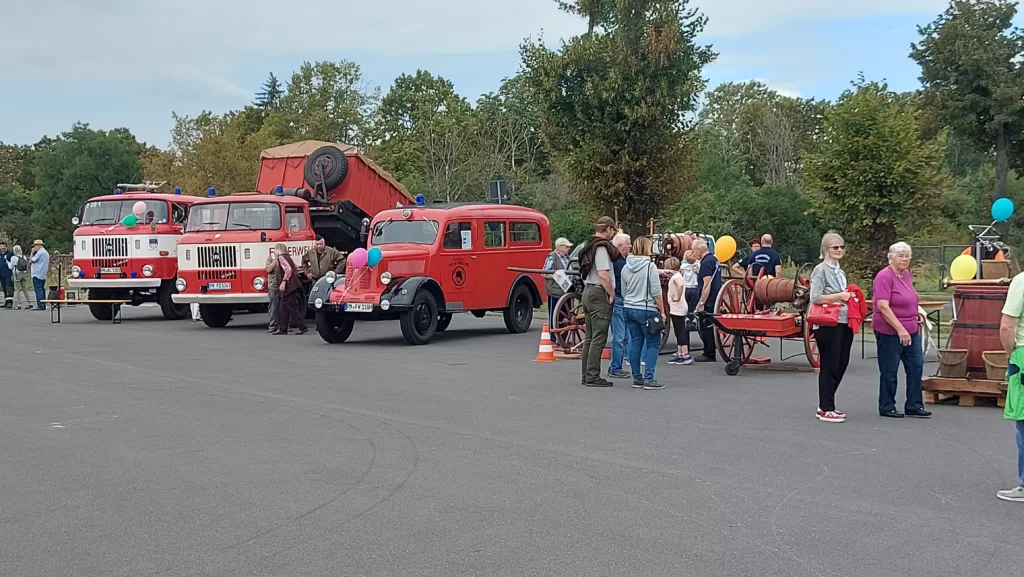
On the other side of the street the highlight of the day for the crowds was the setting fire to some pallets in a skip with the firemen using all sorts of equipment to put it out looked over by a huge drone!
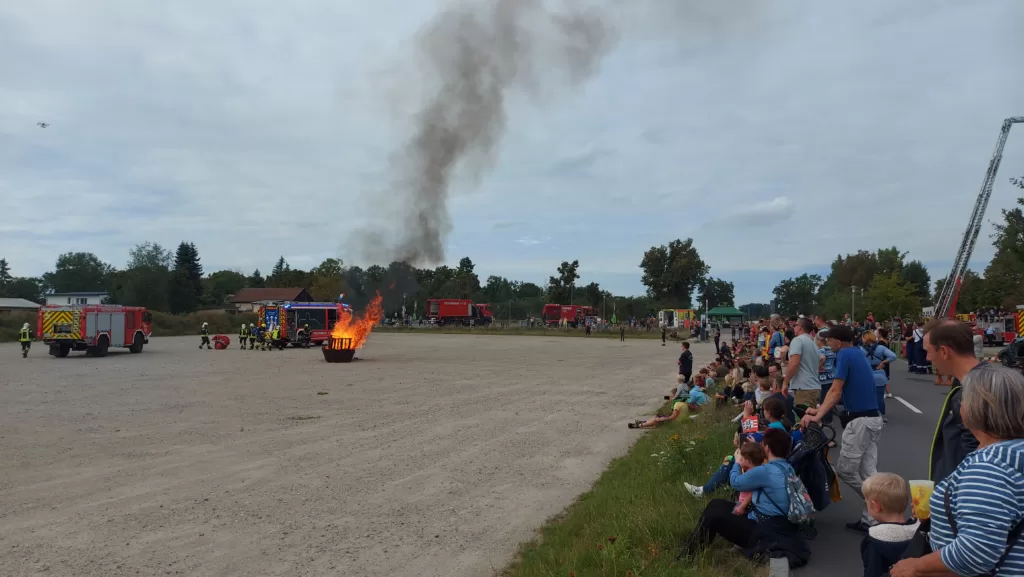
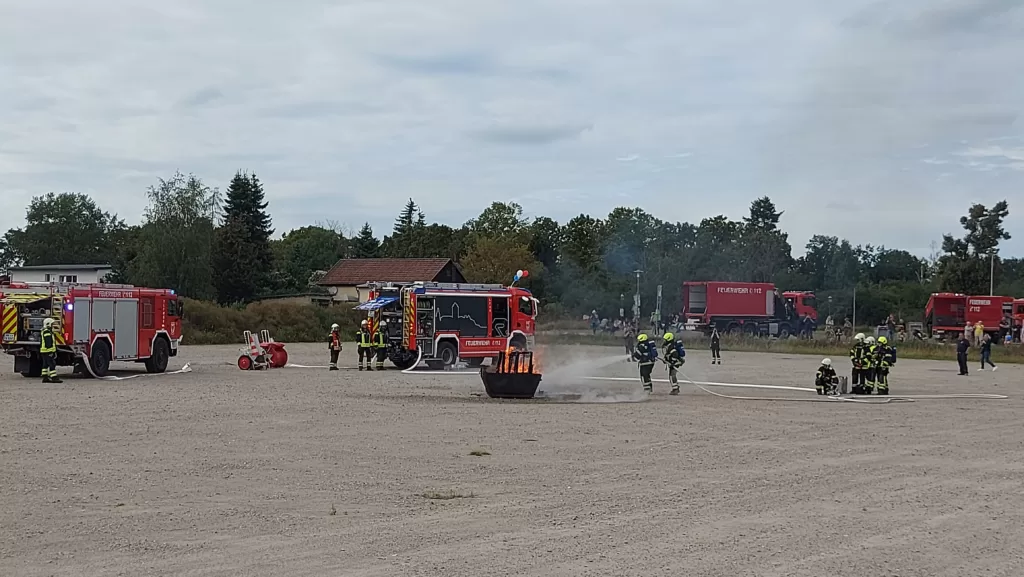
That evening, I managed to finish off the next blog, the 6th in this series, and it will be online on Monday morning.
Day 61 – Sunday 3rd of September
Beelitz to Berlin (52.549133, 13.382958) (35 Miles)
And so to Berlin, the fifth capital city of this tour after Riga, Tallinn, Vilnius and Warsaw. We filled up with water for free before leaving and we’re on the road fairly early as we wanted to drive into Berlin in the morning while the traffic would be light.
The fire station had returned to normal after yesterday’s festivities and apart from a food trailer still on the forecourt, you would never know anything had happened there recently. We had a drive of about eight miles before getting on the motorway heading to Berlin and in that short distance managed to get flashed by a speed camera again, at least I think it was us that got flashed, but we never saw the camera on the other side of the road and can only hope it was a car going in the other direction.
It didn’t take that long to get into the outskirts of Berlin and it was a fairly painless journey to find the site, although we did take a wrong cut off at a junction when Google Maps told me to turn right instead of left, not the first time that’s happened. There was a queue to get booked in at the site as the oldish guy with a pony tail on reception had great difficulty typing our details into his laptop and at one stage I had to lean over the counter and type in some details upside down for him.
This is the most expensive site we’ve been on on this whole trip and he would only accept cash, which has dwindled our Euros, but we are in a capital city within a short walk to an underground station so it’s not without its advantages.
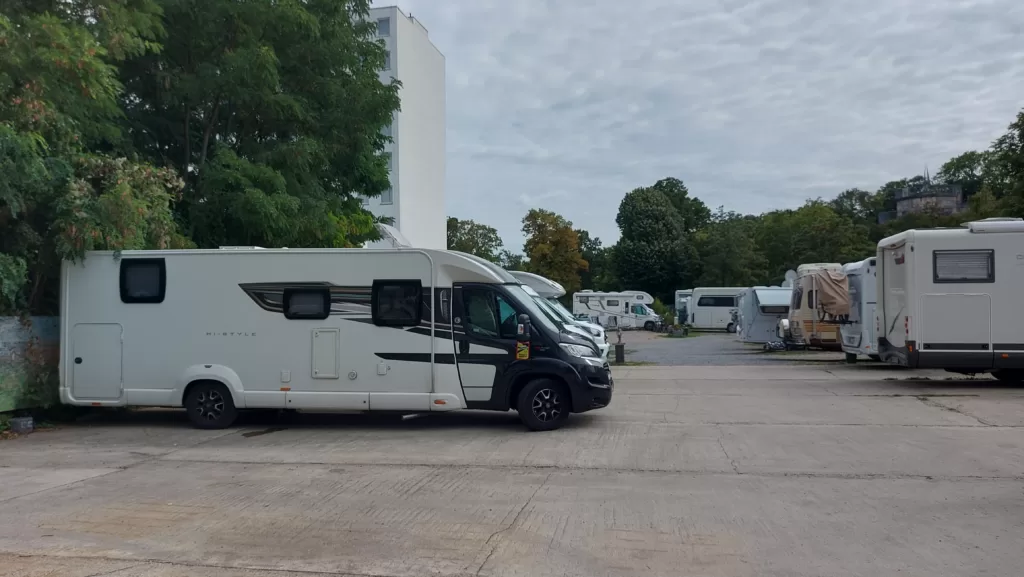
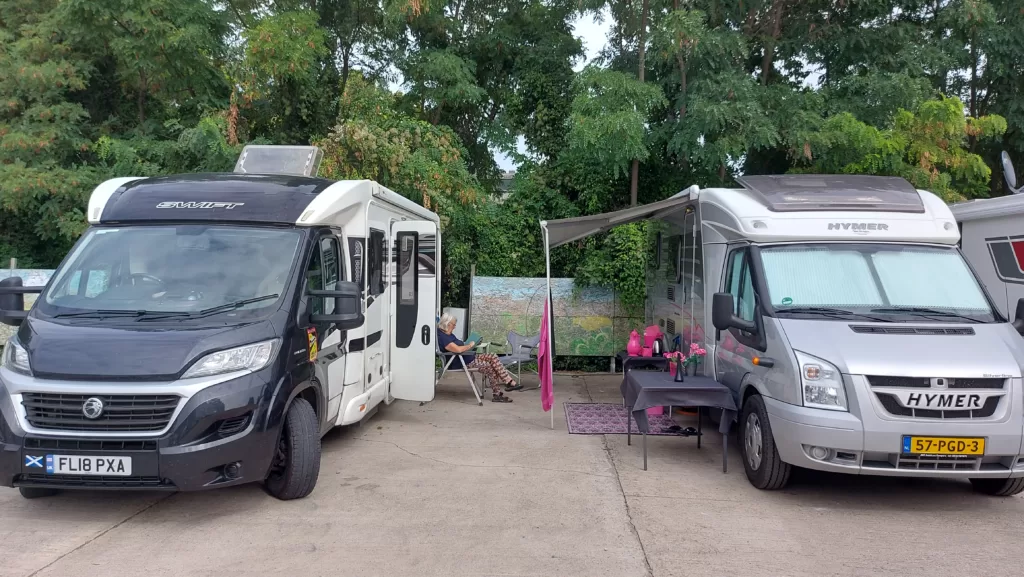
We were allocated a pitch next to a Dutch couple who we chatted to for a while before they cycled off to visit the city centre and we had lunch and relaxed before we headed to a park just across the road from the campsite for a walk up to the top of a hill for a viewpoint over the city. We’ll that was the theory only tall trees blocked the view towards the city centre, although as a bonus, we did get a view of Bessie in the campsite.
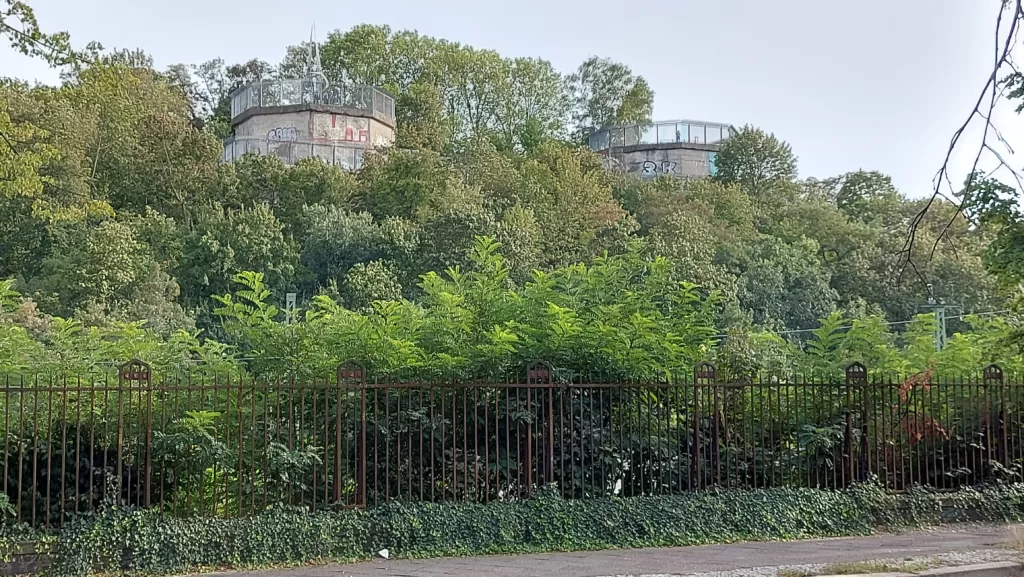


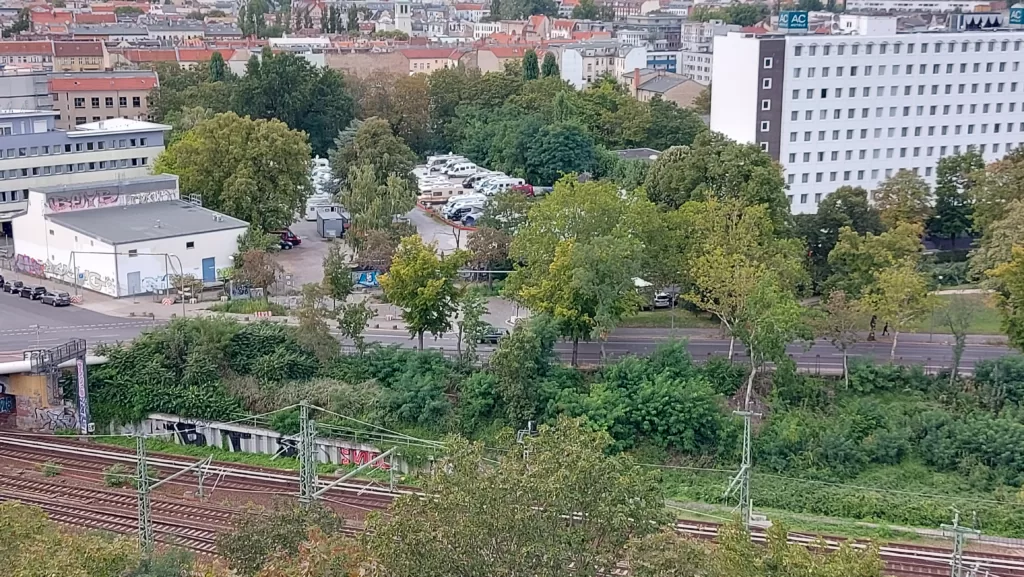
“The monstrous anti-aircraft towers were built in three places in Berlin between 1940 and 1942 to defend the city centre against Allied air raids with heavy guns. Inside the towers there were also shelter for thousands of the civilian population. In the post-war period, the Berlin anti-aircraft towers were blown up by the Allies as military structures. The north side of the Humboldthain anti-aircraft tower remained only as a ruin and then partially disappeared under a “Mont Klamott” made of over 1.5 million cubic meters of rubble.
Behind the hill the park contained a rose garden where people, mostly couples, were chatting on the many benches around the gardens. We walked on and out of the park to the get our bearings at the Underground station where we will start exploring Berlin tomorrow. There is a massive mall here and we had a brief look in before returning to Bessie where we enjoyed dinner sitting outside on what was another mild evening.
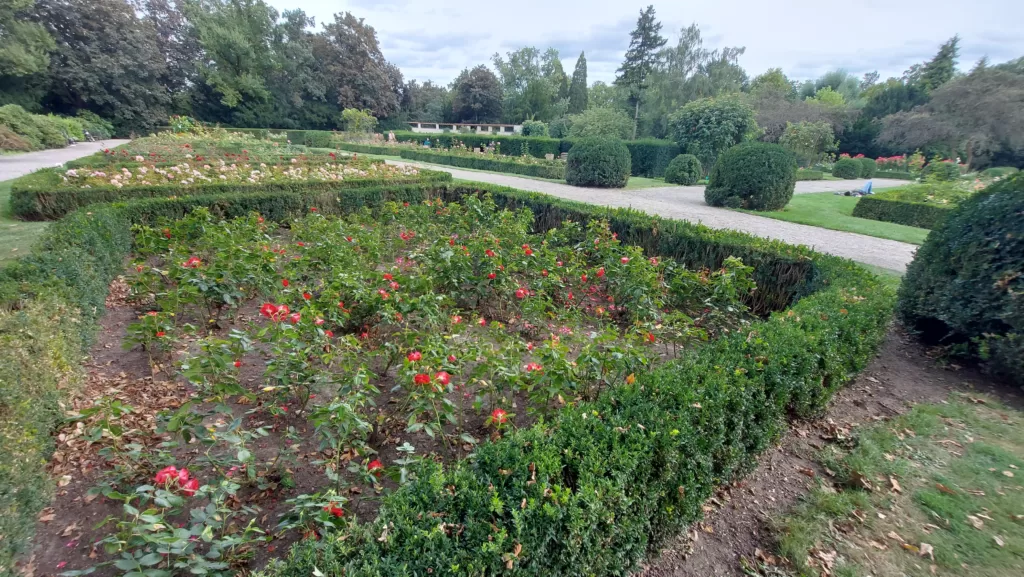
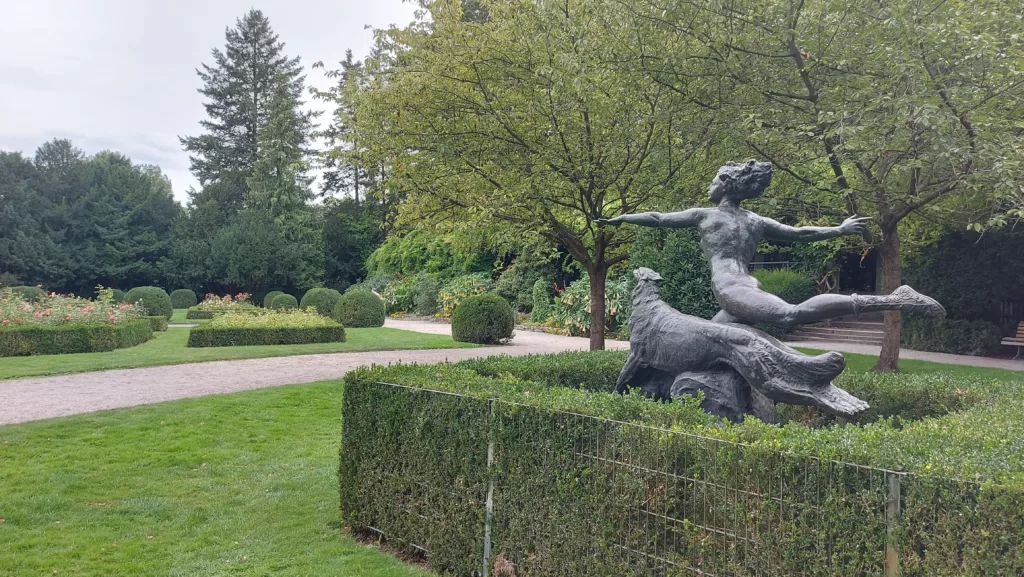
Day 62 – Monday 4th of September
Berlin (0 Miles)
Day 1
September the 4th and the weather is still sunny and warm which is great for sightseeing as there is no chance of rain today. Berlin is the largest city we have visited so we bought 48 hour transport tickets which are valid on the underground, busses and trams and we definitely got our moneys worth today as we hopped on the underground and busses to get around.
First stop was Alexanderplatz, or “Alex”, as Berliners affectionately call it, is the largest square in Germany and the fourth busiest square in Europe apparantly. More than 360,000 people are on the move on Alexanderplatz every day. As well as a tourist attraction in its own right, the square is a shopping mecca too with a variety of shops, malls and department stores of which Primark is one of the biggest.
After a cuppa and a look at the map to get our bearings we walked the short distance to see the TV Tower and the red brick Town Hall, Neptunbrunnen (Neptunen’s Fountain), which were all in the same square.
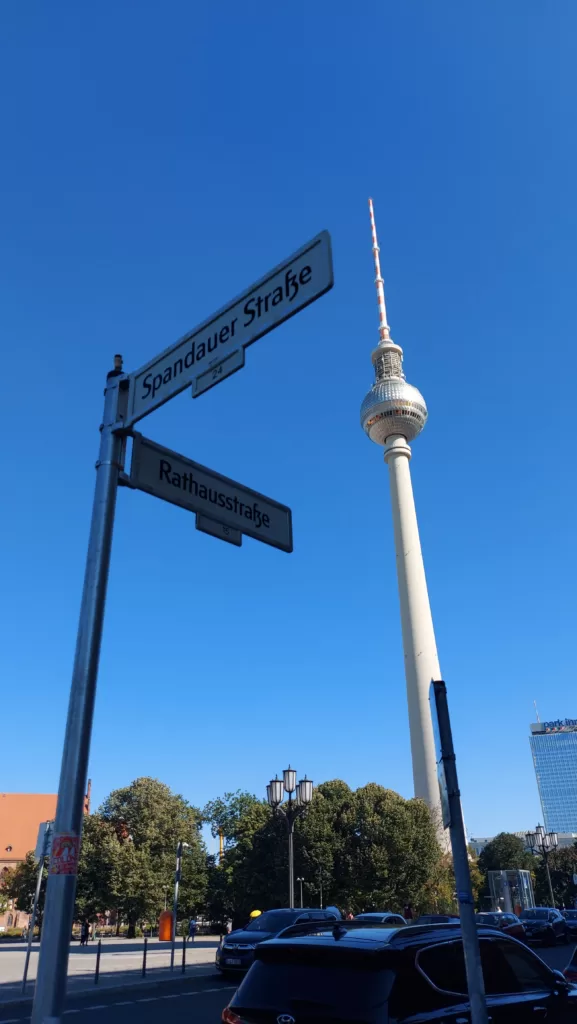

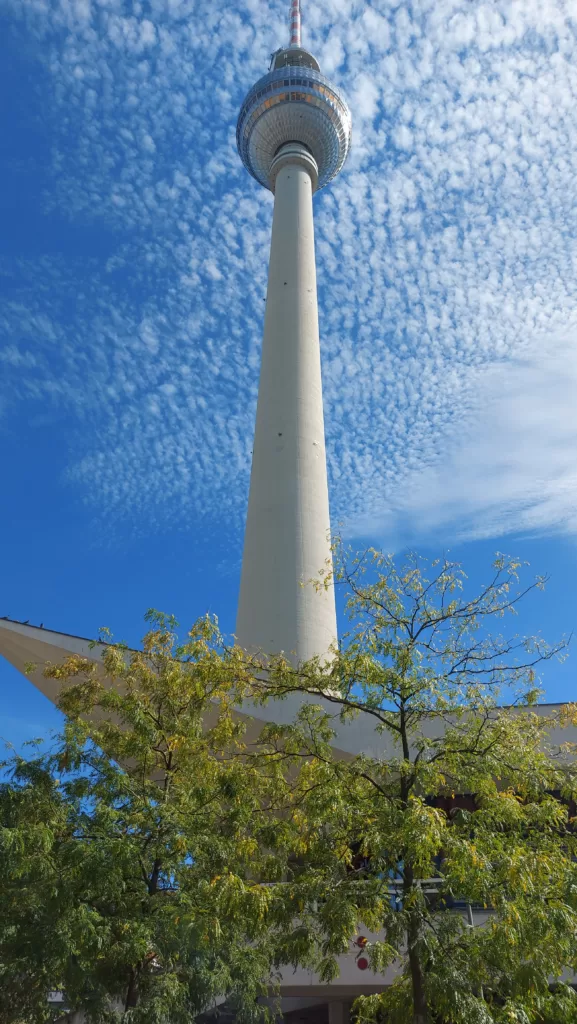
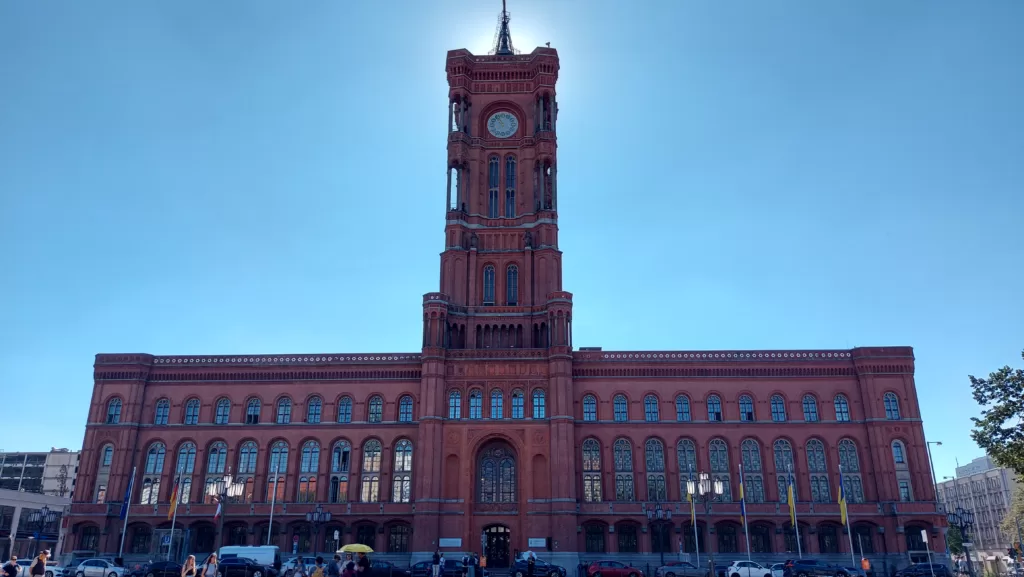
Once we had taken in all of these sights we descended into the underground again to cross the city to the famous Brandenburg Gate which is 26 metres high, 65.5 metres long and 11 metres deep, and supported by two rows of six Doric columns. In 1793, the gate was crowned by the Quadriga statue, designed by Johann Gottfried Schadow.
As befitting the number one attraction in Berlin, if not all of Germany, it was busy with tourists taking pictures, including us of course.
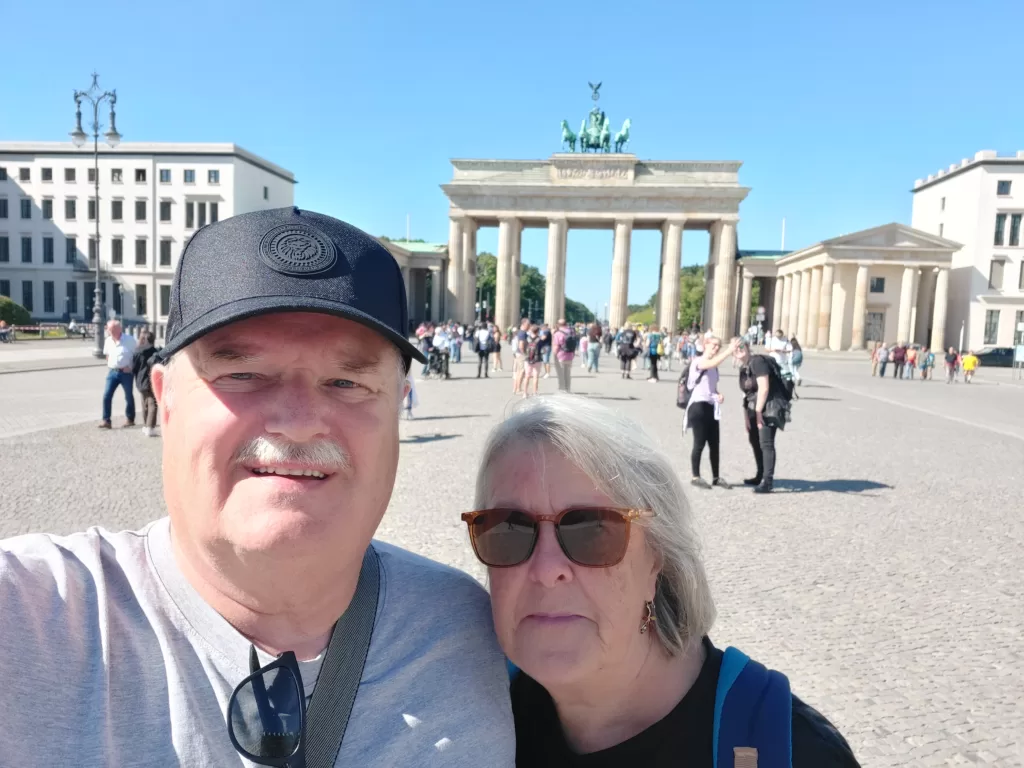
These was a snack stand nearby and it was too difficult to resist a bratwurst in a bread roll topped with tomato sauce, two of the most iconic symbols of Germany, the Brandenburg Gate and a bratwurst on a roll!
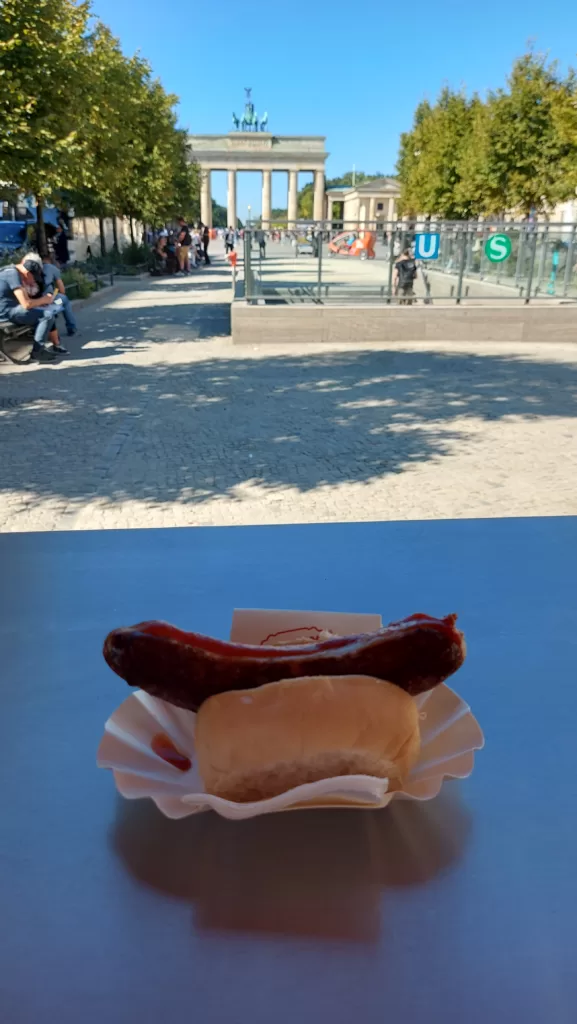
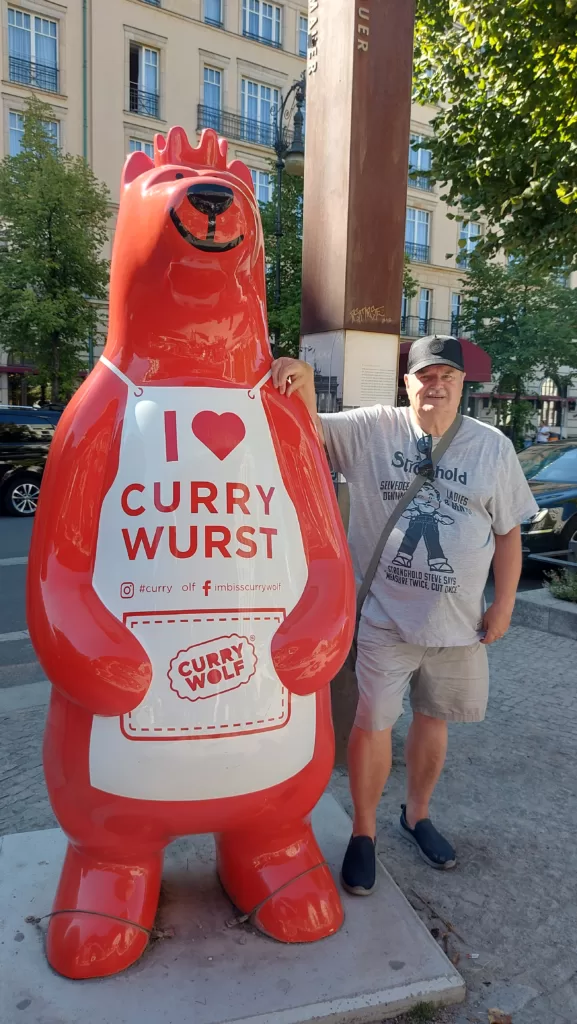
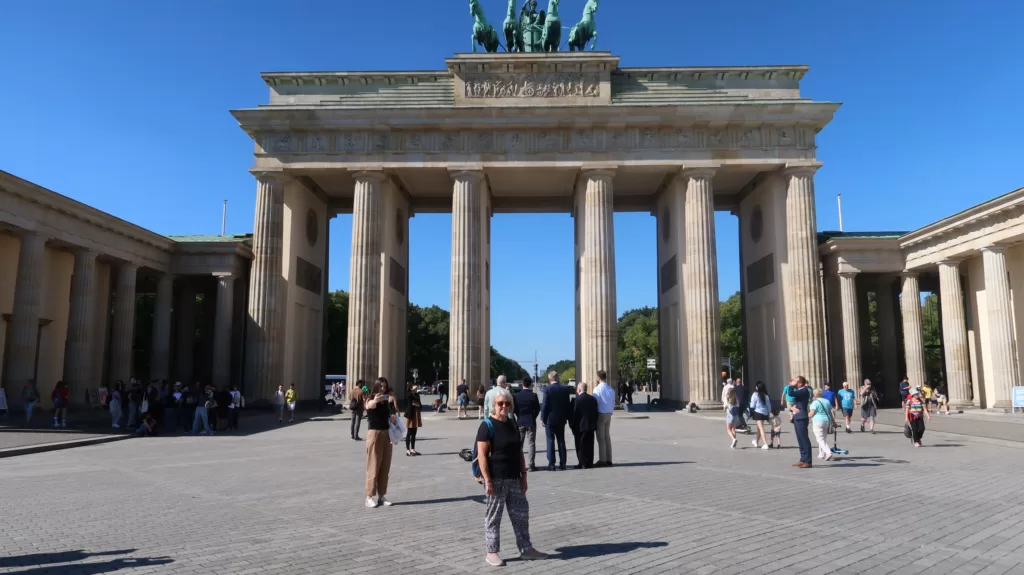
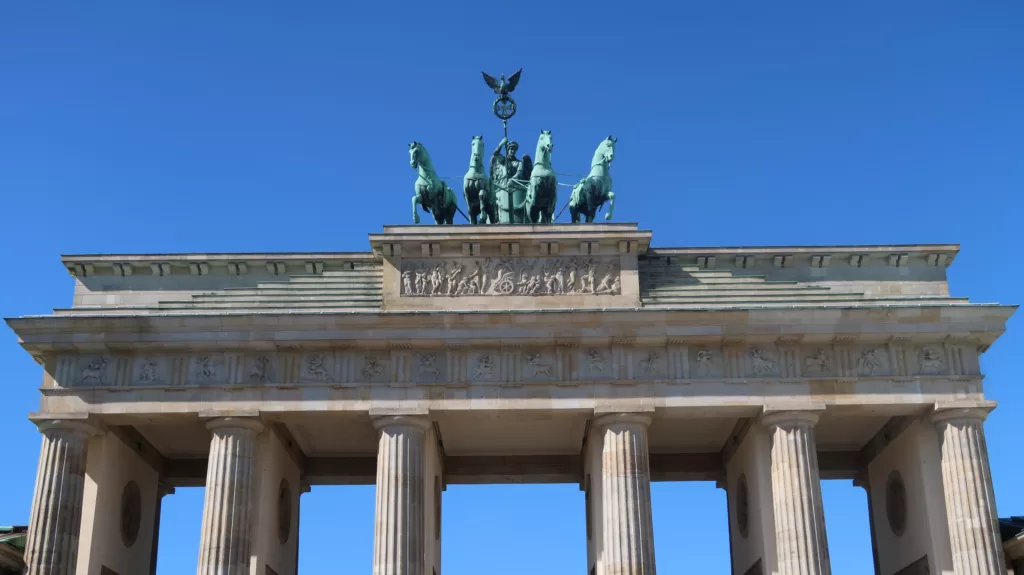
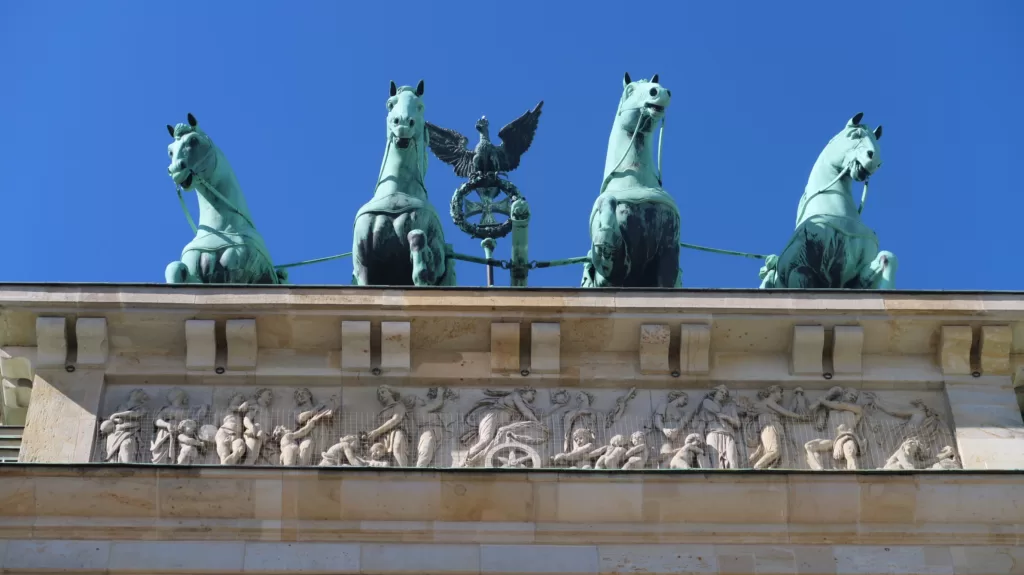
There is a room under one of the arches called the Room of Silence on the right side of the Brandenburg Gate. Here you can rest in the soothing, simply decorated room and have time to think, relax, to rest or to meditate and consider this historically significant place. There were no cathedrals or churches on the itinerary today so The Navigator was straight into the room for some contemplation!
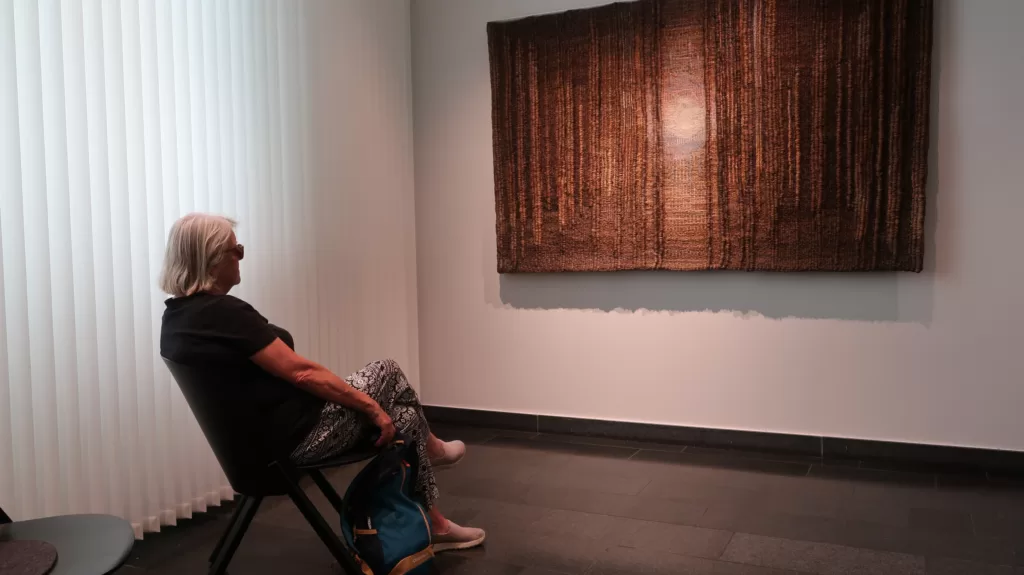
It is only a few minutes walk from the Brandenburg Gate to the Bundestag, the modern day (from 1949) German parliament and not to be confused with the Reichstag which was the former parliament of previous regimes, like the German Empire and the Third Reich. This building was heavily damaged by Allied bombing in WW II and was renovated from 1994 to 1999 to plans by British architect, Sir Norman Foster.
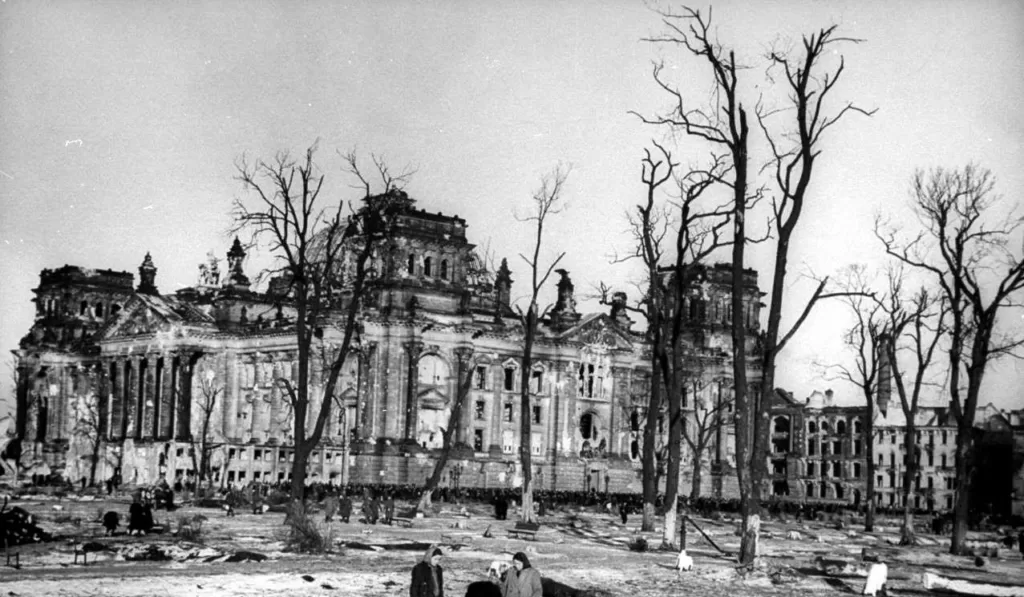
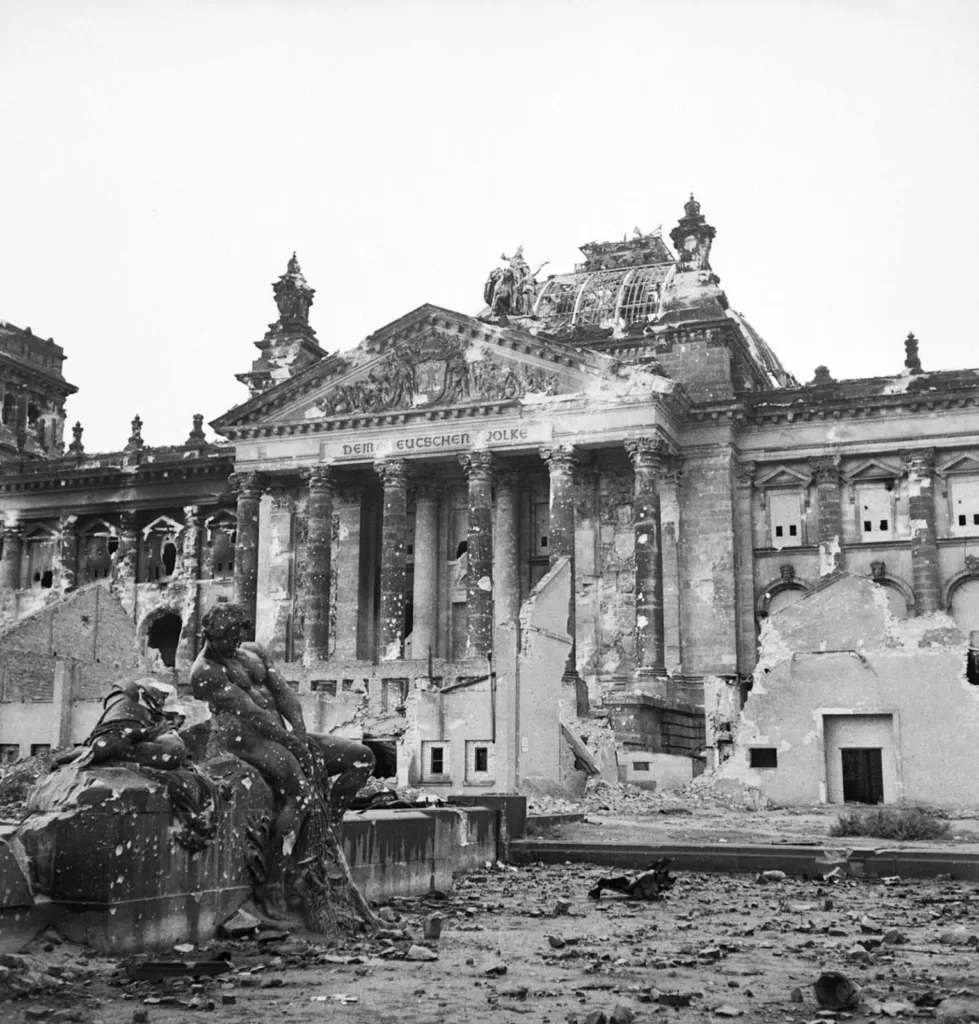
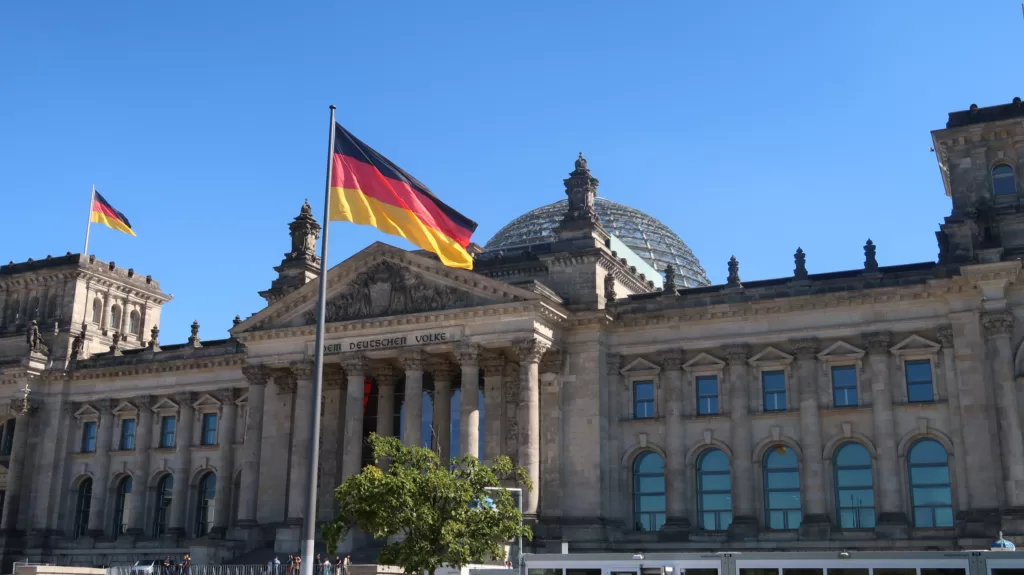
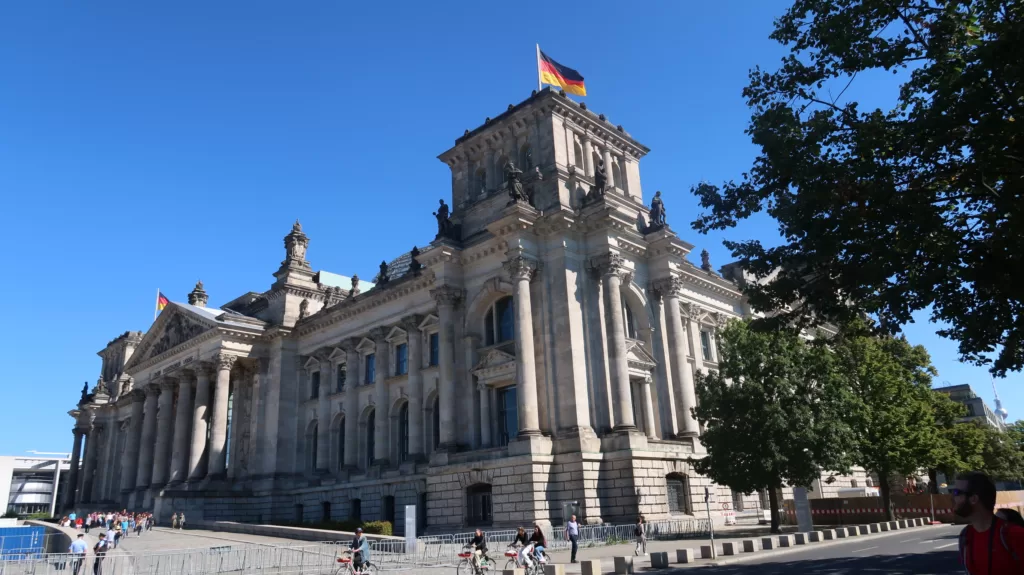
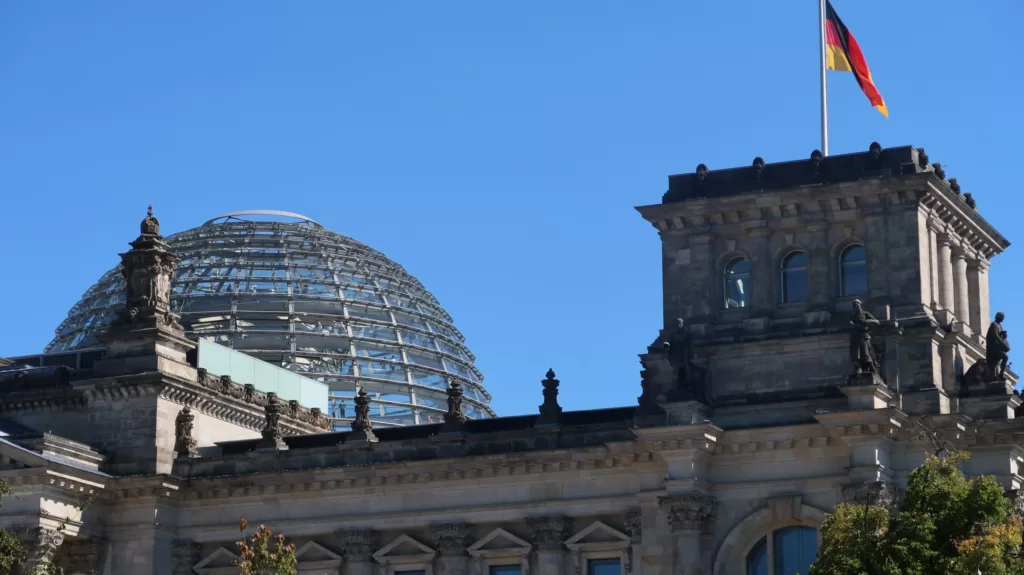
There is an area in front of the Bundestag commemorating the Roma and Gypsy population who perished in WW II which was well attended and respected.
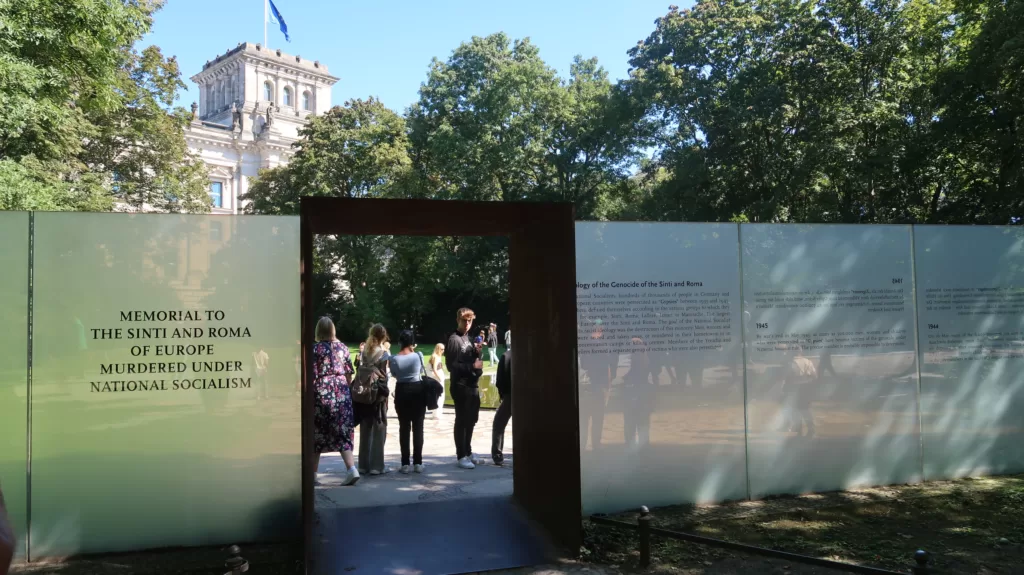
We then took a bus the short distance to see a nearby monument which turned out to be a Carillion, only the second we have seen after the one in Loughborough.
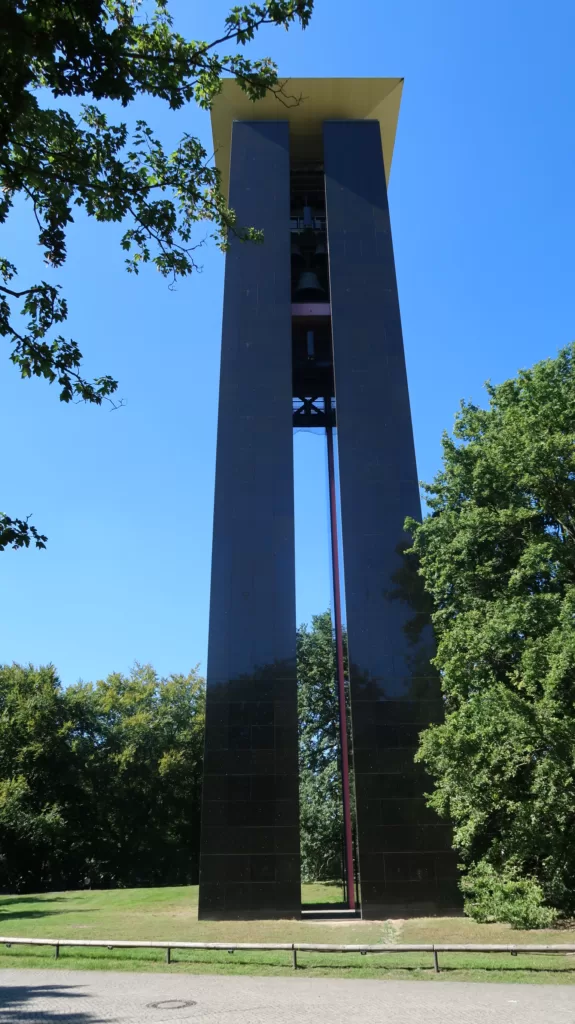
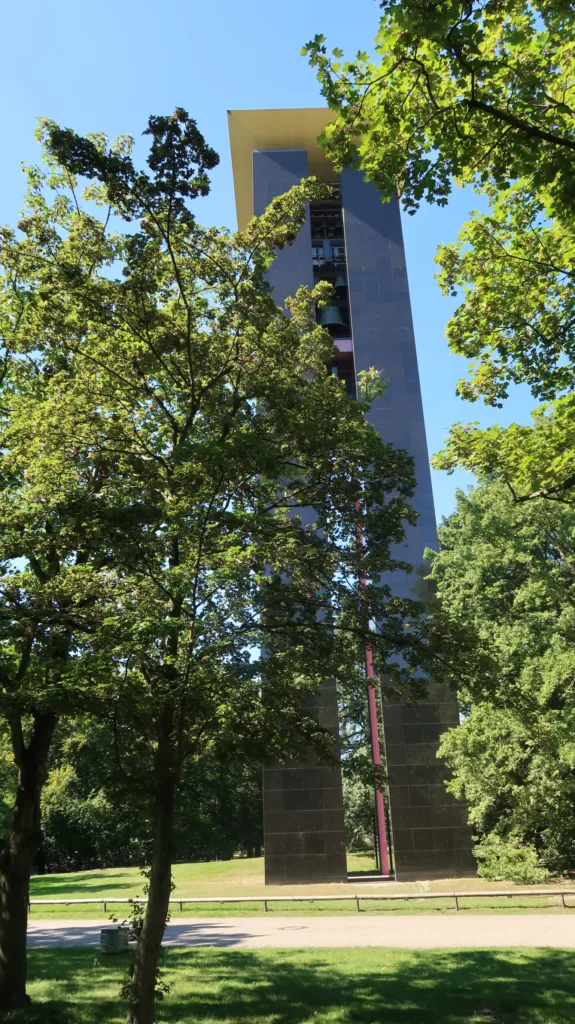
Undecided what we should have for lunch we took a bus all the way back to Alexanderplatz and one of the malls where we shared two different dishes at the food court.
After the late lunch we decided to only see one more sight and Checkpoint Charlie was chosen, so another subway journey and a short walk took us there. Checkpoint Charlie was the best-known border crossing between East and West Berlin during the Cold War. At the height of the Berlin Crisis in 1961, American and Soviet tanks faced each other here.

The former border crossing Checkpoint Charlie is one of the most important and most visited sights in Berlin and we were surprised that with all tourists who come here to see this historical site that the road is still used by traffic.
There are many display boards explaining the significance of this border crossing and also many shops selling overpriced souvenirs, including chunks of the Berlin Wall. Today there are no American tanks here but only a few yards from Checkpoint Charlie is the all conquering McDonalds which we frequented for a coffee, but no tea as they only had Earl Grey, which doesn’t lend itself to milk and saccharin.
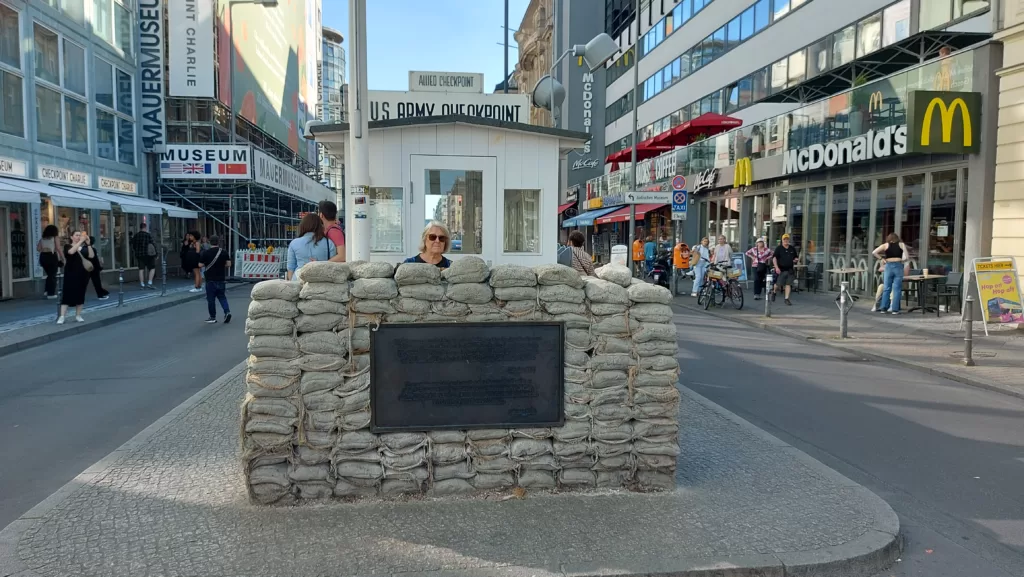
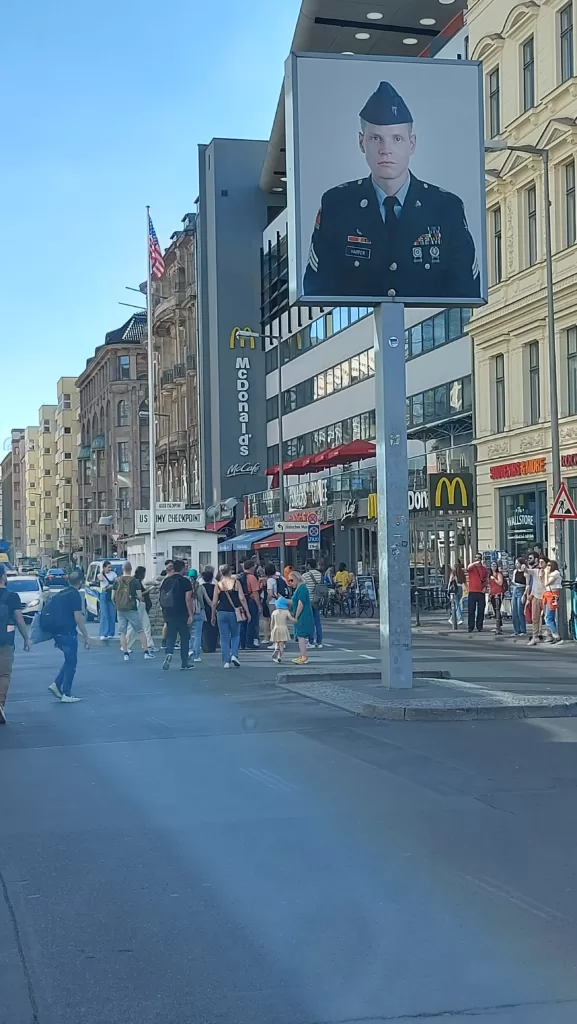


With the intense heat again taking its toll, we decided to call it a day and take the underground back to Bessie which was not so easy as the nearest underground station wasn’t on the line we needed. Eventually we made it back to the shade of Bessie and sat outside until it began to get dark around eight o’clock.
Day 63 – Tuesday 5th of September
Berlin (0 Miles)
Day 2.
We had ticked off some of the top tourist ‘must see’ attractions yesterday so today there were a few more to see and first on the list was a section of the Berlin Wall that has been preserved and has information boards and a nearby museum.
The Berlin Wall was 96 miles in length (27 miles within Berlin), and two walls rose between 11 and 15 feet high. Between them was a 160-foot “death strip.” The wall included 302 watchtowers, 20 bunkers, 55,000 land mines, 259 dog runs, and machine guns activated by tripwires.
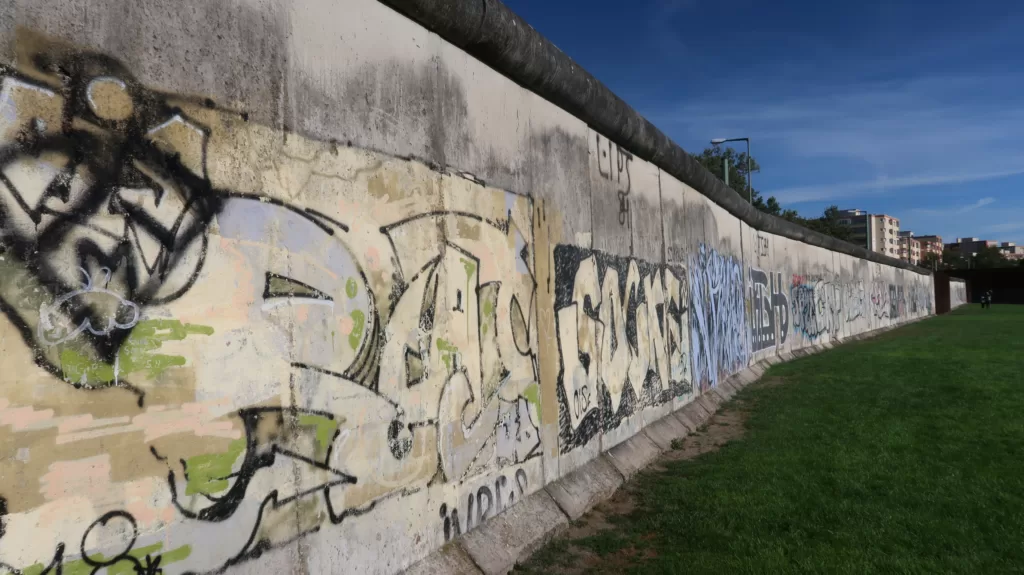
There is a lot to see and take in here and we spent a good couple of hours reading up on what exactly happened in this exact location in our own lifetime. There was a gardener strimming the grass around slabs denoting the direction of an underground escape tunnel running from the east to the west sector and it jogged our memory that we had seen a film about this event, but the details are lost on us now…
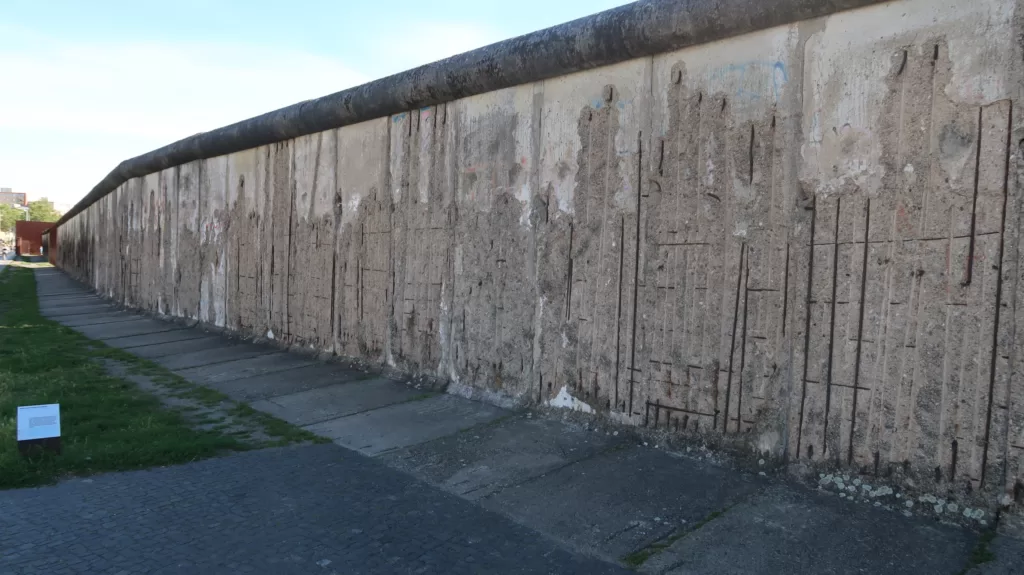
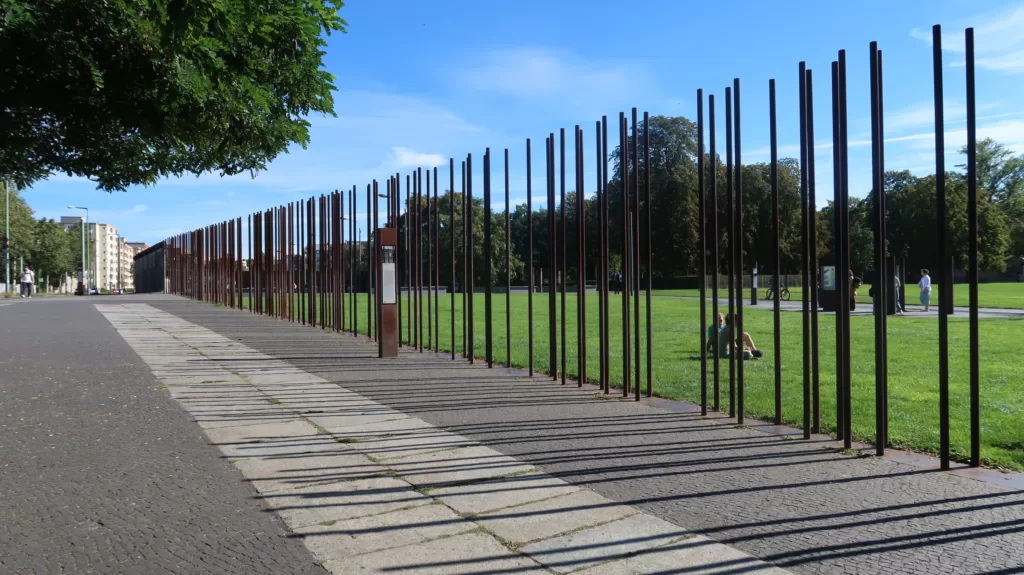
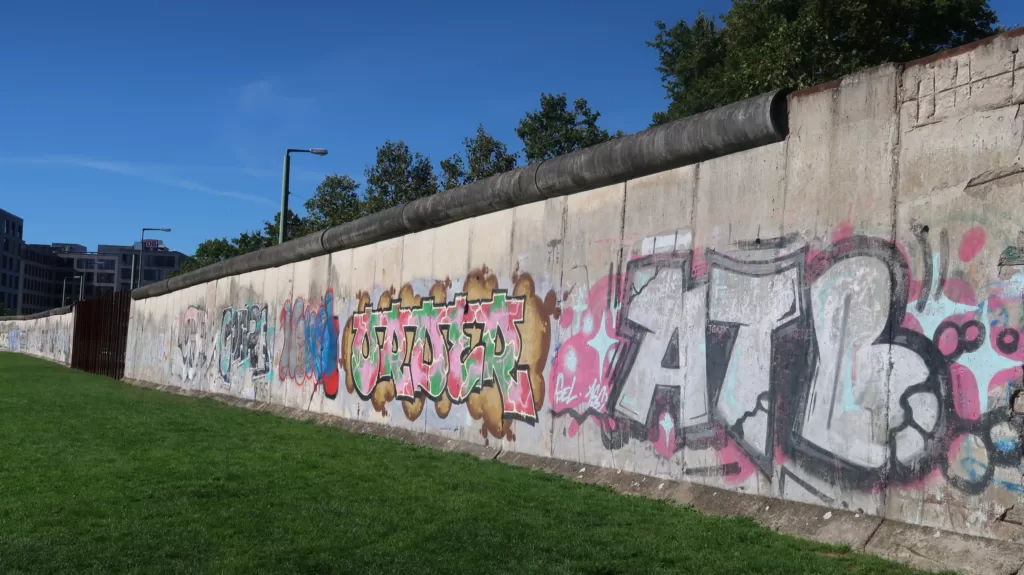
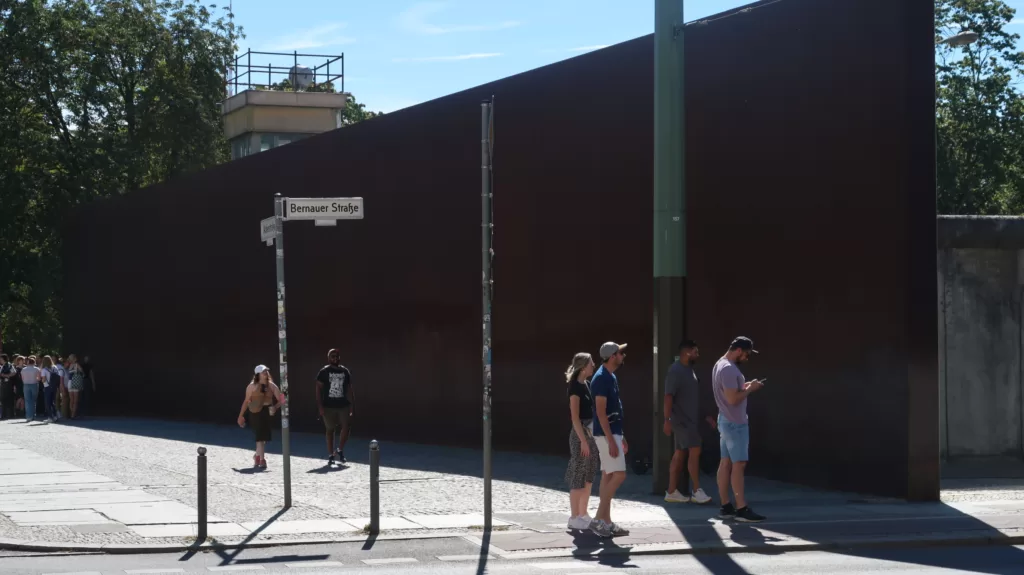
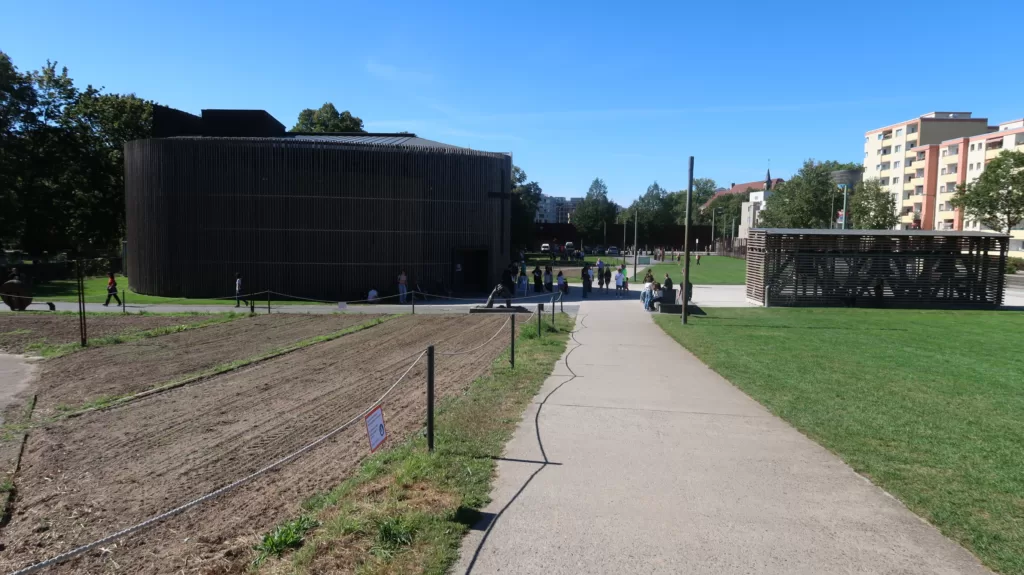
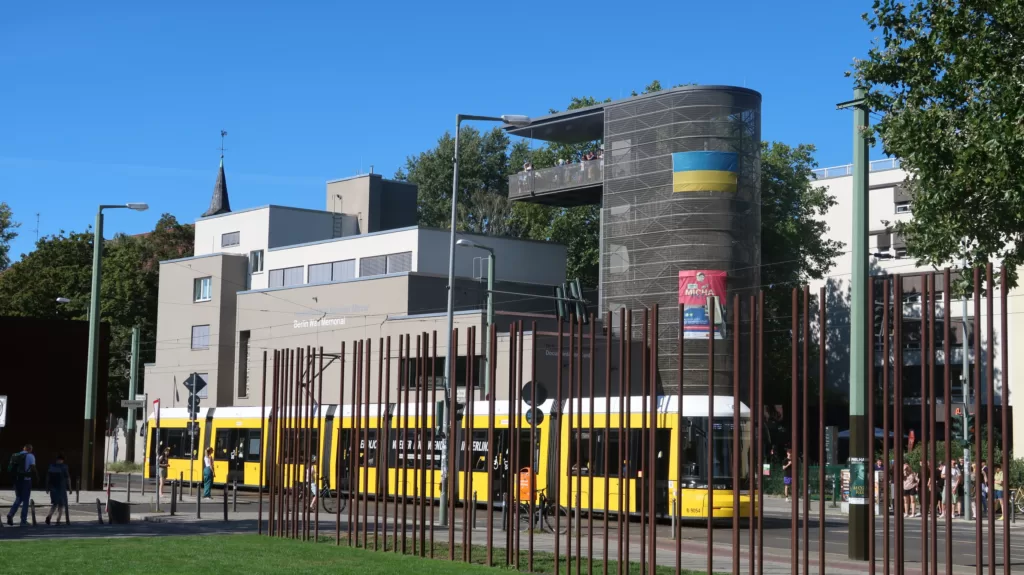
The folly of our past is highlighted in the following picture where young children are playing on the “death strip” and having fun on a spot that not so long ago, certainly in my lifetime, was a minefield to separate the communities of east and west Berlin.
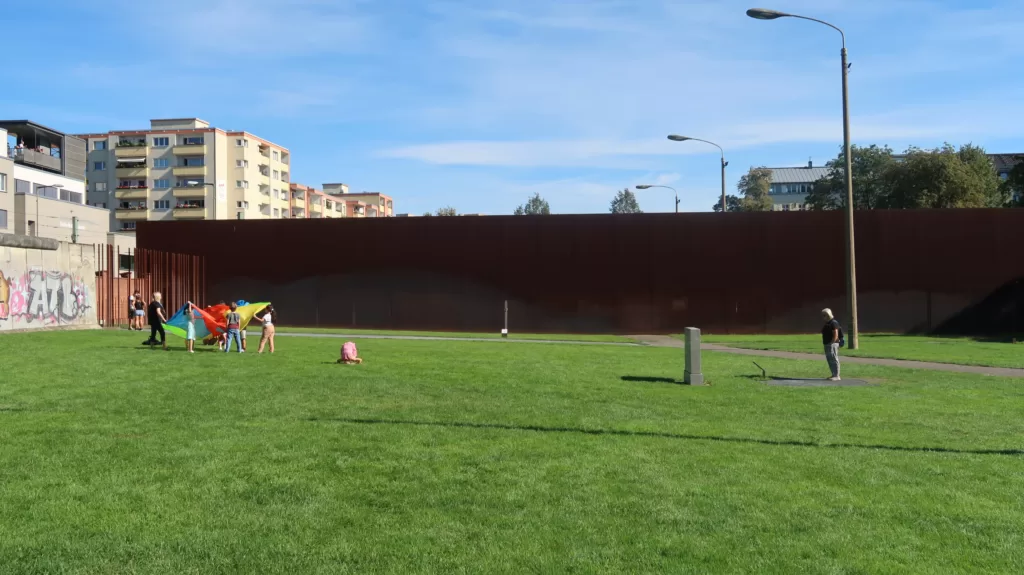
There is a memorial showing the pictures of those of all ages who were killed trying to escape over, through or under this wall.
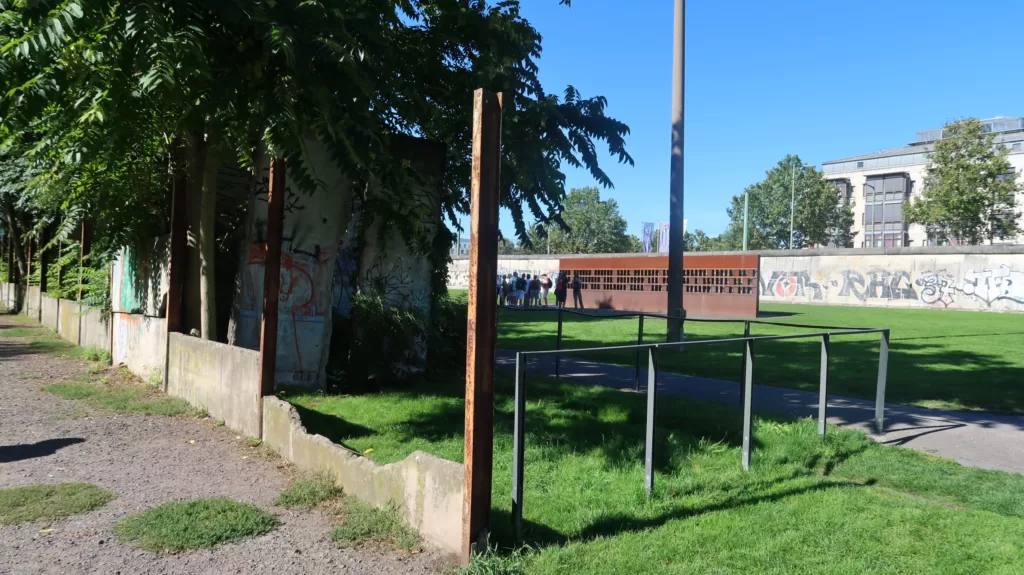
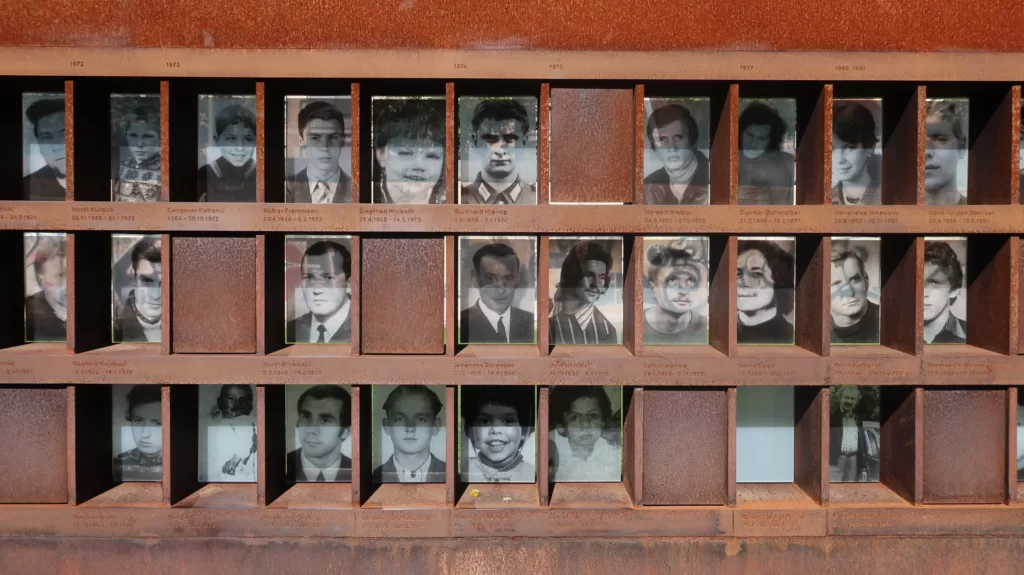
It was lunchtime by now and we decided to head into the city centre on the underground and the line we were on took us to where we were yesterday at the Brandenburg Gate so we had Currywurst and fries at the same kiosk where I had my Bratwurst yesterday. I’m a ketchup person and The Navigator prefers mayonnaise on her chips!
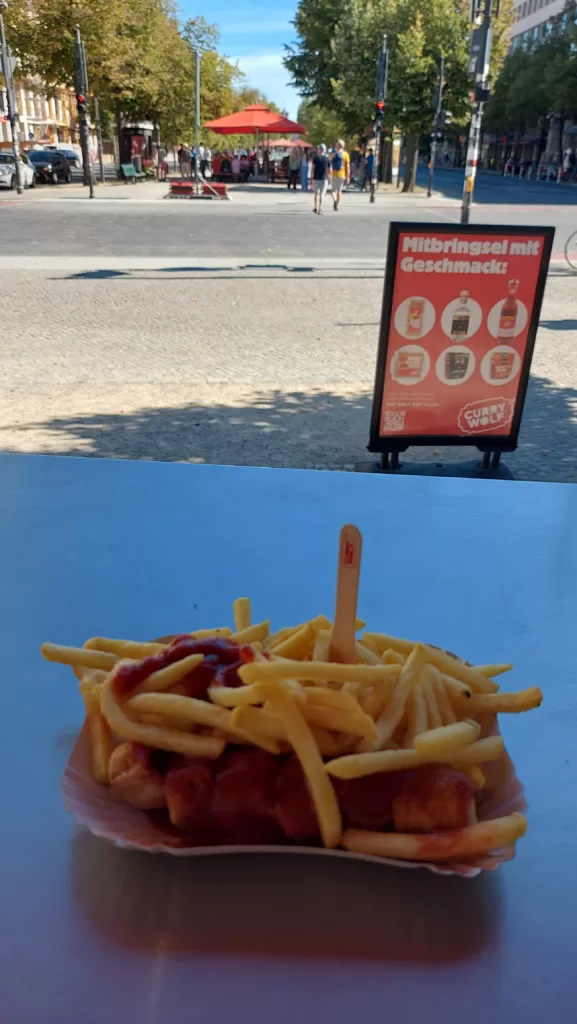
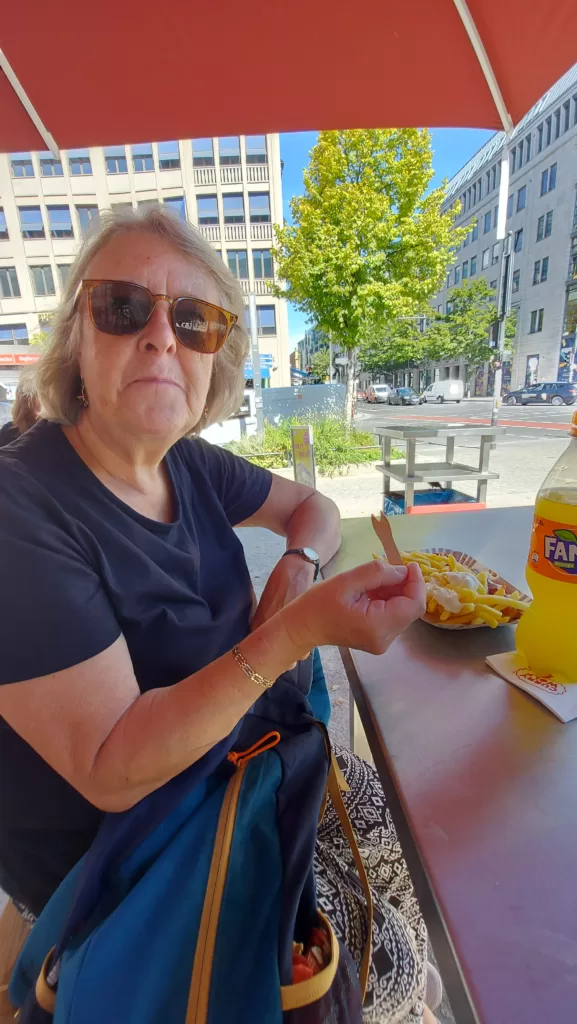
From there we walked in the baking heat up Unter den Linden, the route we took in the bus yesterday, to see all the impressive buildings we saw on that journey. First was the British Embassy, which was quite impressive given it was a modern building and not far away was the Russian Embassy which had barriers erected to stop anyone walking on the pavement outside it, apart from a police woman.

There were other impressive buildings to be seen, some German Government and some Embassies which had been restored in the years after the war.
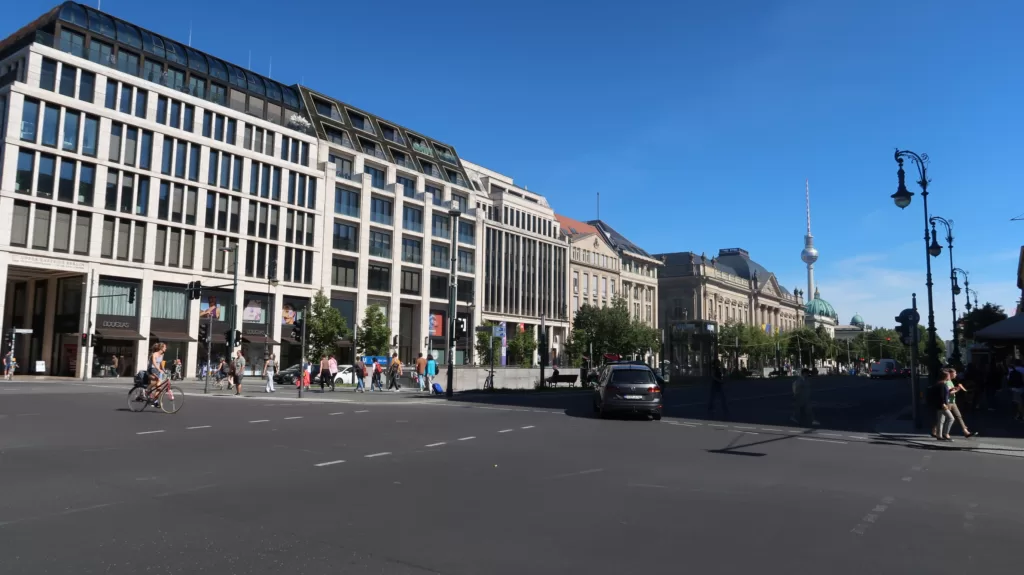
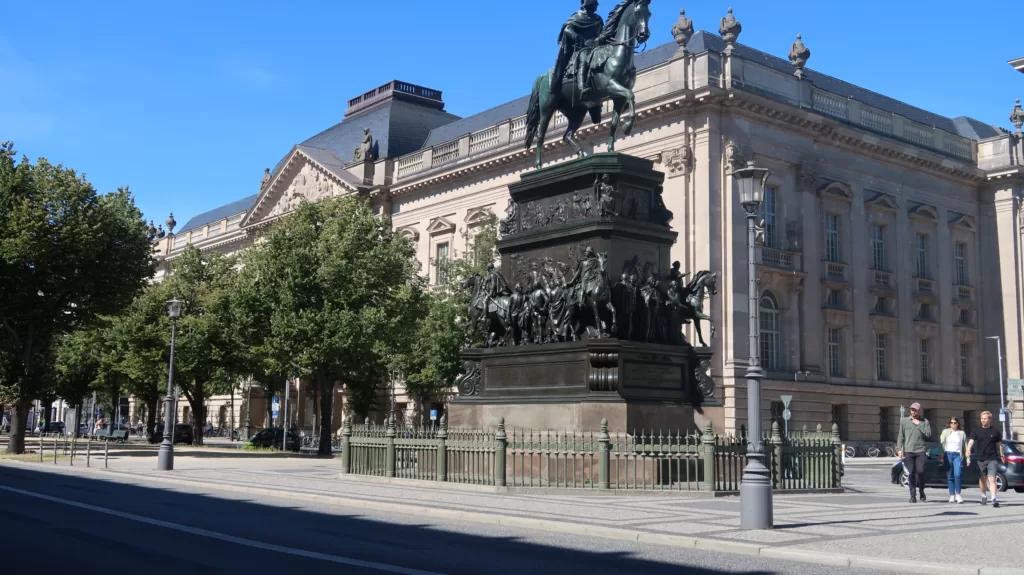
One of the sights we had read that was not to be missed was the Gendarmenmarkt, which is acclaimed as one of the most stunning squares in the city, located close to Friedrichstrasse, Berlin’s exclusive shopping street. It would be fair to say that Gendarmenmarkt was not looking at its best today as the following picture will attest!
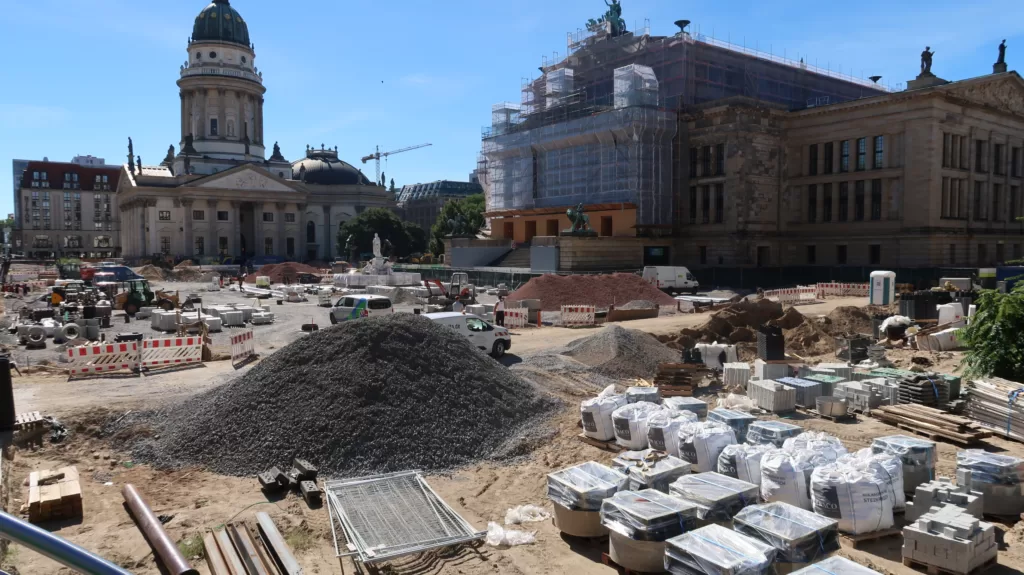
Due to this construction work, the Berlin Christmas market will be held on nearby Bebelplatz from 2022 to 2024. Every year, the Christmas market attracts around 800,000 visitors to the historic setting on Gendarmenmarkt, but not this year!
Bebelplatz was at least restored but looked as though it needed a market or some event to bring it to life.

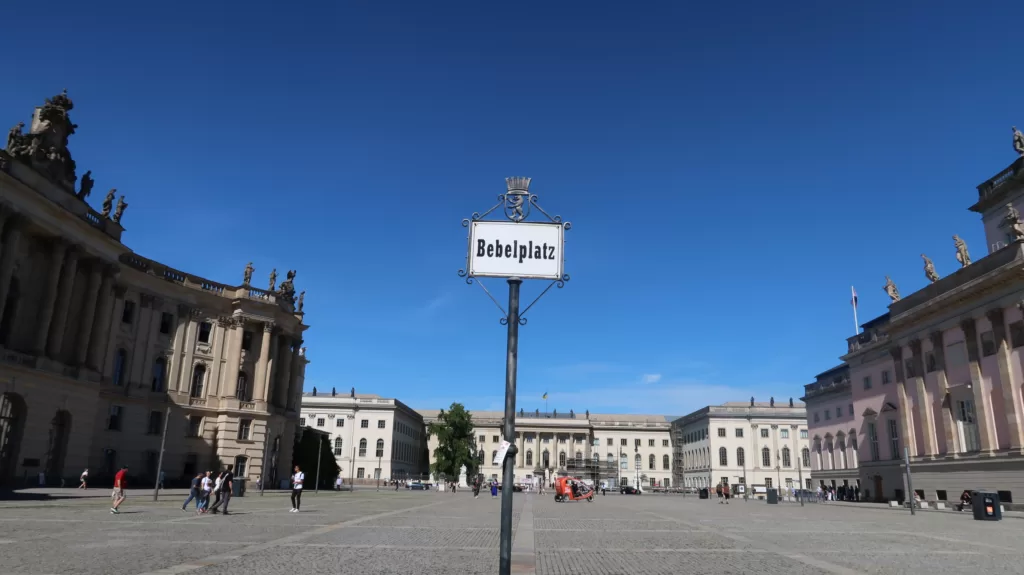
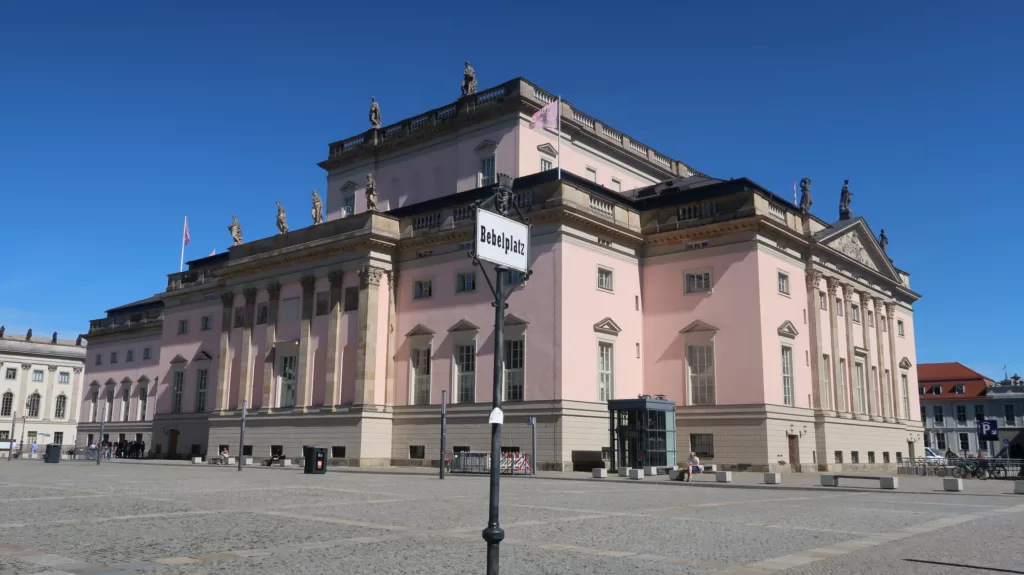
On the other side of Unter den Linden was a distinctive restored building called the Neue Wache, described as a “moving memorial to war dead” but it left The Navigator decidedly unmoved as it was a bit too stark and uninspiring for her liking.
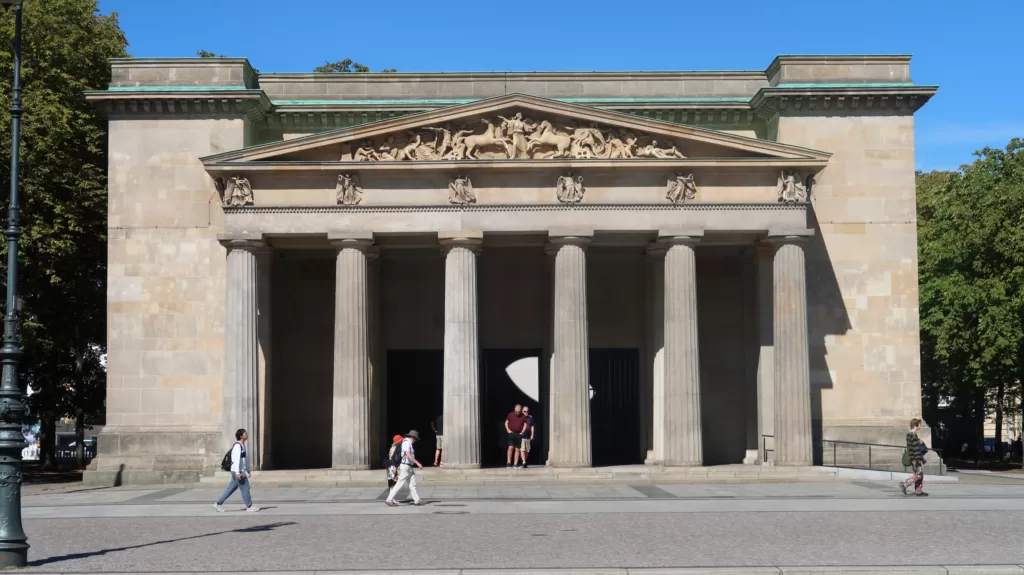
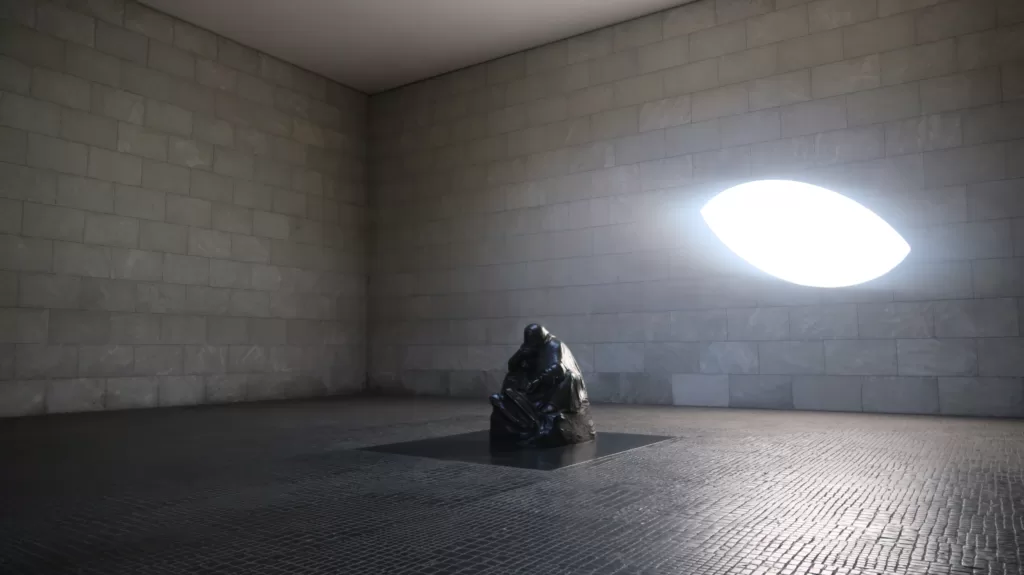
There were quite a few museums in this area and the one that took the eye was the oldest building on this Strasse, the pink Zeughaus, a history museum.
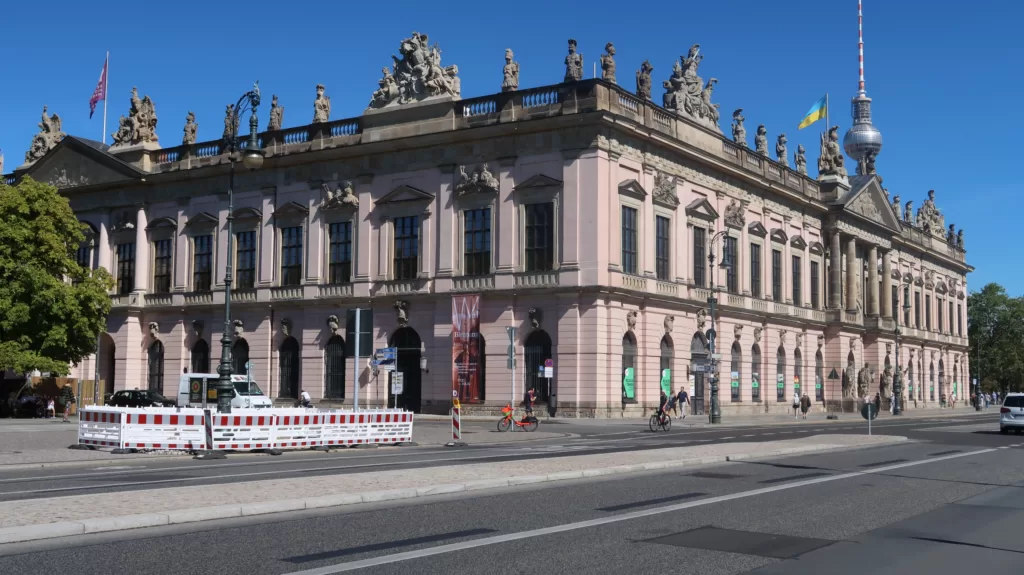
The river Spree and the Spreekanal flow through this area and boat trips are available on the jetties here.
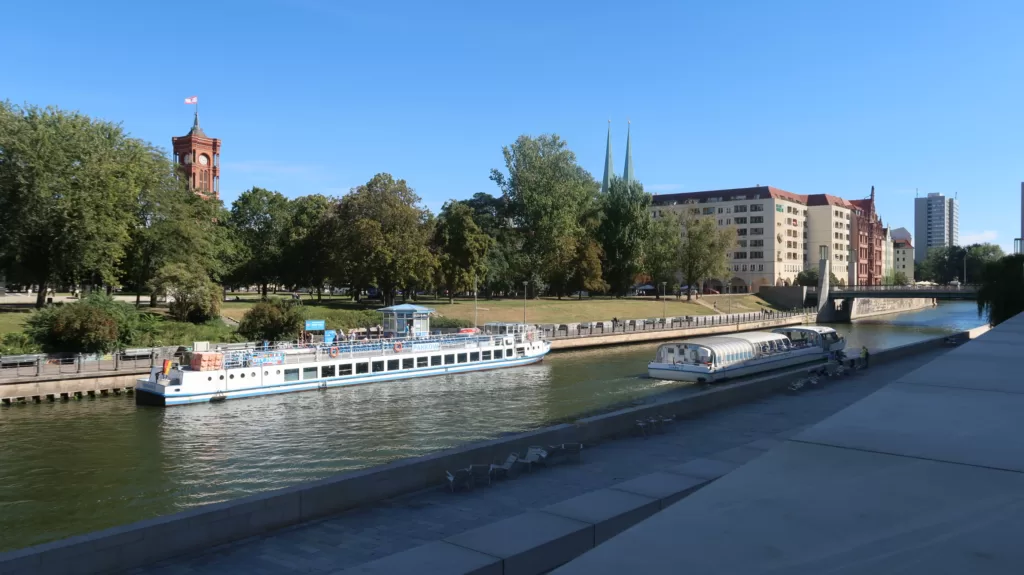
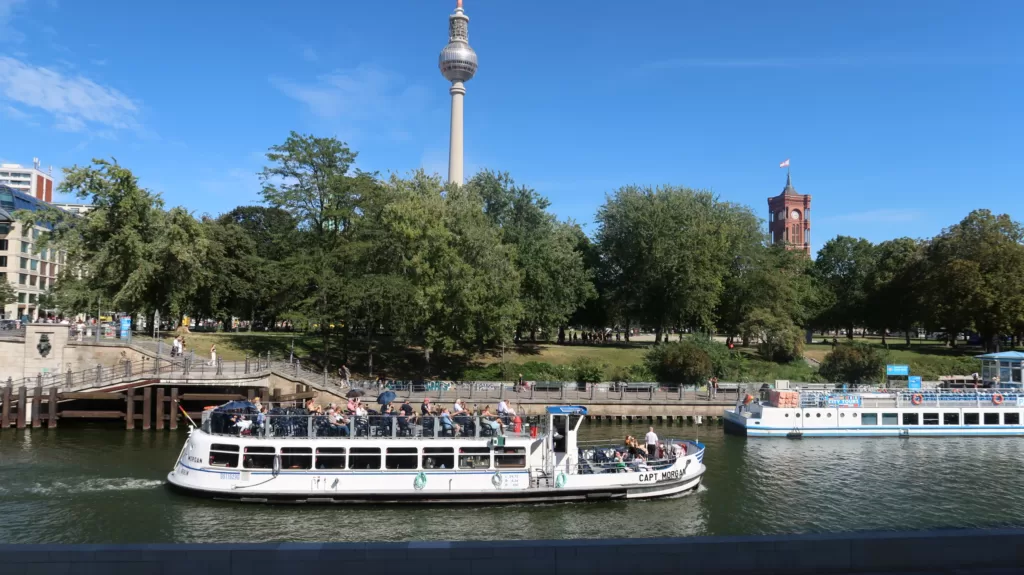
The other major attractions that we just don’t have the time to see are all the museums and they are certainly housed in very impressive buildings.

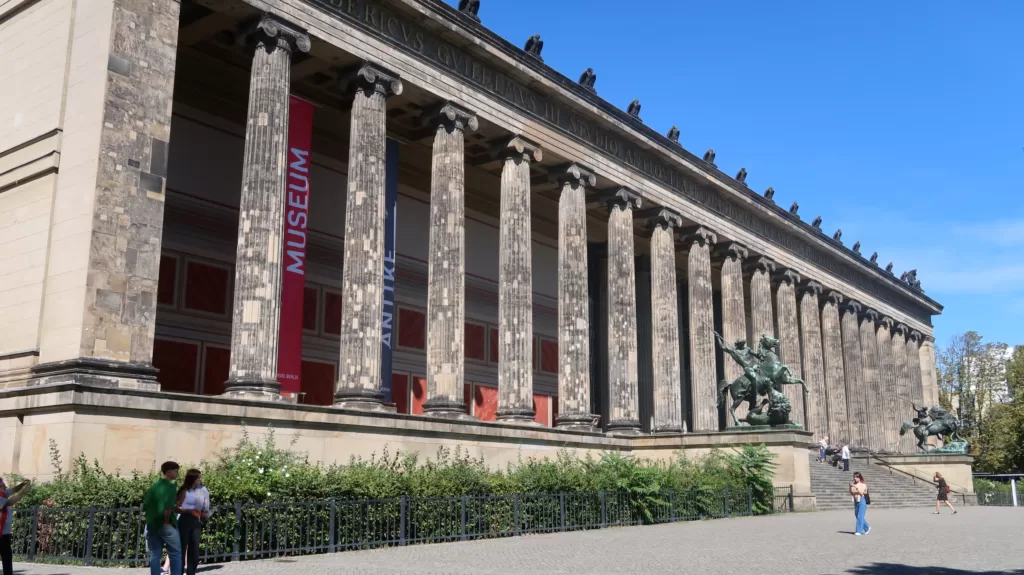
Another impressive building in this area is the Berliner Dom, (Berlin Cathedral) which is a monumental German Protestant church and dynastic tomb (House of Hohenzollern) on the Museum Island in central Berlin. The present collegiate church was built from 1894 to 1905 by order of Emperor William II and the listed building is the largest Protestant church in Germany and one of the most important dynastic tombs in Europe. In addition to church services, the cathedral is used for state ceremonies, concerts and other events.
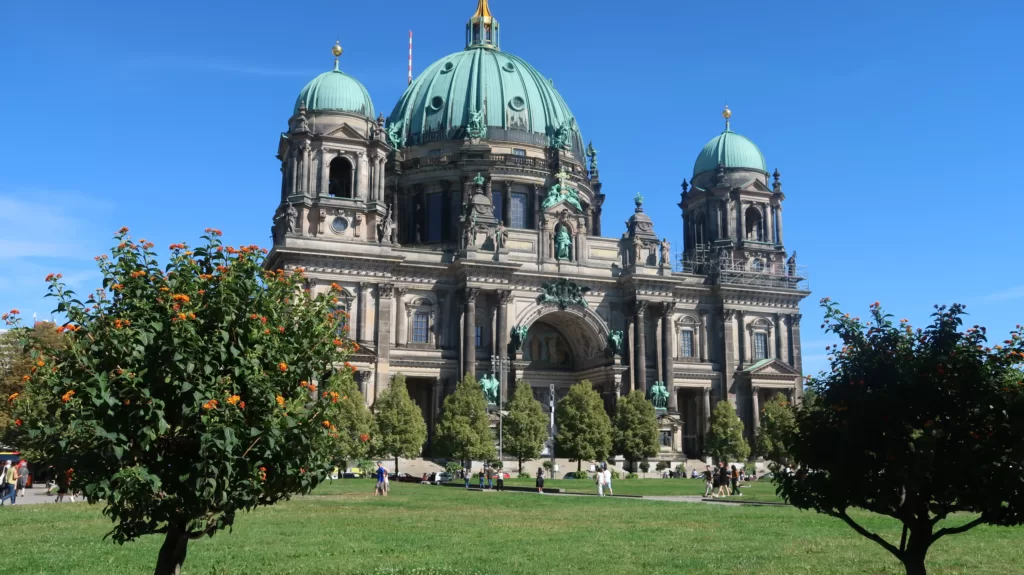
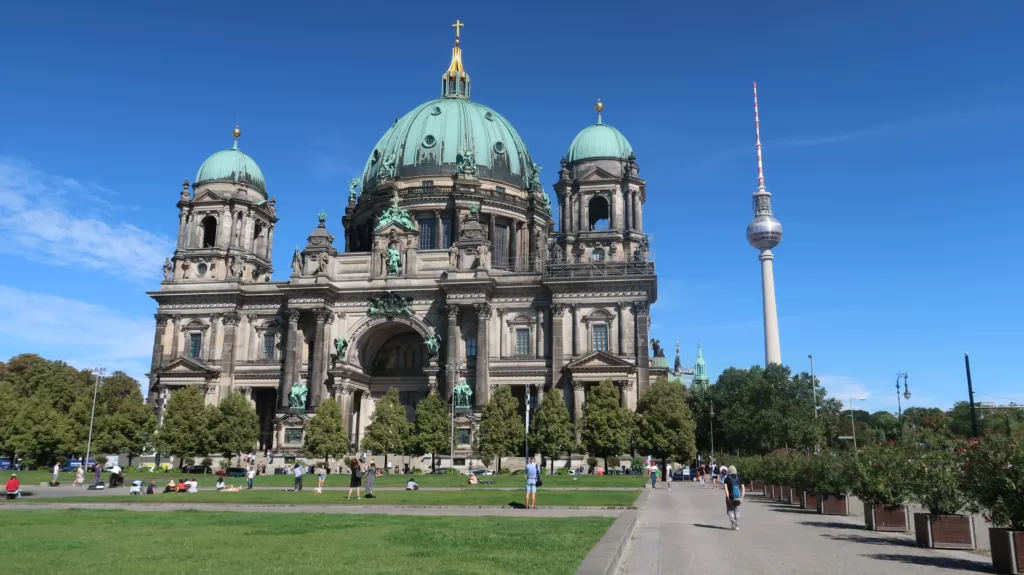
The heat and all this walking were taking its toll, as it usually does around the middle of the afternoon so we headed on towards the nearby Alexanderplatz again and, you guessed it, to Tchibo for two of their finest black teas and a slice of cake.
Like the other major European capital cities of London, Madrid, Paris and Rome, two days is never enough to see everything you want to, but we came, we saw, and while not conquering Berlin, we saw what we wanted to see in the time available to us. We could of course have stayed longer but the stellplatz is the most expensive we have been on this whole trip and is not worth what we are paying. It’s obviously cheaper than a hotel would be, but with a terrible internet signal limiting what I can do online, it is time to move on tomorrow.
Of all the major cities and capital cities we have visited on this trip, Berlin is probably the least likely we would revisit. Yes the buildings are grande, and so much history has been enacted out here, but it is quite dirty and gives the impression it is uncared for. For anyone wanting to visit Berlin you should come and make your own mind up but learning a few words of German would help, but probably Turkish or Syrian would be of more use as they seem to outnumber the native Germans!
Day 64 – Wednesday 6th of September
Berlin to Potsdam (52.412256, 13.028651) (25 Miles)
We are in no hurry this morning as Potsdam is only 25 miles away and I want to visit a nearby cycle shop to try and buy a bike pedal as a replacement for the one that I broke back in Vilnius.
“Potsdam is the capital and largest city of the German state of Brandenburg and is part of the Berlin / Brandenburg Metropolitan Region. Potsdam sits on the River Havel, a tributary of the Elbe, downstream of Berlin, and lies embedded in a hilly landscape dotted with many lakes, around 20 of which are located within Potsdam’s city limits. It lies some 25 kilometres (16 miles) southwest of Berlin’s city centre.”
“Potsdam was a residence of the Prussian kings and the German Emperor until 1918. The city, which is over 1,000 years old, is widely known for its palaces, its lakes, and its overall historical and cultural significance. Landmarks include the parks and palaces of Sanssouci, Germany’s largest World Heritage Site, as well as other palaces such as the Orangery Palace, the New Palace, Cecilienhof Palace, and Charlottenhof Palace. Potsdam was also the location of the significant Potsdam Conference in 1945, the conference where the three heads of government of the USSR, the US, and the UK decided on the division of Germany following its surrender, a conference which defined Germany’s history for the following 45 years.”
I had success with buying the replacement pedals so we happily set off for the shortish drive to Potsdam in another scorcher of a day. The site was easy enough to find and the only negative about it is the lack of electricity points as we could do with charging up our electric bikes now that we can use them again.
On the other hand with so much free sunshine Bessie’s leisure batteries are getting charged up via the solar panel.
Day 65 – Thursday 7th of September
Potsdam (0 Miles)

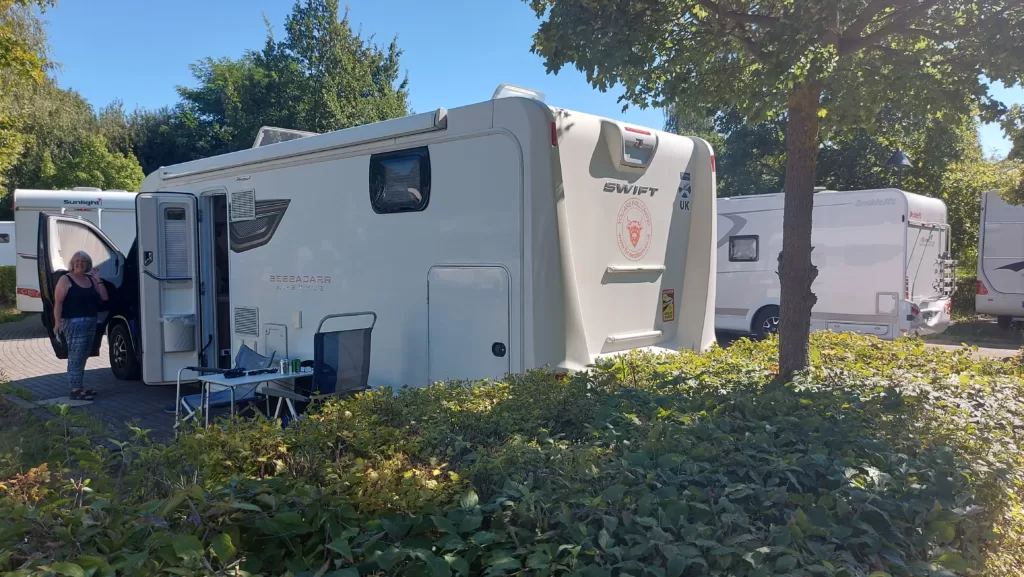
The batteries on both bikes are flat but we set off to explore the nearby Palaces and Parks of Potsdam, which covers about 1,235 ares of parkland and encompass 150 buildings dating from 1730 to 1916. It was the King of Prussia, Frederick the Great (1712 – 1786) who built his summer palace, Sanssouci on this site and it served as his primary residence and private refuge. It is often counted among the German rivals of Versailles but Sanssouci is little more than a large, single-storey villa—more like a small chateau than Versailles.
As well as Sanssouci, Frederick had numerous temples and follies built in the surrounding park and it was built to meet his need for a private residence where he could escape the pomp and ceremony of the royal court in nearby Berlin, emphasising that the palace was meant as a place of relaxation, rather than a seat of power. The palace and parkland were awarded UNESCO World Heritage status back in 1990, and as well as the history of the area, the big plus point is it is all flat, so we won’t miss the power assisted pedalling.
Wrong! Fifty yards into the park and we are struggling up an incline to see the first historic building, the Belvedere on Klausberg.
In 1769, Frederick the Great had the Belvedere on Klausberg erected as part of a beautification plan for Sanssouci Park and was designed as a lookout point in the royal residential city. In translation “Belvedere” means “beautiful view.” Klausberg provides delightful views out across Sanssouci Park to the landscape rich with lakes and the city of Potsdam. In keeping with Frederick the Great’s wishes, the two-story rotunda, augmented with two balconies and crowned by a dome, was an attempt to reconstruct Emperor Nero’s imperial palace in Rome.
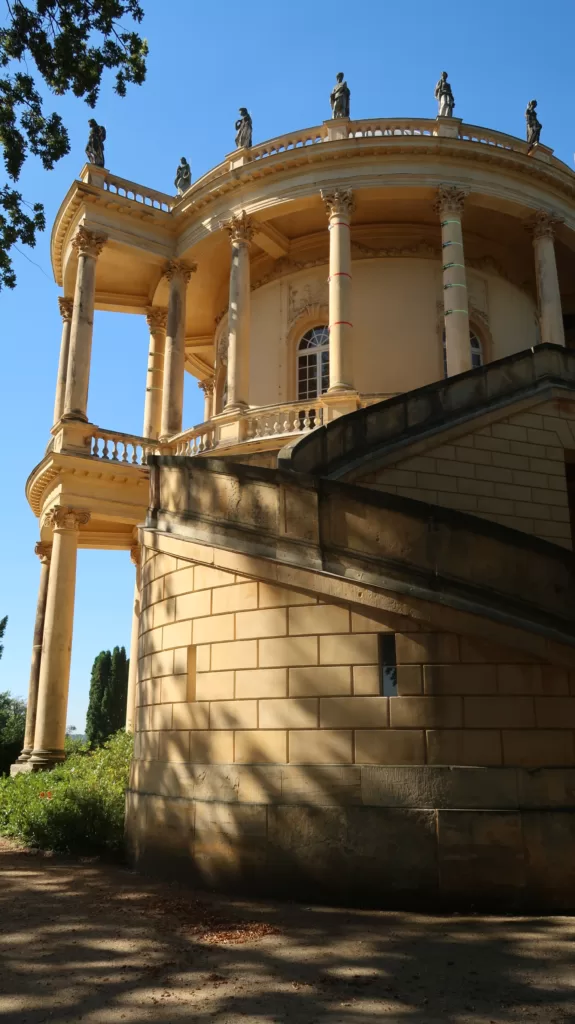
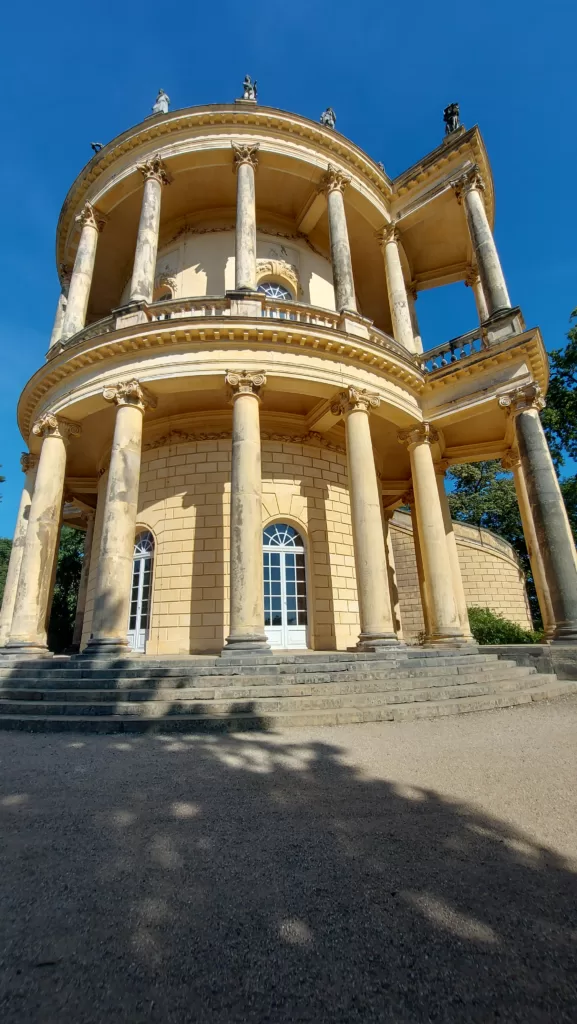
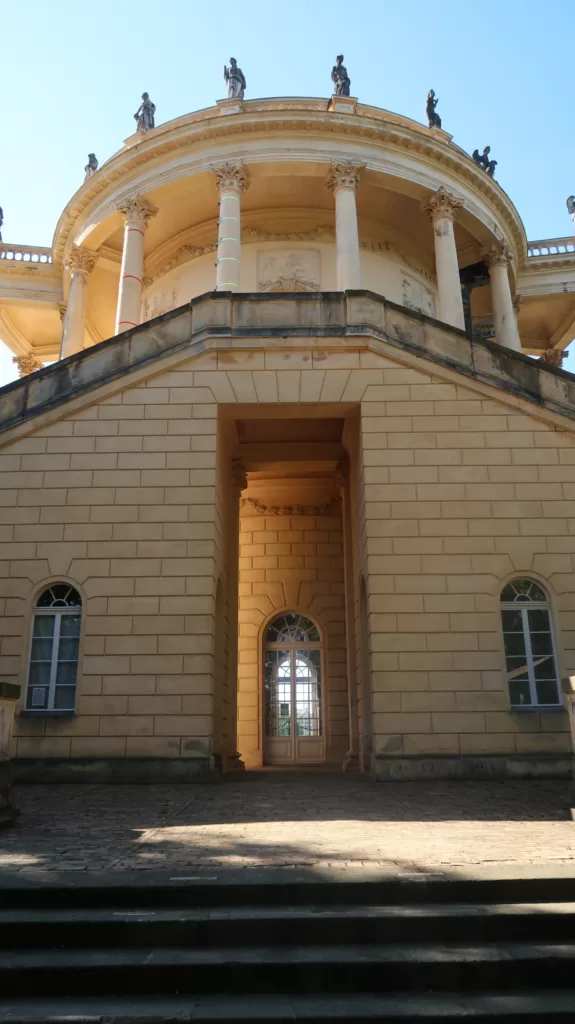
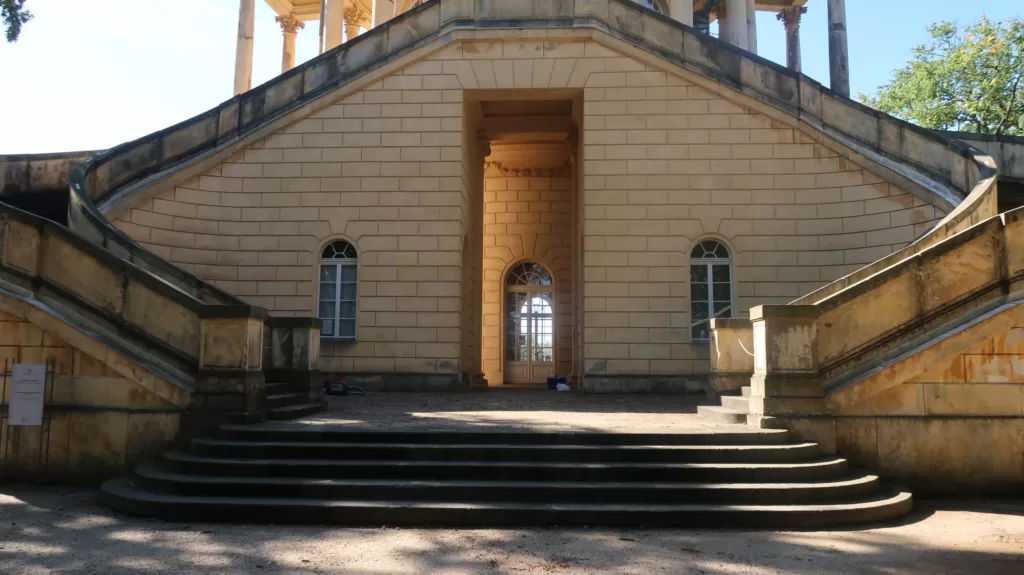
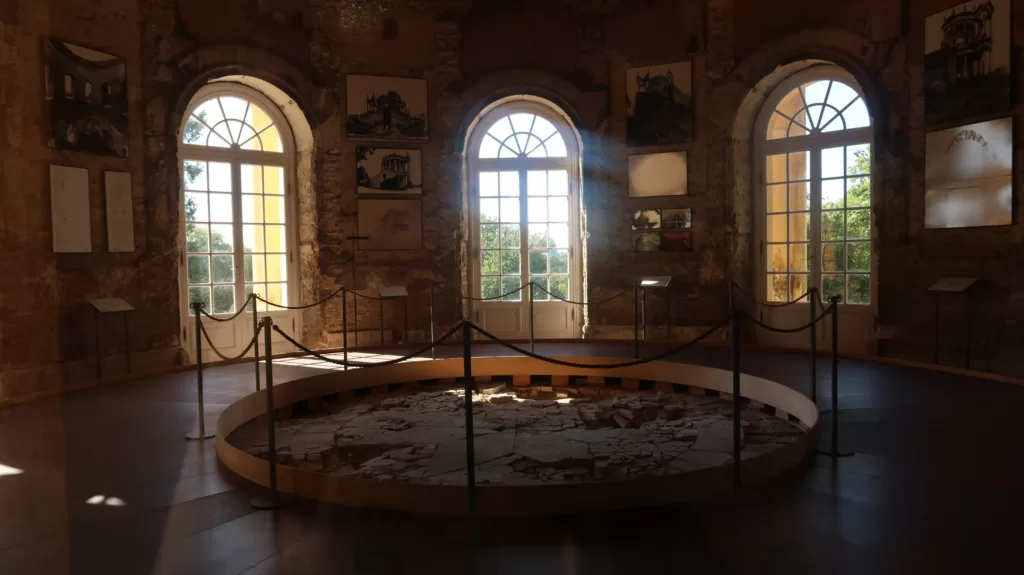
From this vantage point we could see the roofline of a large building, and thinking it was Sanssouci we headed in that direction. It wasn’t Sanssouci but the ‘New Palace’ which was built twenty years following the creation of Sanssouci. This far larger palace was in direct contrast to the relaxed ethos behind Sanssouci, and displayed Frederick’s power and strength to the world, in the Baroque style.
As you emerge from the woods this building is in a clearing with a formal garden to the front with trees and statues placed in a symmetrical formation to add to the incredible stature of the Palace. We found a seat in the shade to sit and take in the sheer scale and decoration of this ‘New Palace.’ It was surprising that so few people were here, but as we were later to discover, it’s Sanssouci that’s the main attraction here, even though this building is by far the more impressive.
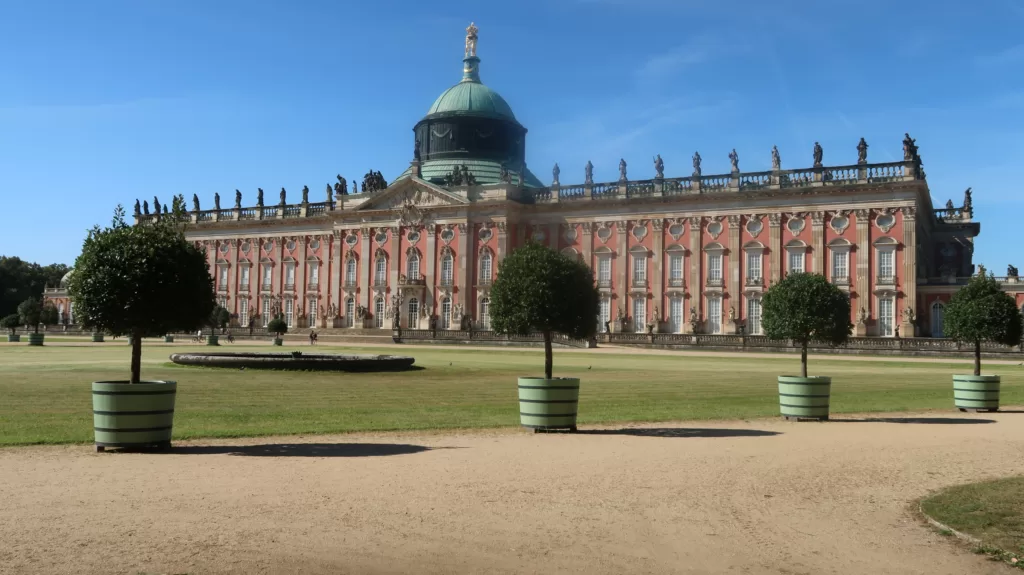


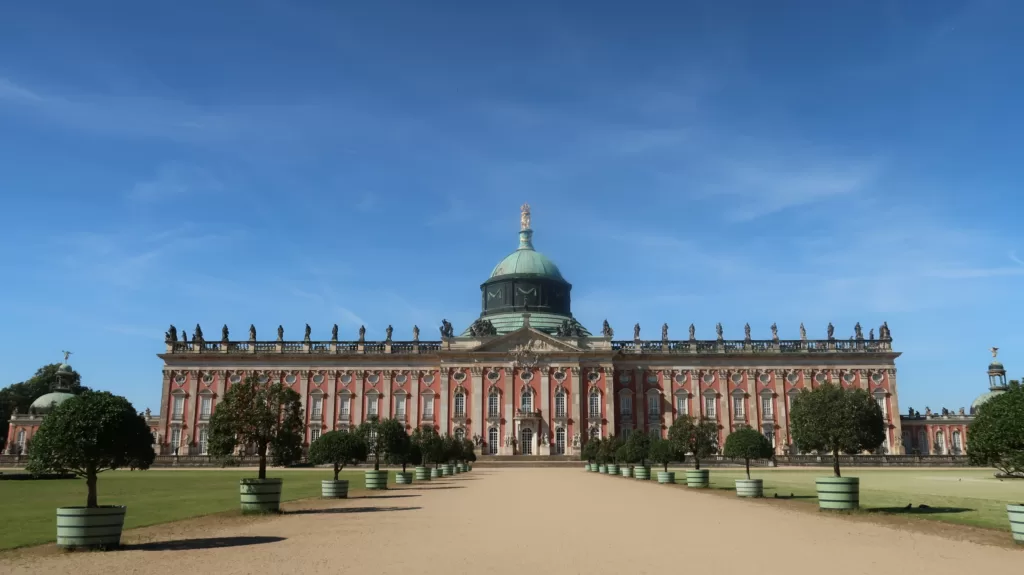
You would imagine that round the back there would be stables and other small buildings in support of the Palace but when we cycled around to see the back of the Palace, there was another incredible imposing building, the ‘Nil Studentenkeller,’ now used by the University of Potsdam.
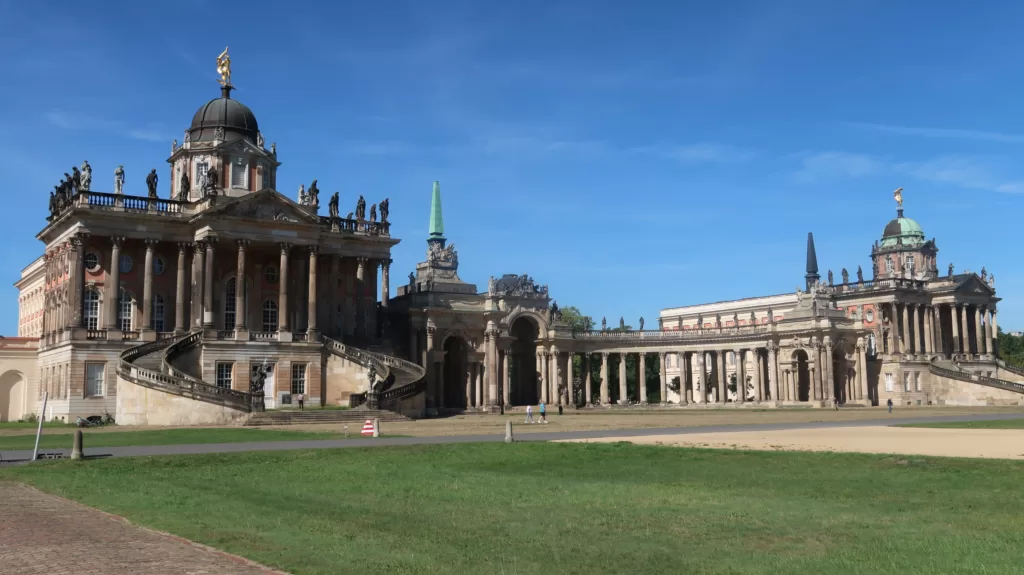
The ticket office for the Palace was nearby and we had a snack there before resuming our cycle through the grounds.
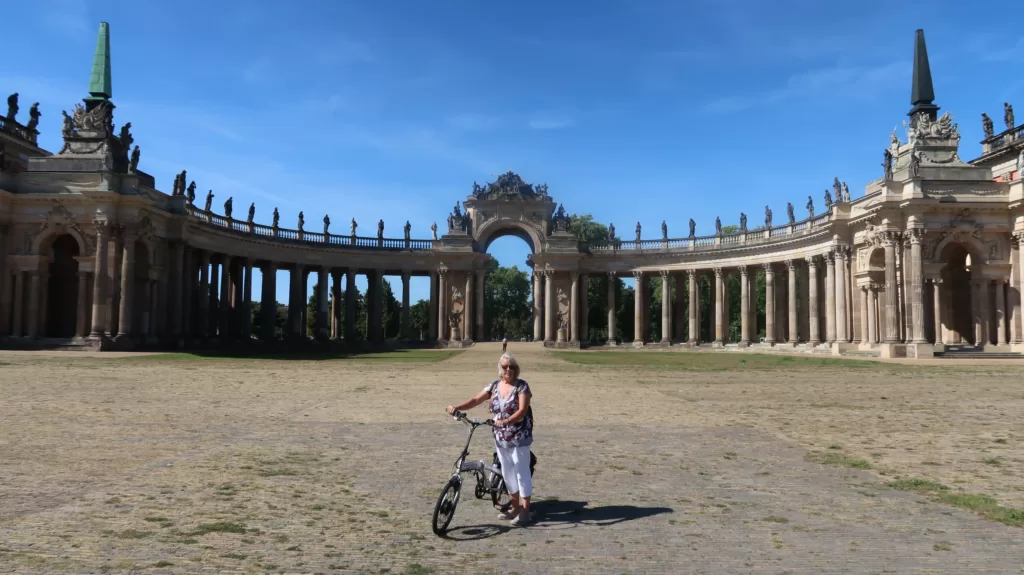
By the way, if you thought the architect had blown the budget on making the front of the New Palace as pretty as possible and the back would be not worth looking at, granted it’s not as attractive as the front, the rear aspect is still better than the front of a lot of other palaces and country houses!
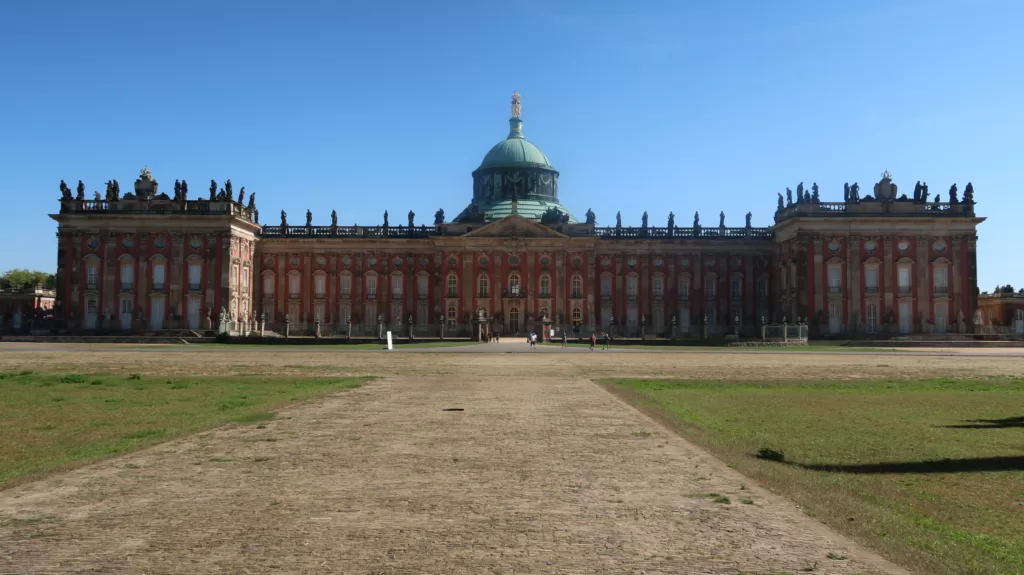
There is a long avenue through the trees starting directly in the middle of the New Palace heading towards a fountain in the distance.
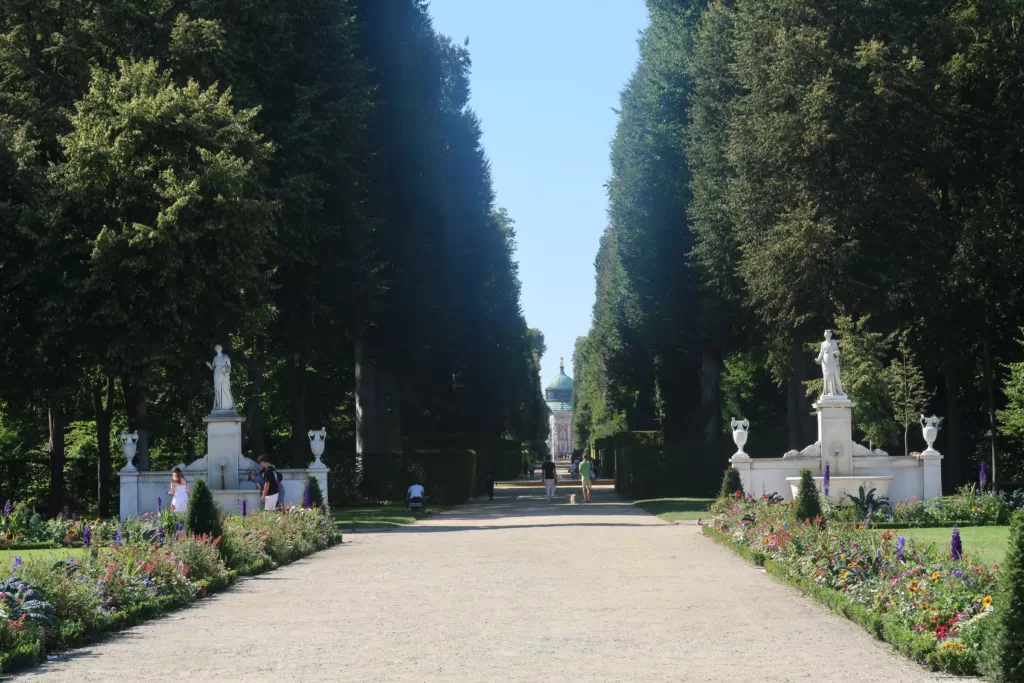
This was the location of the eagerly anticipated Sanssouci Palace and it was not to disappoint when we arrived in front of it. You can understand why Frederick preferred the more intimate Sanssouci Palace over the much larger and more formal New Palace, with the wine terrace setting the building off perfectly.

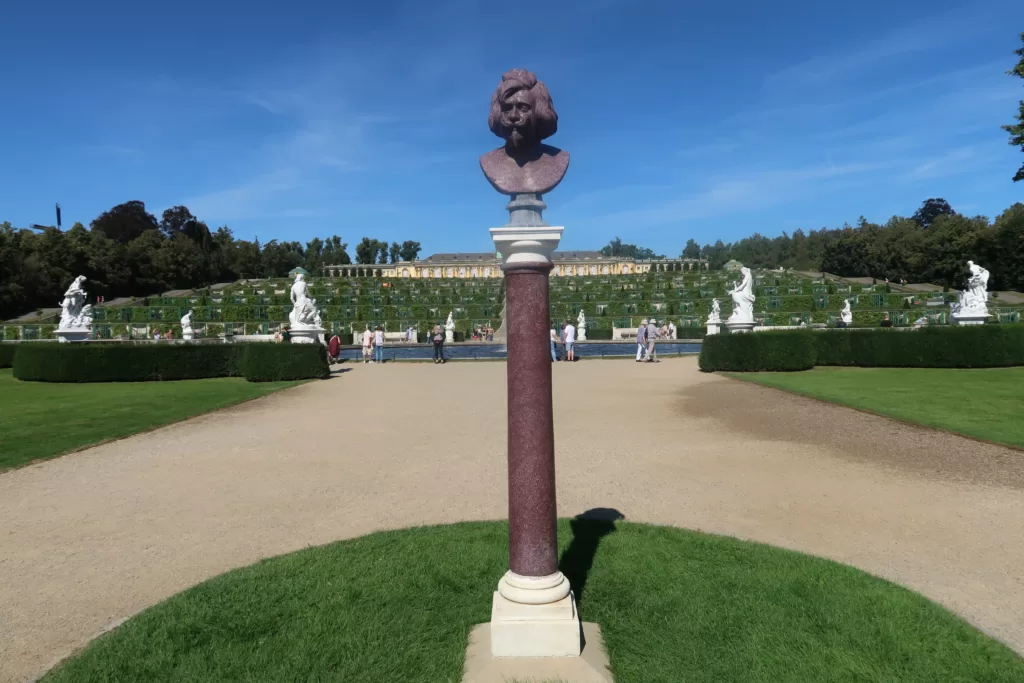
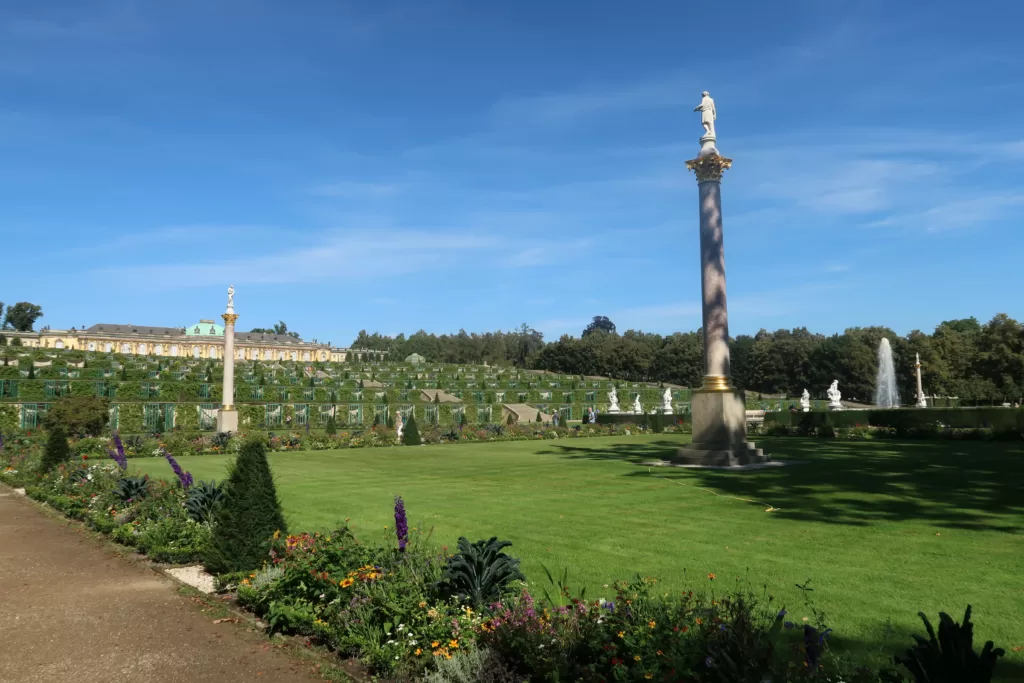
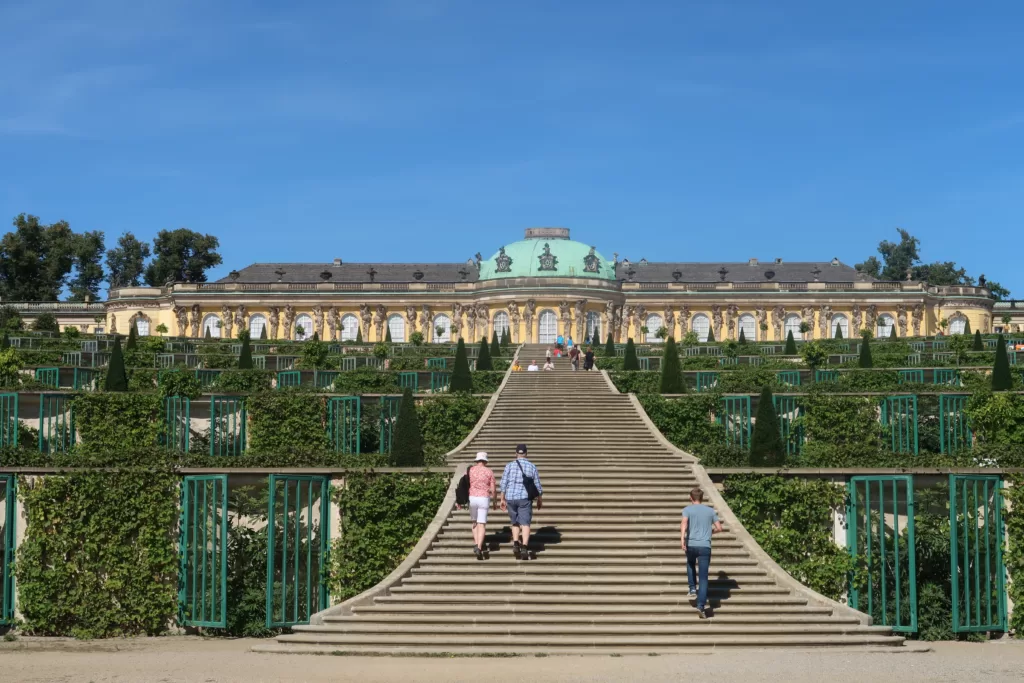
The gardens are magnificent. The terrace in front of the Palace have alternate vines and fig trees while statues, flower beds and fountains set the whole place off as befits a Royal Palace.
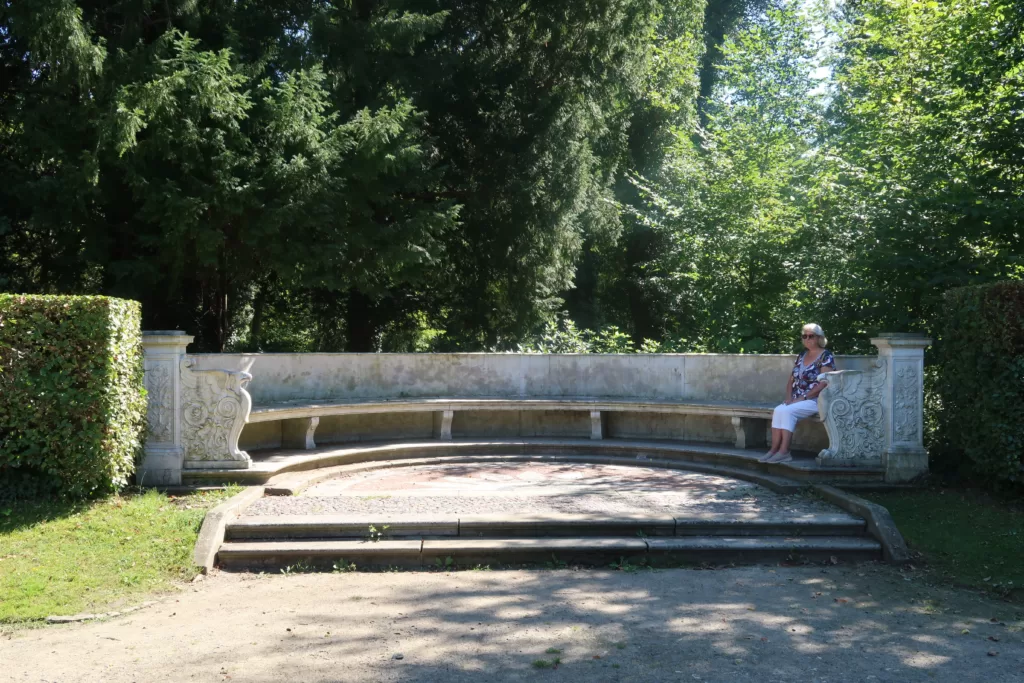
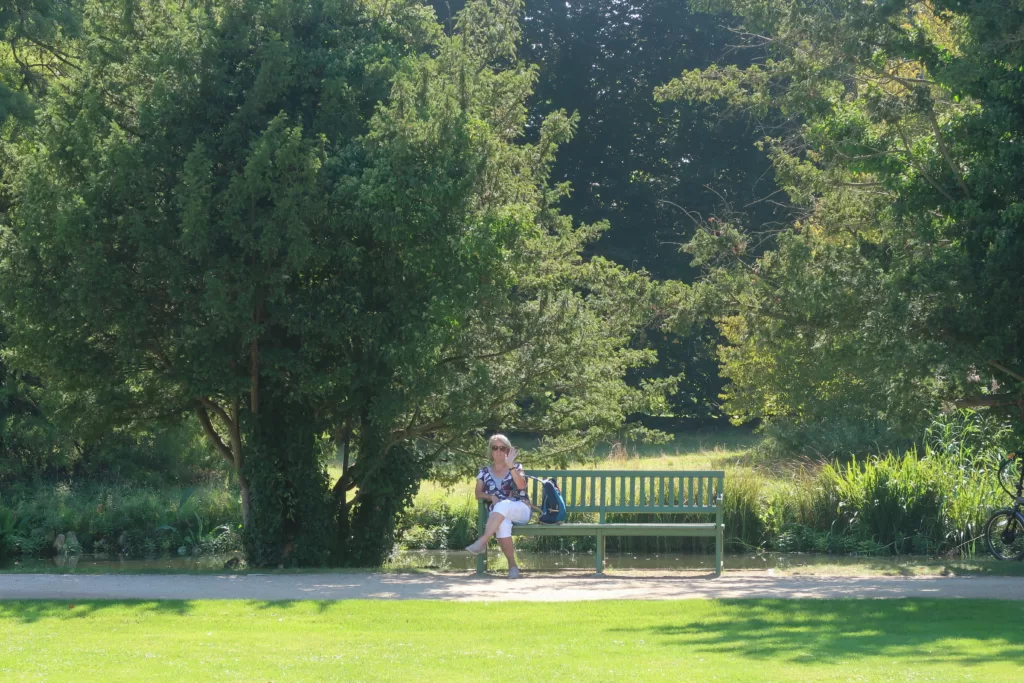
It was mid afternoon by this point and the heat was now taking its toll (how ofter have I said that!) so we set off again in the general direction of Bessie but stopped to take in some more magnificent buildings including a working windmill which was next to a small cafe where we had our afternoon cuppas.
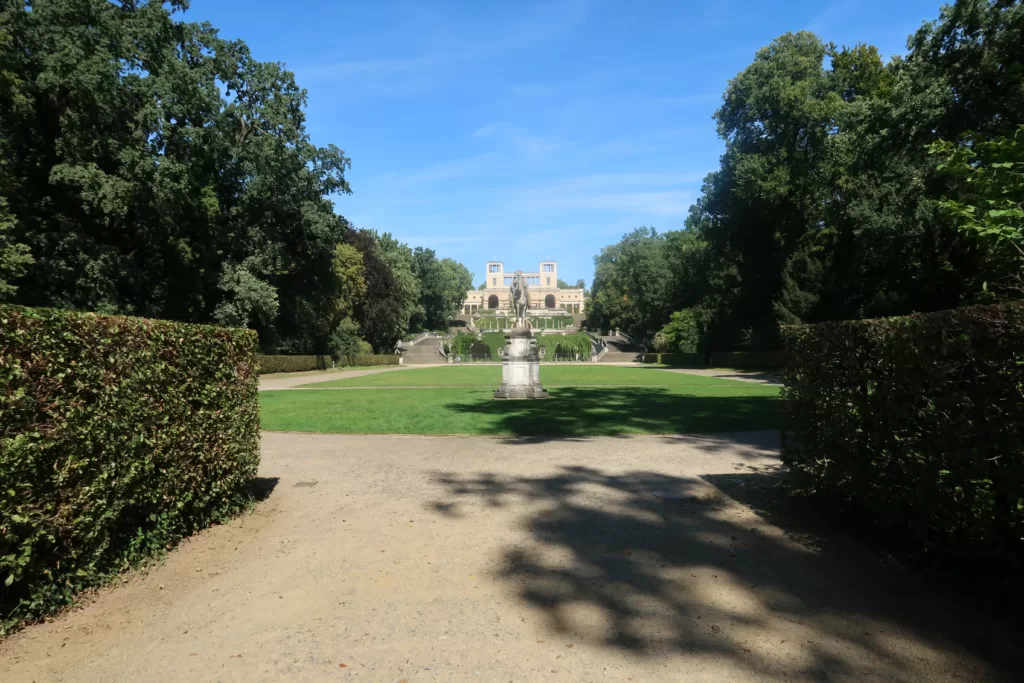
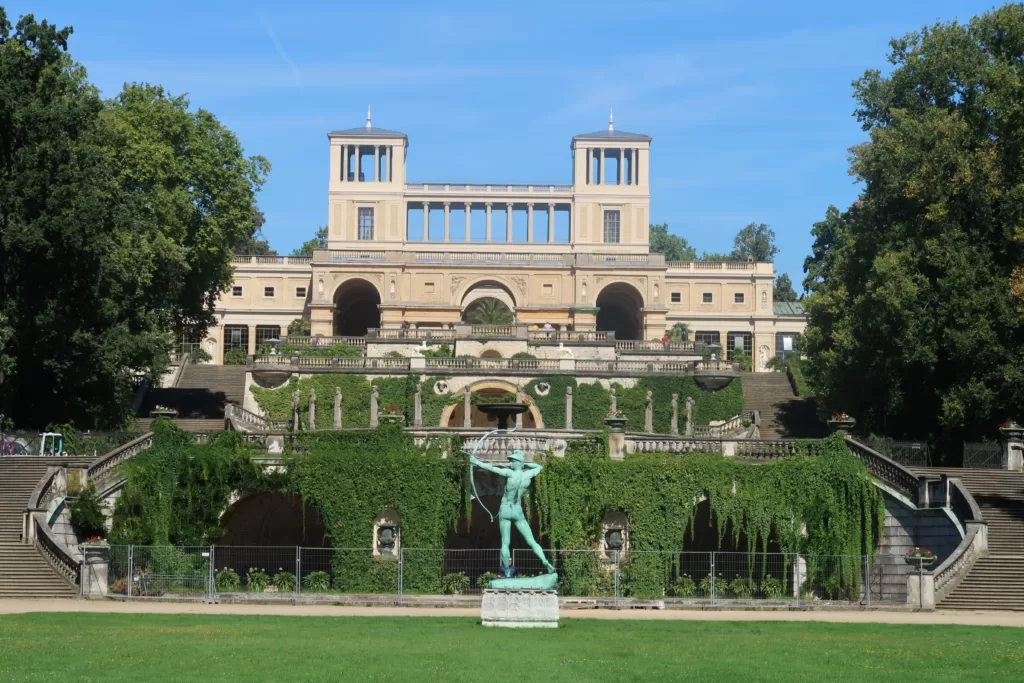
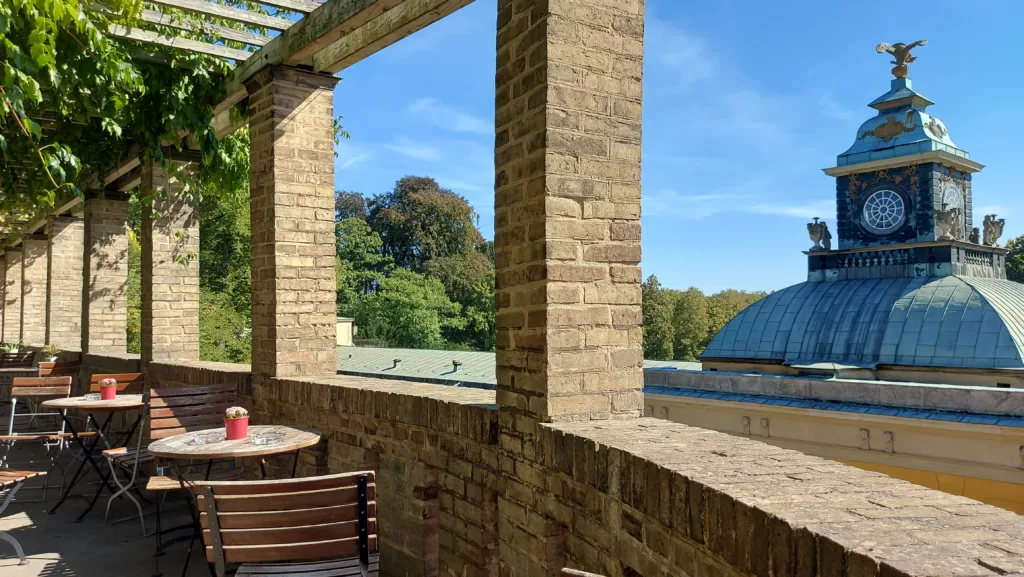
At this café no teabags were used, instead the tea was in a round metal infuser and the server did ask if we wanted milk in our tea, so we were obviously not the first Brits here, she did however make the continental error of trying to heat the milk before we schooled her in the British practice of adding cold milk to our tea. The Navigator was flagging in the heat and lack of battery power and used this as an excuse to order a cake to boost her sugar levels.

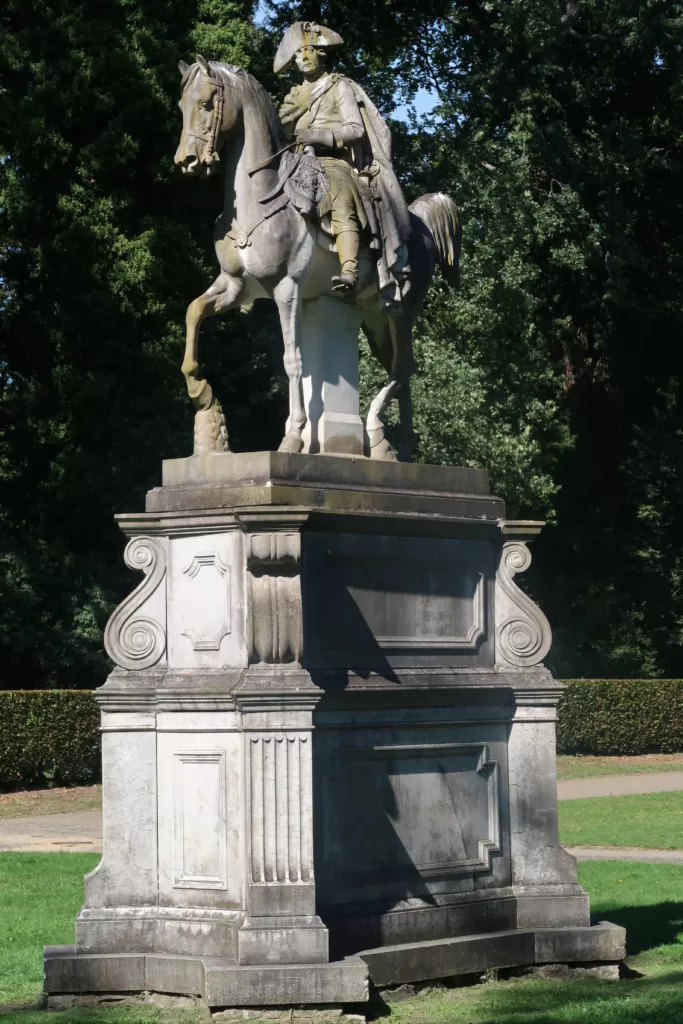
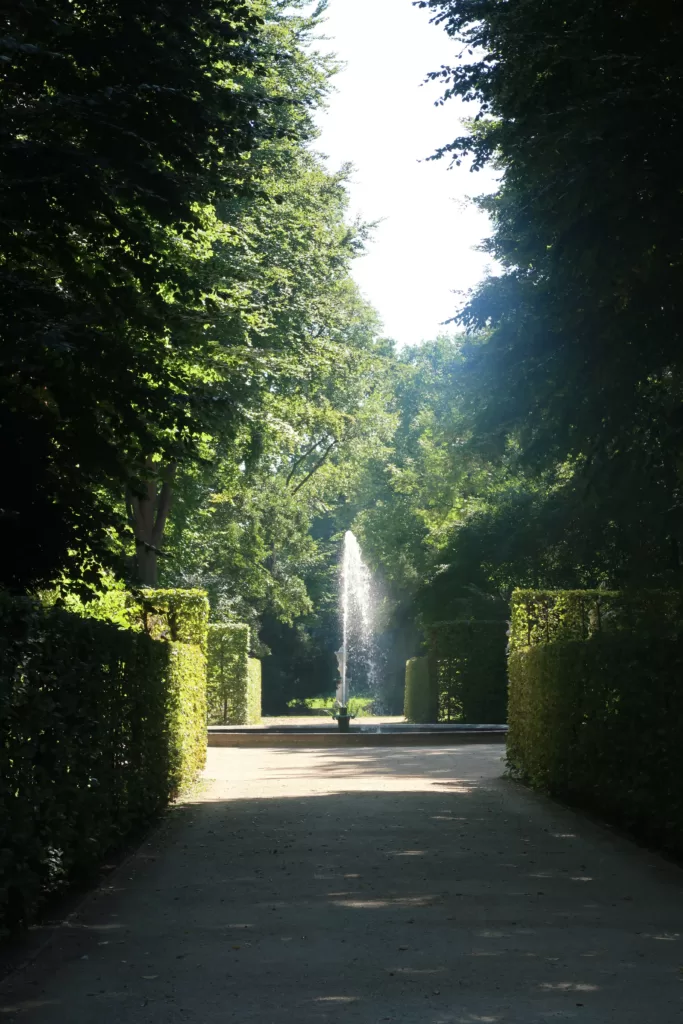
Back at the van we sat out and had our dinner before packing the bikes and table and chairs away as we have decided to move on tomorrow.
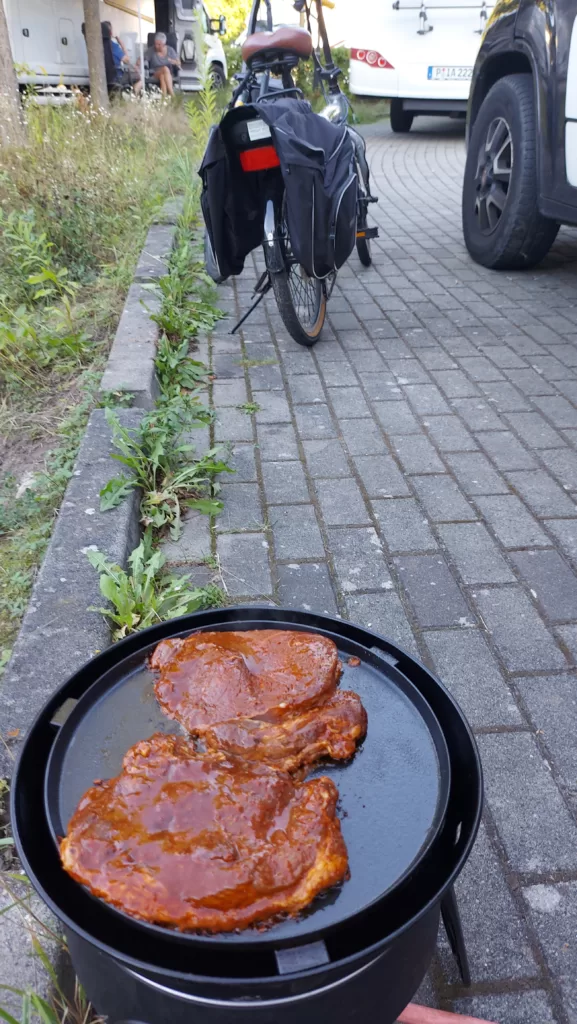
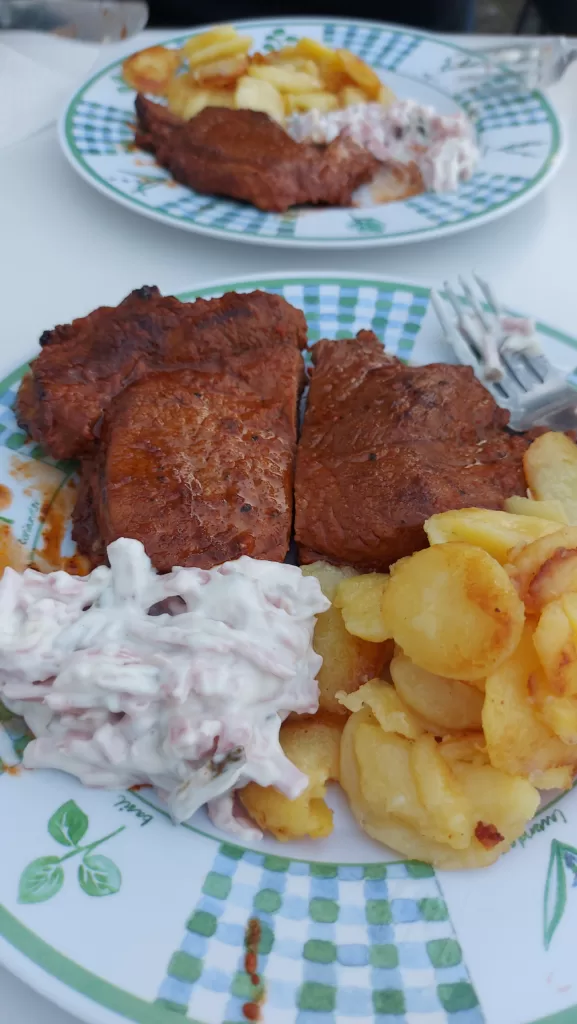
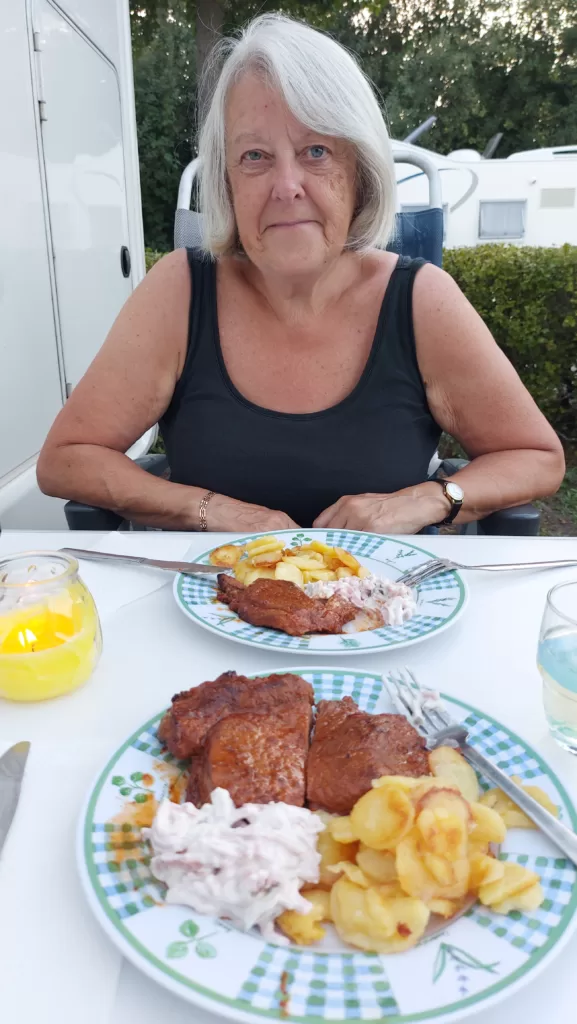
Day 66 – Friday 8th of September
Potsdam to Beelitz (again) (52.233650, 12.985010) (15 Miles)
This site in Potsdam has the potential to be a really good stopover due to its location within a few hundred yards of the Sanssouci Palace and the city centre beyond, but only having eight electricity hook ups and a payment machine that only accepts notes and coins is not ideal.
We serviced the van, without taking water on board as it will be free at our next stopover in less than half an hour from here. Today we are heading back to Beelitz again as we need to hook up to electricity to charge the bikes and allow me to work on this blog and upload the previous one, the sixth of our road trip.
Before any of that however we walked the short distance to the Norma supermarket for some groceries for the weekend. Our return ferry is in less than three weeks now so we are beginning to stockpile a few German goodies including some good value wine. Back in the day I was fortunate enough to work for two wine companies who hosted the annual sales conference in the Rhine Valley and since then I have a taste for German white wine. We were told at one of these conferences that our top selling German wine, Black Tower would be going up in price and would no longer be sold for £ 2.99 and we all thought it was the end of the world as we knew it and would be disastrous for sales, but is one of the few wine brands from the eighties still to be found on supermarket shelfs, even If it is over £ 5 nowadays.
Back at the van I got a fair bit done, as did The Navigator. At one stage there were only two vans parked up but a few more joined us as the afternoon wore on. After dinner we watched some YouTube videos and The Navigator watched Masterchef and I watched France beat New Zealand in the opening game of the Rugby World Cup.
We still have a few beautiful and interesting places to visit in Germany before heading into the Netherlands so lookout for the next blog, coming soon…
Great Christmas Gifts – Order Now!
To See The Full Range Of 2024 Week-To-View Diaries
CLICK HERE
This map shows the approximate route we have taken on this blog as part of our 2023 Road Trip…
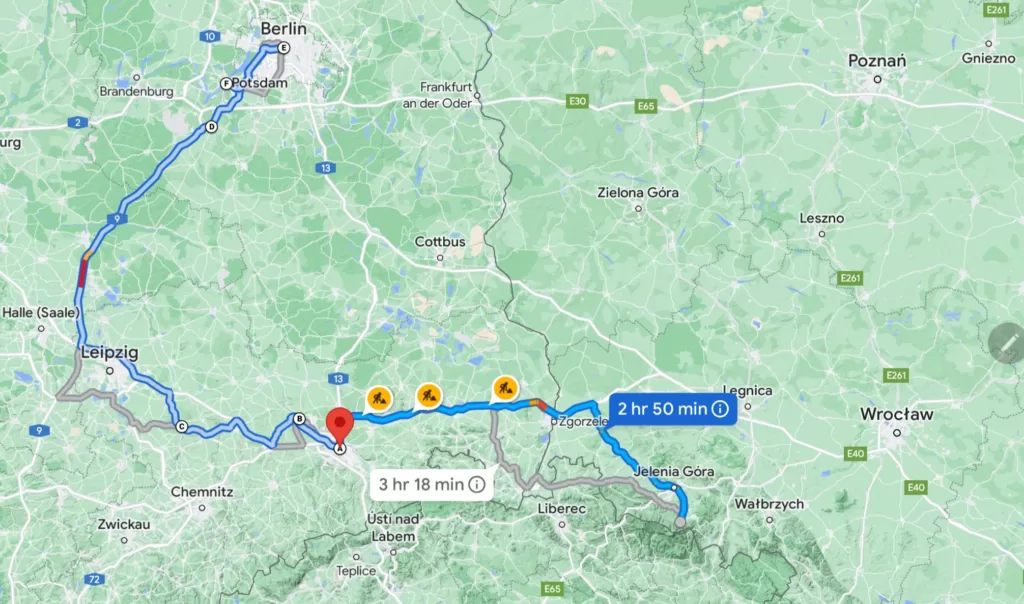
Some of the links above are affiliate links. This means that, at zero cost to you, I will earn a small affiliate commission from Amazon if you click through the link and finalise a purchase.
COMING SOON ON THE NEXT BLOG…
The next blog will be another action packed episode as we make our way slowly towards the Netherlands and the ferry back to blighty on the 27th. Before that however we have a few more cities and attractions to see in Germany…
Stay tuned, and if you are not already SUBSCRIBED sign up to be notified of the new blogs when they go online.
